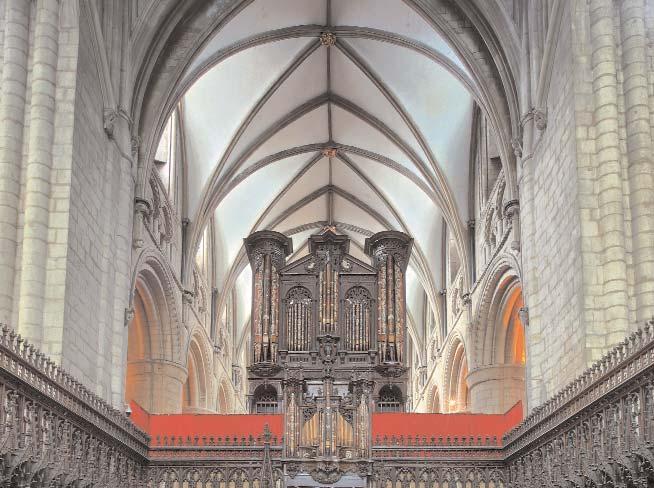Cathedral MUSIC




Designed and built by organists for organists























Simply the best in sampled digital sound, with no gimmicks. This is a Makin Westmorland organ.
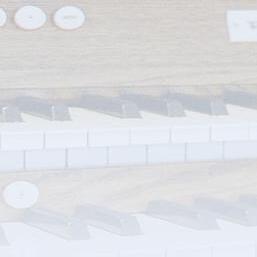

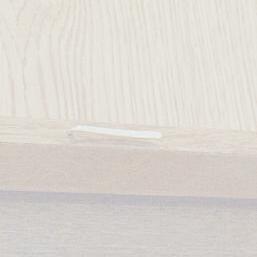


the difference. Our Westmorland Custom instruments use a separate sound-sample for every note of every rank, and the realism is simply breathtaking! You are actually listening to the sound of organ pipes themselves, and not to something artificially-generated by computer, or based on only a few individual samples. What’s more, Makin uses genuine English pipe samples, from the finest organs in the country, to create that true English sound for which we are renowned. Experience our top-quality consoles, bespoke speaker systems, and unrivalled customer service. You will soon understand why customers choose Makin, rather than settle for second-best. to us. Together we can draw up your own unique specification today. our website for customer testimonials, details of installations, events local to you, and much, much more.
Makin Westmorland. Serious organs for the discerning musician. Someone like you.















You don’t buy a Makin Organ … you invest in one.




For more details and a brochure please telephone www.makinorgans.co.uk

CATHEDRAL MUSIC is published twice a year, in May and November
ISSN 1363-6960 MAY 2010
Editor Andrew Palmer
21 Belle Vue Terrace Ripon North Yorkshire
HG4 2QS
ajpalmer@lineone.net
Deputy Editor Roger Tucker
Editorial Advisers
David Flood & Matthew Owens
Production Manager Graham Hermon
FCM e-mail info@fcm.org.uk
Website www.fcm.org.uk
The views expressed in articles are those of the contributor and do not necessarily represent any official policy of Friends of Cathedral Music. Likewise, advertisements are printed in good faith. Their inclusion does not imply endorsement by FCM.
All communications regarding advertising should be addressed to: Roger Tucker
16 Rodenhurst Road
LONDON SW4 8AR
Tel:0208 674 4916 cathedral_music@yahoo.co.uk
All communications regarding membership should be addressed to:
FCM Membership
27 Old Gloucester Street
London WC1N 3AX
Tel: 0845 644 3721
International: (+44) 1727-856087
E-mail: info@fcm.org.uk
Every effort has been made to determine copyright on illustrations used. We apologise to any individuals we may have inadvertently missed. The Editor would be glad to correct any omissions.
Designed and produced by MYPEC
The Old Pottery, Fulneck, Pudsey, Leeds, West Yorks LS28 8NT
Tel: 0113 255 6866
info@mypec.co.uk www.mypec.co.uk
Cover Photographs
Cover
Are you a tweeter? Are you on Facebook or LinkedIn? When was the last time you read a blog on the subject of cathedral music? I thought about this recently when I was asked yet again why can we not keep our choristers interested in cathedral music, once they have left their cathedral choir. We live in a fast pace social media world and we must all keep up with these innovative developments.
When I look back, there was not much that separated our grandparents from us but over the past decades, as the Internet and e-mail have taken off, there is an ever-widening gap between, for example, my 11-year-old nephew and myself.
When I was at St Thomas, Fifth Avenue, New York, last November I was struck by the opening remarks of the Rector, welcoming everyone to the office of Evensong, including, those listening and viewing on the webcast. Indeed it is happening here, as Andrew

Nethsingha pointed out on Radio 3’s In Tune; that his chapel choir at St John’s College, Cambridge, is the first to broadcast on-line. This is amazing! How long will it be before we all watch webcasts of services in our studies or living rooms? I am sure the majority of readers would find there is no substitute for the live audio-visual experience. We should recognise the power of the new media by just comparing what is available today, for example, BBC Radio 3’s Choral Evensong and the Festival of Nine Lessons and Carols from King’s College Chapel, Cambridge, with the Internet experience. If there is a thirst for television and radio, think about the possibilities we are missing. How does this all contribute to holding the younger listener?
I have not yet heard of a cathedral organist who tweats. Think what could be achieved if, on a Saturday afternoon, the message came out “Cracking Evensong tonight Howells’s St Paul’s 5.30pm at Ripon.” Or for people like me, who commentate on cathedral music, to tweat: “Another excellent Evensong at York tonight”. The beauty of a tweat message is that it is picked up by hundreds of people at the same time.
We all have to become aware of this powerful force operating. For cathedral organists and FCM, I think these multimedia social networking sites should now be recognised for their ability to communicate with younger age groups.
To what extent will this damage corporate worship? Is it too late? If not how does it all work hand-in-hand?
Some of you will argue that is damage proof because the tradition has lasted centuries. I beg to disagree. Whereas the 19th century was clearly the age of the Industrial Revolution, the 20th, the century of the car, aviation and textiles, the 21st is certainly the period of knowledge transfer and the information age, where everything has become faster and more widespread. The acme of this is the Internet, the ultimate global market, the final triumph of knowledge over physical strength, the chance to create perfect competition and high productivity across the board. The modern economy has become the New Economy.
And there is so much on offer for us to capitalise on, by developing the FCM and our field of cathedral music, so as to make it more powerful than in the Golden Age of English polyphony. We should remember that disruptive though the Reformation may have been to the liturgy, there was no interruption to musical creativity. Tallis and Byrd, for example, continued writing in the same style. Let’s strive to achieve new heights; to mix my metaphors, we cannot afford to stand at the crossroads for too long on the verge of a new dawn. In this way we may find many newcomers who have never sung in a choir or attended Choral Evensong, listening to the music.


We live in a social media world, that’s fast pace and it’s up to us to keep motivated.
CM: How did your studies at the RCM compare with those as Organ Scholar at King’s College, Cambridge?
AP: I enjoyed the Royal College of Music but my life was dominated by being concurrently Organ Scholar at St George’s Chapel, Windsor Castle, where I learned much from Christopher Robinson (FCM President) –the finest cathedral choir trainer of his generation and Christopher’s assistant, the late John Porter, who was an accompanist of genius. At the RCM I also learned much from John Barstow, my piano teacher (I was a ‘First Study’ pianist), who had me playing music I never dreamed I could such as Liszt and Rachmaninov. He kept telling me that I should “leave the cloisters and those noisy bells” and become a concert pianist! My organ teacher was Richard Popplewell, whose knowledge, repertoire and technique were immense. He had been Organ Scholar at King’s College, Cambridge, so we spent much time talking about King’s. We also did The Times Crossword together each lesson! I don’t remember learning much from the other classes but I enjoyed singing in the College Chorus under David Willcocks, from whom I learned a huge amount about dealing with large choruses.
CM: You studied with FCM Vice-President Herbert Howells. What was he like?
AP: It was a privilege to study with Herbert Howells. I found him quiet, thoughtful and occasionally passionate. I was supposed to be studying stylistics but we talked about other things most of the time. His memories of Ralph Vaughan Williams, Holst and so on were priceless. So were his written comments and reports and a note congratulating me on my awards at Cambridge. These are things I treasure.
CM: You have been out of cathedral music for sometime. How did you keep your hand in?
AP: I was out of cathedral music for 18 years. After St George’s, King’s College, Cambridge and Worcester, where I was Assistant Organist, I was ready to do something else. I had been on several cathedral organist post shortlists but had not landed a job and I was fed up! In my ‘years away’ I worked for the CBSO, playing in the orchestra, starting a youth choir with Simon Halsey, and being Associate Chorus Master (to Simon Halsey) to the CBSO Chorus. I taught at the Royal Welsh College of Music and Drama, and conducted their chorus and was Artistic Director of the BBC National Chorus of Wales, serving the Chief Conductors successively, Richard Hickox and Thierry Fischer. I also worked for Welsh National Opera conducting community operas.
During this time I kept my hand in as an organist by giving occasional recitals and making many CDs for Priory records. Although I did not ‘keep my hand in’ around liturgical issues, I missed some cathedral music but I missed no other aspect of life in the cathedral world.
CM: A wealth of experience. How has this impacted on your training of the Gloucester Cathedral Choir?
AP: All musical experience is valuable, particularly in the choral conducting world. I have been privileged to work with some fantastic musicians: Rattle, Elder, Haitink, Abbado, Otaka and I have learned from them all. I have also learned much from many singing teachers, Robert Dean, David Lowe, Hilary llystyn Jones, Miriam Bowen and so on. I try to make all of my choirs sing with a sound technique and attend to details. I am blessed at Gloucester with some bright boys, some great
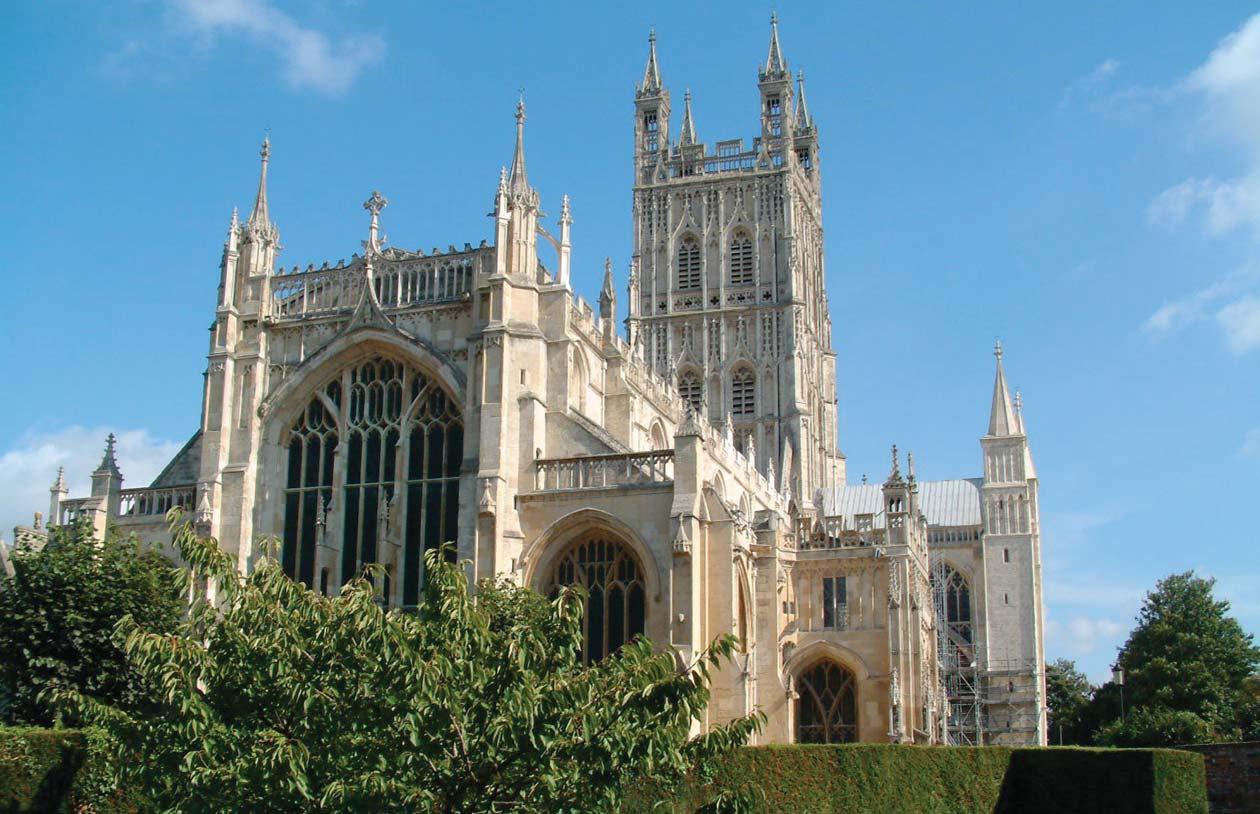
As Adrian Partington prepares for this year’s Three Choirs Festival at Gloucester he took time out of his very busy schedule to talk to CATHEDRAL MUSIC about his career.Photo © Chris Smith
lay clerks, and an acoustic which must rank with the best in the world. Good choral directing is about giving your singers confidence and discipline, but also making them feel relaxed and good about themselves. I try to make the choir at Gloucester feel comfortable but I keep raising the bar to make them achieve more. My many out-of-cathedral experiences simply help me to help them. I have started, with Simon Halsey, a choral conducting course at the Royal Welsh College of Music and Drama, which is innovative and highly successful.
CM: So why did you come back to a cathedral post?
AP: I came back to cathedral music for two reasons: to give my family more stability (I was so often working away) and secondly, to enjoy having the experience of running the Three Choirs Festival. Also, Gloucester had always been one of my favourite cathedrals, with its unsurpassable architecture, great musical tradition and convenient geographical position. I would not have been tempted to go to most other cathedrals. Gloucester is special, and the longer I’m here, the more I enjoy it.
CM: How difficult is chorister recruitment and outreach?
AP: To take recruitment first. We are all involved with the recruitment of choristers here. Most of them come from local primary schools, or are already at the King’s School. I see boys regularly through the year, and thus far there seems to be no shortage of good boys coming for audition.
Our outreach programme, of course, helps recruitment. Each term one of our lay clerks, Russell Burton and his colleagues go into a cluster of different Gloucestershire Primary Schools, occasionally accompanied by groups of choristers, to prepare the schools for a termly concert in the cathedral, at which the cathedral choir performs with, and separately from, the school choirs. It is a fantastic scheme (started by my predecessor, Andrew Nethsingha),and we are doing all we can to maintain it, now that the Government is withdrawing its financial support.
CM: Tell us about the job at Gloucester.
AP: My job at Gloucester involves me with many different things: the Three Choirs Festival, which is a huge amount of work but very exciting; Gloucester Choral Society, which gives five choral-orchestral concerts a year, and all the administration which these jobs require. I have a first rate PA, Helen Sims, who takes a lot of the strain off my shoulders, and an excellent Chorister Tutor, Bill Armiger who deals with many chorister issues. I can’t speak highly enough of my assistant, Ashley Grote, who must have claims for being the best young organist in the country, and the current Organ Scholar, Robert Dixon, who has a phenomenal work rate and maturity for a teenager.
CM: Picking up on the money side of things. What are the financial constraints you find yourself under at the moment?
AP: I think about money as little as possible, but all cathedral departments at Gloucester have been asked to make a 5% cut to their budgets. This is easily achieved and I am currently not having to compromise. We have access to some generous benefactors and trusts at Gloucester. We are not ‘flush’ with money but we are not poor, either.

CM: A question that exercises us in FCM is how can we market cathedral music?
AP: The glory of cathedral music is that it is there when people want it. I’m not sure that it needs to be ‘marketed’. I think the cathedrals themselves need to make their marketing more sophisticated, but a large proportion of the population regard cathedrals as tourist sites and wander in when they feel like it. I fear that the Church of England is not highly regarded by most of the population and until that particular tide turns, all the marketing in the world will make little difference to people’s perceptions of cathedrals or their music.
CM: So, to the Three Choirs. How is the new central Festival administration working?
AP: The new central administration of the Three Choirs Festival is the most important innovation for decades. It is making the festival more organised, more cost effective, more modern; Paul Hedley, the first General Manager is taking a lot of administrative responsibility off the shoulders of the three cathedral directors of music. Richard Hickox said to me 20 years ago that the festival needed central administration if it was to survive; and now it’s got it, and it’s brilliant.
CM: What are this year’s highlights?
AP: The highlights at Gloucester 2010 are: Elgar’s The Kingdom, Mahler’s Second Symphony , the Joubert Requiem (first performance), the 100th anniversary performances of RVW’s Tallis Fantasia and the Elgar Violin Concerto (Roger Norrington conducting),the three cathedral choirs singing Gabrieli and Monteverdi with His Majesty’s Sagbutts and Cornetts; the first concert to be given by the Festival Singers –this is a ‘Youth’ Three Choirs Chorus which I have formed to try to ensure the future of the Festival Chorus, which, whilst still very good, is rather elderly (although the average age this year is rather lower than recently!).

CM: Are you introducing anything significantly new this year?
AP: My innovations for 2010 are as follows: the Festival Singers (see above); and the shifting of the chorus rehearsals to later in the year. There has always been the practice of rehearsing from April to early July, then stopping for a month! By the time the choir reassembled for the Festival, they had forgotten much detail. This has always sent my predecessors, and my colleagues at Worcester and Hereford mad and sent me crazy at my first festival in 2008. So last year, I rehearsed the Gloucester contingent without a break and found that many Worcester and Hereford singers came voluntarily to my rehearsals. This year I am doing the official rehearsing without a break, and my colleagues are kindly doing the same. I have also increased the number of ‘massed’ rehearsals, and put these later in the year. I wouldn’t have had the courage to do this without my experience of preparing choruses for BBC Promenade concerts. The idea of the BBC Symphony Chorus having a month’s break between rehearsing and performing would be viewed as ridiculous. I am trying to make our chorus operation here as efficient as theirs! I am not popular now but have received no direct complaints, because you cannot argue with the logic of the new arrangements!
CM: You’re a busy man, what drives you?
AP: I am driven by my love of music and the need to pay twice-yearly Income Tax and quarterly VAT bills! I ‘relax’ by spending time with my five children!

Scotland’s second most senior judge has been appointed as Chairman of Council of the Royal School of Church Music (RSCM). The Rt Hon Lord Gill (68), the Lord Justice Clerk, takes up the role in the summer. He succeeds Mark Williams, a senior partner in an international investment company, whose term of office is about to come to an end. Brian Gill has had a lifelong interest in church music, ever since singing as a treble in the choir at St Aloysius’s College, Glasgow. He has subsequently held several organist positions, most recently at St Columba’s Roman Catholic Church in Edinburgh, where he and his wife run an annual music festival. He is Chairman of the Friends of the Music of St Giles Cathedral, Edinburgh. As Chairman of RSCM Council, Lord Gill will lead a team of trustees comprising experienced church musicians, senior clergy and distinguished business figures. Lindsay Gray, Director of the RSCM has welcomed Lord Gill’s appointment. “Brian brings an excellent combination of qualities; as well as his work as a church musician, he brings an extensive understanding of the music education scene, along with expert knowledge of the law and procedure as it affects charitable organisations like the RSCM.”

The Royal School of Church Music is offering organ scholarships to two young organists at the 2010 Bath Summer Course for Young People. The successful candidates will have the opportunity to play the four-manual Klais organ in the city’s splendid Abbey Church; the setting for some of the choral services. They will assist the Course Organist in playing for rehearsals and services during the popular week-long event, which is based at Kingswood School and runs from 23-29 August.
The Bath Summer Course for Young People, directed by international church musician Geoff Weaver, draws many young singers from RSCMaffiliated choirs around the UK who return year after year for its mix of specialist teaching, the chance to sing services and concerts in some lovely venues, and plenty of fun and friendship. The music-making reaches a high standard accompanied by experienced tutor and Course Organist Steven Grahl.
The scholarships will be awarded to young organists aged 16-21, at Grade 8 standard or thereabouts. “This is an excellent opportunity to learn with the Course Organist and gain valuable experience in accompanying large groups of singers,” says Sue Snell, the RSCM’s Head of Education. There will also be opportunities to direct choir rehearsals in some of the course’s wide range of repertoire. Full details of the course and scholarships can be found on the RSCM website www.rscm.com/courses or by calling 01722 424843. The closing date for scholarship applications is 14 May 2010.
The Royal School of Church Music begins 2010 with a major boost to its work: an annual grant of £100,000 is to be made by the Liz and Terry Bramall Charitable Trust for the next five years. The funding will be used to finance regional adviser posts throughout England and staff the work of the education department at the RSCM’s main office in Salisbury.
The RSCM supports and promotes church music in its affiliated churches, choirs and schools with a comprehensive range of training programmes, courses and inspirational events for singers of all ages, organists, music directors and instrumentalists. The new funding will secure an existing Regional Adviser post in the North of England, and enable the creation of three similar roles elsewhere in England; their work will include liaison with volunteer area committees and a programme of visits to affiliated churches to support musicians and clergy. In addition, the RSCM will make a new full-time and a part-time appointment in its expanding Education Department, which oversees training programmes such as Voice for Life and Church Music Skills
“This gives us a truly amazing start to the new decade,” said Lindsay Gray, Director of the RSCM. “We are hugely grateful to Liz and Terry Bramall for their splendid support, which will have a significant impact on our work, not least in enabling closer direct contact with and support for our affiliates and members in their own churches.”
The Liz and Terry Bramall Charitable Trust already funds and sponsors a number of arts organisations and events including the Leeds International Piano Competition and Opera North. Terry Bramall, who has now retired following a long and successful career in the construction industry, is a director of Doncaster Rovers Football Club. What is not so well known is that Terry Bramall himself is a lover of church music and an organist. “At the age of sixteen I was harangued by the local archdeacon into playing the organ at a nearby village church. I agreed, so long as I could choose the hymns!” His wife Liz sings in a small church choir. “Together we are delighted to support the work of the RSCM, especially when it comes to bringing young people to church music and keeping them involved. We are pleased that our grant will be used to support and enable church musicians; we know at first hand how useful and invaluable that can be.”
Three Regional Music Adviser posts will be advertised in the press and on the RSCM website in early January.
The Royal School of Church Music has launched Music Sunday 2010, bringing together a celebration of music with fundraising. Participating churches will be able to celebrate and affirm the work of their musicians, and combine it with a fundraising campaign to be split on a 50:50 basis, between the church itself and RSCM, an international charity that promotes and supports music in all styles of Christian worship. The date has been set as 13 June 2010. Music Sunday is an opportunity to give thanks for the dedication and work of church musicians, whether choristers, instrumentalists, cantors, organists, or choir directors. “Church musicians play an important part in church worship, and along with clergy they are often the ‘first-in and last-out’ on a Sunday, with a lot more preparation going on behind the scenes at other times,” says Lindsay Gray. “Music Sunday is an excellent opportunity to give thanks for the ‘craftsman’s art and music’s measure.’” Suggested prayers, readings and music for the occasion can be found on the RSCM website www.rscm.com/musicsunday. The Music Sunday campaign shares proceeds between the participating church, choir, or school and the Royal School of Church Music. The overall target for 2010 is to raise £100,000. The RSCM website includes fund-raising ideas, ranging from a coffee morning or barbecue to a music marathon or sponsored ‘sing’. There is also guidance on how to promote an event and deal with issues such as Gift Aid.

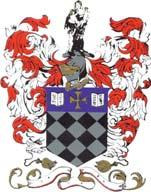
Tuesday 11 May, 2010 –5.30 pm St Paul’s Cathedral

The choirs of St Paul’s and Lincoln Cathedrals and Westminster Abbey will take part.



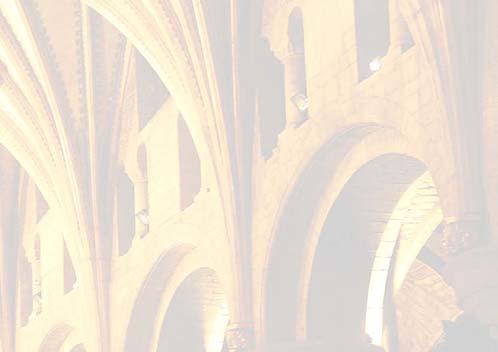
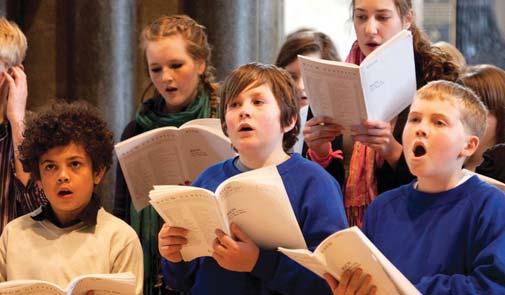
Free tickets are available on the door or from
The Registrar, Corporation of the Sons of the Clergy, 1 Dean Trench Street, Westminster, London, SW1P 3HB
Charity No: 207736

Tel: 020 7799 3696 www.clergycharities.org.uk
It is appropriate in this bicentenary year to celebrate the life and achievements of Samuel Sebastian Wesley. His distinguished career as a composer, organist and choirmaster was widely admired in his lifetime and many of his anthems have been in the repertory of cathedral and church choirs now for a very long time.

He has also been admired as a composer of hymn tunes and it is this aspect of his work that is the focus of the present article. Wesley’s most significant contribution to the hymn tune repertory is contained in the large volume that he published in 1872. The elaborate title page of this volume ran as follows:
‘The European Psalmist: Dedicated by permission, to Her Majesty The Queen. A collection of hymn tunes; selected from British and foreign sources, supplying, it is believed, music for every metre in common use in English churches. To which are added chants, an easy service, short anthems, etc, etc. The whole revised, and where necessary, rearranged, and much of the new portion composed, by Samuel Sebastian Wesley, Mus. Doc. London: Novello Boosey, Hamilton Adams, 1872, (562pp).
The massive volume contained 733 items. There are 615 hymn tunes, some settings of the Sanctus, and a large number of double chants. At the end there were some short anthems and canticle settings. Some of the anthems include music by Samuel Wesley, père.
The volume had a subscription list of some five to six hundred names, and these included many musicians, organists and clergymen. The Hereford Dean and Chapter ordered twelve copies while Winchester College requested eight. The well-known individuals who subscribed included Rev Sir F G Ouseley Bart etc, St. Michael’s College, Tenbury, Henry Willis, Organ Builder and Joseph Barnby.
Of the 615 hymn tunes in the book well over 100 were by Wesley himself. All of them were set out on four staves. This may seem a curious and rather extravagant method of presentation, but at the time it was probably thought helpful to give the alto and tenor parts of a tune on separate staves above the four-part layout underneath. The words of the first verse of each hymn were inserted in the middle. An illustration from the first item in the book demonstrates the usual plan (see example 1 above).
It will be noticed that the stems of some of the notes go in two directions when a particular note is common to two parts. It is also to be noticed that Wesley put the time signature at the head of the tunes in his book.

One or two comments may be offered with respect to certain tunes, some well known and others now long forgotten.
The famous Hereford (54, in F major) was set to a metrical version of Psalm 103 – The Lord abounds with tender love –its first association with O thou who camest from above was in the 1904 edition of Hymns A&M.




After a series of tunes in LM (1-84), CM (85-240) and SM (241-269) metres, Wesley included a selection of German chorales. Some of these appeared in more than one version,


and in one instance (425) Wesley suggested that a bar could be omitted so as to allow the tune to fit words in a different metre. The harmony of tunes that appear in more than one version is usually different and so sometimes is their metre. Landsberg, for instance, appears as an eight-line tune (295) or a six-line tune (348). The former was taken from J S Bach’s Cantata 144 where the chorale text is Was mein Gott will, das g’scheh allzeit. Wesley’s words are a translation of this text (see example 2 above).
It is perhaps surprising to find that there are three versions here of the chorale Herzliebster Jesu (325, 330 and 394) but only one of the Passion Chorale (393). By 1872, however, J S Bach’s uses of these chorales in the St Matthew Passion and elsewhere was not widely known in England.
The source of Adeste Fideles (313) words and music, has puzzled many for some time(see example 3 overleaf). I have a suspicion that Wesley was correct in supposing or noticing that the tune was Portuguese in origin. His source for it was 17th century rather than 18th and he does not refer to J F Wade, the Catholic priest who lived and worked in France for many years and who may have ‘discovered’ the tune to associate with his Latin text. The history of the tune is full of interest and may be discovered in some detail in one or two references1. In any case its origins date back to well before the 17th century in more than one form.
Two of the tunes in Wesley’s book are better known today as
the basis of two of Hubert Parry’s organ pieces. Hampton(8) is an LM tune set to words based on Psalm 139/14. ‘I’ll praise thee from whose hands I came’. Wesley’s D major tune is given in example 4. Its four staves are given in full as there are one or two interesting details to notice in its presentation if the separate middle parts are compared with the ‘score’.
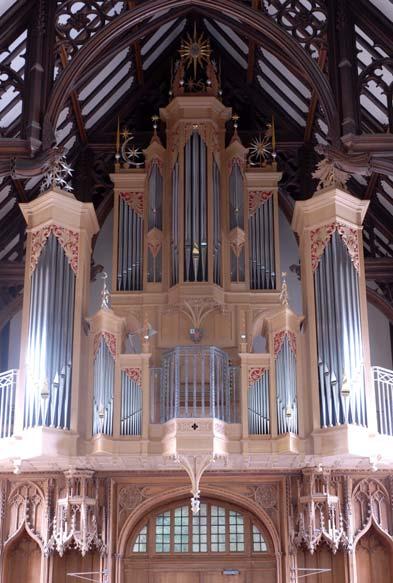


The third piece in Parry’s first set of chorale preludes (1912) is based on this melody and is in F major. Parry liked to associate the tune with the hymn O love, how deep, how broad, how high, a 15th century Latin hymn translated by Benjamin Webb that is now usually sung to Eisenach. Wesley’s fine tune has not survived in modern hymn books and Parry’s prelude is rarely heard nowadays, owing, no doubt, to the fact that the tune is not much recognised or known.
Eltham (68) is an LM tune in the unusual key of F sharp minor. Why F sharp minor? The tune was taken from


Harmonia Perfecta, a book of tunes of 1730, where it appeared in G minor with the melody in the tenor. Since Wesley’s day the tune has appeared in Hymns A&M (1904. No 322), Congregational Praise (1951 No 129) and the Anglican Hymnal (No 1965 No 156). Its presentation in lower keys in more
Grapes are blended to produce the Grand cru.
Materials and Spirit are also blended in the age-old way to produce the Grand Orgue for the discerning palate.

recent times clearly aids its use –it has now got down as far as E minor! Parry discovered the tune and used it as the basis of a chorale fantasia (1915). The tune there was quoted in F minor and associated with Watts’s hymn When I survey the wondrous cross. This splendid organ piece was much admired by Gerald Finzi, who made an arrangement of it for string orchestra (1950). Wesley’s Eltham is shown in example 5 above.
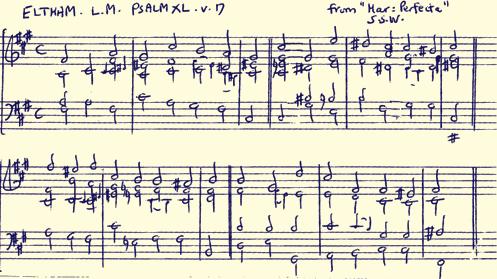
Wesley clearly spent much time and gave much thought to the compilation of his collection and its progress had been pursued over many years. As he said in his Preface, he had been asked to make such a collection ‘long ago’ and to include in it psalm and hymn tunes that were ‘most commonly used in public worship’.
His contribution to the existence and development of hymn tunes in the 19th century was substantial and his work deserves to be noticed and consulted perhaps a little more often when new hymn books and tunes are under consideration.
1See John Julian A Dictionary of Hymnology. 1892. Pages 20-22 for a discussion of what was known of Adeste Fideles up to the end of the 19th century. A more recent study is by Dom John Stephen OSB The Adeste Fideles –A Study of its Origins and Development. Buckfast Abbey Publications. (1947). Published in both English and French (42pp xiii pp of music examples). The tune existed formerly in various different forms, and there are references to its Iberian origins in Dom John’s fascinating booklet.



A short list of references in connection with some of the more important aspects of SS Wesley’s life and work:
S S Wesley. A Few Words on Cathedral Music. 1849 Reprinted in facsimile. Hinrichsen 1961b. London. 1961. 78pp with supplementary music.
E Routley The Musical Wesleys. London. 1968.
B Matthews S S Wesley 1810-1876 A Centenary Memoir. Bournemouth. 1976.
P Chappell Dr S S Wesley 1810-1876 Portrait of a Victorian Musician. Great Wakering 1977.
D Gedge The Reforms of S S Wesley. The Organ. July and October 1988 and January 1989.
Two volumes in Musica Britannica have been devoted to S S Wesley’s Anthems, edited by Peter Horton. MB 57 (1990) and 63 (1993). The latter includes versions of The Wilderness and Ascribe unto the Lord with orchestral accompaniment.

It is a rare event to be able to celebrate the musical life and work of a new centenarian, but we are privileged this year to mark, with respect and acclaim, the great achievements of Stanley Vann, who died on 27th March 2010 aged 100. William Stanley Vann –Stanley to those around him, and (daringly) ‘Stan’ to us choristers when we thought he wasn’t listening – reached the zenith of his career as Master of the Music at Peterborough Cathedral from 1953 to 1977, and my two brothers and I were privileged to experience cathedral music-making under a director at the height of his powers during the final eight years of his tenure. His time at Peterborough is rightly regarded as the period which most defined Stanley Vann as a choir-trainer, but a long and varied apprenticeship had preceded the Peterborough appointment, providing him with a host of experiences upon which he was eventually able to draw in so masterly a way.

Stanley Vann was born in Leicester in 1910, and showed early musical promise that even included some embryonic composition from the age of seven. His passion for church music, fuelled by regular church-going, gradually developed and he eventually, aged 15, became an organ pupil of Victor Thomas, who was chorusmaster for the Leicester Philharmonic. By the age of 20, Stanley had obtained his ARCM, ARCO and FRCO diplomas, and become Assistant Organist at Leicester Cathedral under Dr George Gray. Soon afterwards, on the retirement of Victor Thomas, Stanley succeeded him as Leicester Philharmonic chorusmaster, which brought him into early contact with one of the giants of English music-making, their conductor Sir Henry Wood, who by all accounts had unwavering confidence in Stanley’s ability to prepare the singers (and who had indeed requested Stanley for the post). By now it was clear that Stanley was not going to pursue a career in building and architecture with the family firm, and it was no surprise when he started accumulating directorships of various choirs himself, in particular that of organist and choirmaster at Gainsborough Parish Church in 1933, a post he would retain for six years while he also
directed the music at two Gainsborough schools (and still continued as Leicester Philharmonic chorusmaster, Sir Malcolm Sargent becoming their conductor).
This period of his life saw his marriage to Frances in 1934 and his first taste of live BBC broadcasts, with two Choral Evensongs in 1938.
A move to take up the reins at Holy Trinity, Leamington Spa coincided with the outbreak of war, and his early mechanical drawing experience led to his working on airframe drawings at the Rover car works in Coventry –though he had also found time to inaugurate the Leamington Bach Choir in 1940. Later he rose to the rank of Captain in the Royal Artillery, and suffered a perforated eardrum while involved in anti-aircraft defences on the south coast. His legendary keen ear for pitch and tuning is consequently to be considered even more remarkable, and few were ever aware of the damage to his hearing. While serving overseas Stanley conducted the Garrison Orchestra in Osnabrück, broadcast an organ recital from Hamburg on the British Forces Network and recorded an orchestral concert from Bruges.
On returning to Leamington in 1947 he founded the Warwickshire Symphony Orchestra and obtained an external BMus from London University after studying with Sir Edward Bairstow and Dr George Oldroyd (hence no doubt the frequent outings of the Oldroyd in D Communion Service during his Peterborough days). Then in 1949 he made his first permanent move into cathedral music when he became Organist and Choirmaster at Chelmsford Cathedral; even then there was another orchestra to be founded (the Essex Symphony Orchestra, of which Stanley was made President in 1990), and he was also appointed Professor at Trinity College, London, whence he received an honorary FTCL four years later. Finally, in 1953, Stanley was appointed Master of the Music at Peterborough Cathedral, a post he held until his retirement 24 years later and which would form the basis of his national and, indeed, international reputation. I think it would be fair to say that few of the UK’s cathedral musical directors of the last 50
Peterborough Cathedral Choir between 1969 and 1976, looks back over a century.
years can have had such varied and all-embracing preparation for the position for which they are most remembered; part of Stanley’s success at Peterborough was clearly due to his amazingly diverse and eclectic musical apprenticeship, and to the knowledge he gained from countless musicians, young and old, of every kind of ability under the sun, whom he encountered in sometimes extraordinary circumstances during the first 20 years or so of his adult life.
At Peterborough Stanley led a full musical life, elements of which included conducting the Peterborough Philharmonic, teaching singing, adjudicating and composing (of which more anon). But it was the Cathedral Choir that was from the outset the particular focus of his attention, especially since his predecessor Douglas Hopkins admitted to Stanley that it was, to put it mildly, in a less than satisfactory state. Stanley at once set about rectifying the situation, and one of the first things he did was to reduce the repertoire so as to concentrate on creating the ‘Peterborough sound’ which was to become so characteristic. That he had basically achieved this by the end of the ‘fifties is a tribute to his abilities, determination and vision; and perhaps Stanley was exactly the right man in the right place at the right time.

Although one of England’s greatest medieval buildings, Peterborough Cathedral in the 1950s was a provincial establishment with a situation that included some unpromising features. However historically significant, the city itself had become an industrial, manufacturing centre that had owed its expansion to the railways, and it suffered architecturally, socially and culturally in comparison with Cambridge and Ely, for example, both about 30 miles away. The Cathedral had a reputation for being one of the country’s most unvisited masterpieces, since Peterborough as a whole did not have the old-world charm of many other typical cathedral cities. These drawbacks must inevitably have dissuaded certain potential lay clerks from applying for posts in the cathedral choir over the years. The situation regarding the choristers was also potentially unpromising, as the
cathedral had no self-contained choir school as such; many choristers attended the King’s School (the city grammar school) from the age of 11, but even in my time in the early 1970s several of my chorister colleagues went to other city schools, which made things administratively less easy than at most other British cathedrals, and thus further added to the Master of the Music’s challenges. How, therefore, was he to achieve heights of musical excellence to compare with, say, King’s College, Cambridge down the road?
His solution was to turn these apparent weaknesses into strengths through a mixture of many remarkable qualities. Stanley had that ability to communicate to those around him the feeling that what he, and we, were doing was significant, worthwhile, and probably unique. The point was that this feeling was, of course, absolutely genuine: Stanley believed entirely in his calling, and basically strove to do everything as perfectly as possible: if you were singing to God, nothing less was admissible. If you sang in Stanley’s choir, you signed up to this manifesto by default –maybe consciously as an adult, or perhaps unconsciously as a boy chorister. He had spent enough years in secular life to appreciate that young boys in a bustling city were not necessarily going to spend every waking hour contemplating what they were going to sing for Evensong that night; but he was never slow to remind us of John Stainer’s habit of kneeling in the organ loft at St Paul’s before he played for a service, and we were encouraged to be on duty from the moment we arrived at the song school for rehearsal, maybe after a hair-raising bicycle race through the traffic-dense city streets (few health and safety considerations then!). If you sang a wrong note in rehearsal (heaven forbid it happened in a service!) you came to feel that it mattered for reasons that went beyond the obvious fact that it ruined that particular musical moment. One quickly came to share Stanley’s vision of the value of perfection, and a combination of leading by example and charismatic influence brought its results. Even as boys, we felt instinctively, and then empirically, that we were in the presence of a great man.
An associated quality Stanley imbued in his singers was loyalty, which manifested itself in particular in his lay clerks, many of whom stayed at Peterborough for many years. Aspiring soloists, by and large, went elsewhere and whilst some lay clerks were deservedly in demand locally for solo work, those who stayed were usually happy for Stanley to mould their voices into a choral unit designed for the building –and this remained the height of ambition for the majority. Stanley was, of course, not unaware of individual singers’ needs, and was always very generous when it came to offering visiting singers opportunities to sing with the choir; but they had to conform quickly to the exacting demands for precision, long diminuendos, and shading off at the ends of phrases to a degree that taxed even the most advanced vocal techniques. Boys, lay clerks and supernumeraries alike soon learned that a voice that stood out in any way was quickly subject to the famous Stanley glare, usually accompanied by an air-drawn ‘hairpin’ that brooked no repeat of the felony!
By the time I arrived Stanley’s method of teaching us boys was the relatively simple expedient of having probationers learn from experiencing the perfection surrounding us. There was a little bit of probationers’ ‘note-bashing’ once a week, but mostly new recruits were placed strategically between two more senior boys and learnt most of their trade from them. A few mantras from Stanley usually sufficed: head tone, precise vowels and consonants, absolutely no edge to the voice, and that inevitable shading off at the end of a phrase, particularly in the psalms which became Stanley’s especial trademark. Vocally, what he aimed for was blend: no voice was to stand out, you were all part of something greater than the sum of its parts. The words were important: diction was paramount, and to aid this Stanley insisted on bright tone; old-fashioned hootiness or anything that sounded remotely lugubrious (a favourite word) was to be avoided. It is clear that he had achieved something akin to his goal by the time John Betjeman, who used to attend Evensong incognito, wrote in his mid-1960s script for English cathedrals and their music: ‘You will now hear the choir of Peterborough Cathedral sing… and I think you will agree that they are a matchless choir.’

Although there was an underlying cautiousness about Stanley, which I’ll come to below, a mixture of necessity, pragmatism and trust somewhat belied this where the choristers were concerned. He was loath to have a boy sing full-time until he was sure he had totally absorbed the Vann ethos; on the other hand many boys came to him at the relatively advanced age of eleven, so they had to learn quickly. A result was that Stanley usually had a set of fully-fledged choristers who were smaller in number than in other cathedral choirs, and also older –average age maybe thirteen, with some fourteen and even fifteen year olds. Given his ability to mould us in his image, however, we were in absolutely no doubt as to what was required in order for the appropriate standard to be achieved. Stanley repaid this consensus by placing a high degree of confidence in his choristers; the Head Boys sometimes conducted the psalms, for instance (rather than one of the men), and for someone usually averse to any form of risk, Stanley’s liking for a lot of treble solo work was noteworthy. I think he knew the boys would just cope: we were mini-Stanleys (minivanns?)! The first live BBC broadcast Evensong I took part in from Peterborough featured Weelkes’s For Trebles service as the setting of the canticles, with two boys taking the two extensive solo parts: by any normal yardstick a risky venture, but marvellously vindicated. For
another live Evensong a couple of years later Stanley felt I could “do a job” (as football managers are wont to say; he didn’t quite put it like that) in Wise’s Prepare ye the way: at the age of 14, there was every chance my voice might have given way under the strain, but again there was no problem. This confidence in his trebles stretched at least as far back as 1961, when Stanley’s pioneering LP for Argo featured boys duetting in Dering’s Gaudent in coelis and Duo Seraphim
By the time John Betjeman was making his comments Stanley’s Peterborough choir had become a touchstone for others to be measured by. In particular, it had become known for its singing of the psalms, which for Stanley lay at the heart of Evensong. There is, of course, no one way to sing the psalms ‘correctly’, but for many Stanley’s approach to psalmody summed up his achievements: not too fast, not too slow, a feel for an overall phrase rather than a need to point each individual word; a sense of a journey yet with time to reflect (that shading off at the end of each half-line). There was to be no jerkiness, so the accompanist played through pauses and other punctuation, keeping any registration changes subtle at the half-verse, and (usually) only taking the hands off at the end of a double chant. Choir and organ naturally came in together at a change of chant. Stanley tended to see psalms as elements of a sequence, and thus the chants to a particular evening’s psalms tended to embody a satisfying sense of structure, rather than just having the feel of three or four psalms randomly tacked together. Stanley’s own chants began to make their way into the Peterborough chantbook during the 1960s; he wanted them initially to remain ‘special’ to Peterborough, and was loath to publicise them more widely; latterly, many have made their way around the country, and can be heard by now in most of our cathedrals. A small number of them have an austere, spiky quality, whereas the majority have an essential warmth and an unerring feel for form and melody, with some exhibiting a profundity that almost defies description, such as the following examples.
Stanley had always enjoyed composition, and all sorts of pieces in addition to psalm chants continued to flow from his pen, and indeed did so unstintingly during his extensive ‘retirement’. Although, in the manner of many 20th century cathedral organists, his music is essentially diatonic with elements of the English pastoral school popularised by Vaughan Williams (whom Stanley knew), it has enough individual features to lend it a distinct individuality. It is always carefully crafted, and a lifetime of working with choirs and organs of all shapes and sizes means it is always singable, playable and bears its intended performers very much in mind. That has not stopped some of his pieces being quite difficult to perform and, for singers, to tune: a liking for pentatonic colouring and enharmonic change can offer challenges to the most able performers. The quality of



Stanley’s music has nevertheless long been recognised, underlined by a plethora of publications, the sets of canticles he has written for any number of cathedrals and a host of commissions for professionals and amateurs alike. It is impossible in an article of this length to offer more than a glimpse of the scope of Stanley’s oeuvre, and a visit to www.stanleyvannmusic.org.uk will make up for the relatively brief remarks possible here. Of more than 200 available works, the following will give an all-too-brief introduction to his output. For Christmas, Jesu thou art welcome is a masterfully simple carol arrangement, and Come listen to my story a gloriously tuneful piece with an affecting treble solo and exciting organ accompaniments. General anthems include the relatively wellknown Behold, how good and joyful, with another lingering treble solo, and the more straightforward Praise to God, Immortal Praise that church choirs will find attractive. Of many settings of the evening canticles the haunting Chichester Service has recently been republished, while for many the essential Stanley Vann is his Evening Service in E minor, a modally-inspired masterpiece of minimalism that stresses the Virgin’s awe at being chosen for her divine role. Of many works for organ that Stanley wrote largely in retirement, the quiet, contemplative Choral and the al fresco Fêtes are good examples of the contrasting ends of Stanley’s spectrum. Two striking settings of the mass include the Missa Sancti Pauli for double choir, written for St Paul’s Cathedral, and the remarkable 30-minute Billingshurst Mass, scored for soli, choir and full orchestra. This last was written for Billingshurst Choral Society in 2000, and has had several performances. Its most memorable features include some lovely lyrical solo work and some well-crafted and at times impressionistic orchestration that shows how much Stanley absorbed from working on and

around the concert platform for so many years. All the above can be obtained by visiting the aforementioned website, which also gives details of available recordings.

As Stanley’s confidence that the Peterborough choir could maintain his standards of performance grew over the years, the choral repertoire gradually began to expand, and although it remained conservative in comparison with some foundations, it was by the 1970s comparable with that of most British cathedrals. It took a little longer for the repertoire of

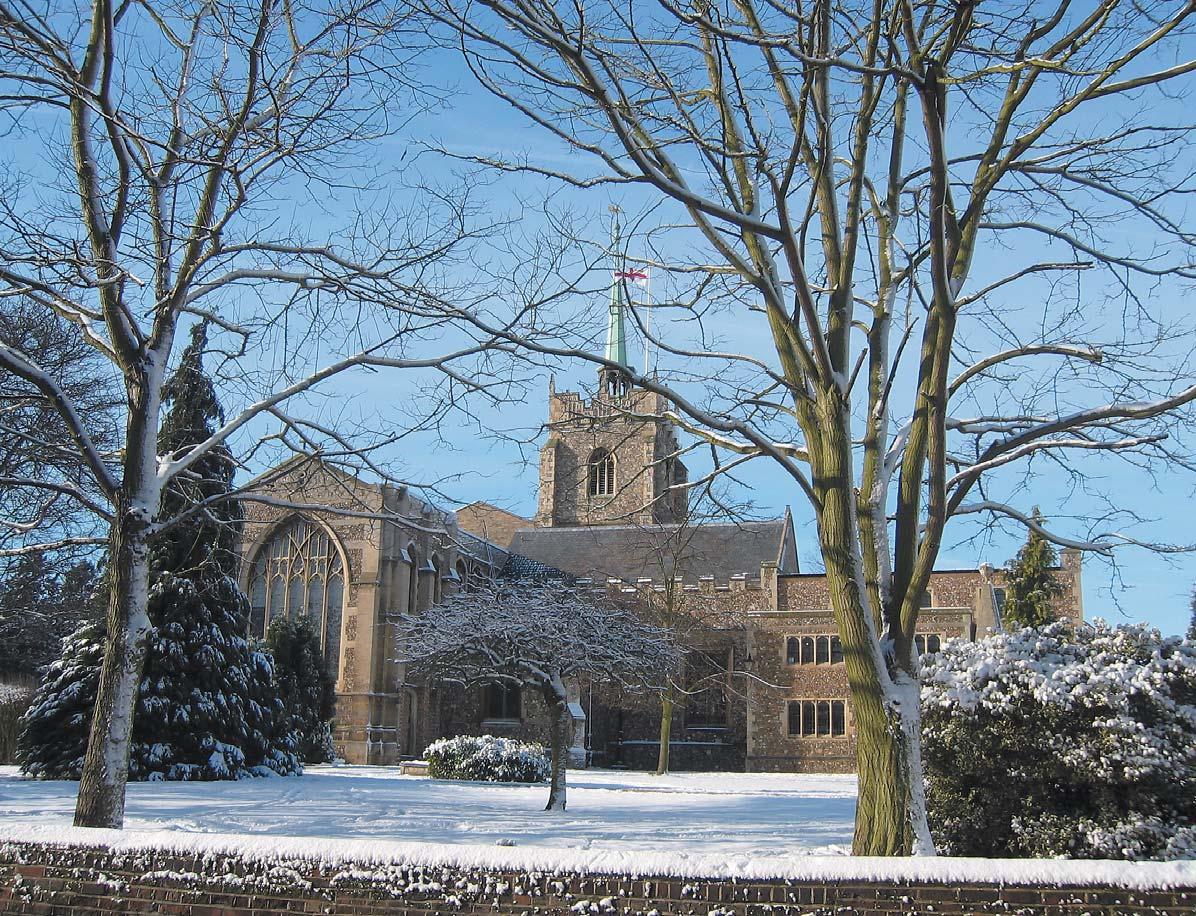
Communion settings to receive Stanley’s attention, and a rare blind spot was his barnacle-like championing of an unremarkable modal setting by Woolley that most of us would have gladly used for kindling, given the chance. On the whole Stanley was not a fan of the flamboyant occasion, and he did not perform most of the longest anthems that featured in some other places. Thus he would do Travers’s Ascribe unto the Lord , instead of Wesley’s, and preferred a small piece performed exquisitely to a long one sung unevenly. He occasionally took these precepts somewhat to extremes, especially on Mondays when there was a post-Evensong rehearsal: the Precentor would announce something like “For the anthem, O Lord, turn not away thy face by John Bull” (the piece would be barely a page long), a tiny running joke that for several years successfully evaded even Stanley’s eager antennae. On the other hand, there was innovative material, and commissions that other cathedrals didn’t do, such as Monteverdi’s Cantate Domino and Adoramus Te, Tony HewittJones’s At the round earth’s imagined corners and Howells’s through-composed anthem Thee will I love. But his cautious instincts remained, and a new piece would lie on the song school table for weeks or even months before we got to rehearse it. In particular, his preparations for BBC broadcasts were legendary: he would record his own rehearsals, and then send the assistant organist and each lay clerk a personalised checklist of minutiae to work on before the big day; details included which notes would benefit from being tuned slightly sharper, where an individual singer might sing a touch louder or softer to achieve better balance, and so on. What one can at least say is that the ends justified the means, and all his broadcasts inevitably gleaned much complimentary comment from general listener and professional colleague alike.
Although obviously a competent organist, Stanley rarely played for services, preferring to be down below directing the choir – a practice that will seem commonplace today, but was by no means universal 50 years ago. He was nonetheless a quietly effective influence in organ-playing matters, as Barry Ferguson, Stanley’s assistant from 1964-71 recalls: “He offered few bits of advice, leaving me to sort things out on my own,
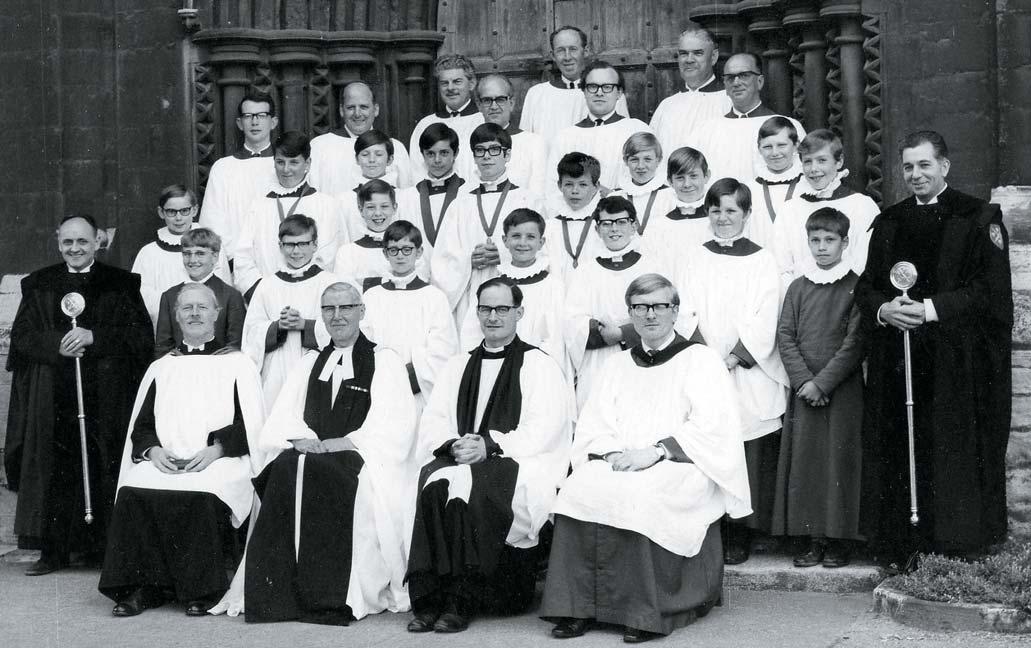
which on reflection was confidence-building and enabling for a young assistant. One was: ‘Never use the mixtures for a hymn play-over; it can muddle the ear and cloud the tune.’” Barry also remembers page-turning for Stanley when he recorded a short recital for the BBC. “His performance of Howells’s Sarabande for the Morning of Easter was confident, stirring, sonorous, full of varied colours and ebb-and-flow, and masterly in his organ management.” Douglas Fox later confided to Barry that he had heard many performances of the Lizst B.A.C.H. Fantasia, some flashy, some very fast, but none as musical as Stanley’s. A memory that stays with me is when Stanley did once play the organ for Evensong, the assistant being away: as we processed in on a dark winter evening he produced an extraordinary shimmering soundscape the like of which I have not heard before or since. Absolutely magical.
Whilst valuing the daily cathedral round, and even preferring cold February Evensongs when there might be nobody in the congregation, Stanley was also proud of notable achievements that belonged to the other end of the scale. He had directed the Cathedral Choir in many radio and television broadcasts by the time he retired, and was amongst the first to undertake foreign tours. In 1975
Peterborough Cathedral Choir was the first Anglican choir to sing High Mass in Notre Dame, Paris. He directed as many LP recordings as any other comparable choir, including a version of Stainer’s Crucifixion that remains a high watermark 35 years later. In 1972 the Archbishop of Canterbury conferred on him the Lambeth DMus for services to cathedral music (the ‘W’ on the organists’ plaque in the cathedral conveniently gave way to ‘Dr’), and in 1975 Stanley directed the music for the Royal Maundy Service in Peterborough Cathedral. On his retirement in 1977 an LP exclusively devoted to his music was recorded, which has been drawn upon in the recent production of a centenary CD featuring the current Choir of Peterborough Cathedral, directed by Andrew Reid.
Had Stanley not left us such a rich musical legacy, he would still be remembered as the quintessential English gentleman (complete with customary felt hat and umbrella). If, in a cut-
and-thrust world, “nice guys come second”, then Stanley was a glorious exception to the rule, rising to the top of his profession by being thoroughly decent, even-tempered and reasonable. If he felt the need to criticise, then he would find a way of making his point without disturbing the atmosphere. “Gentlemen, what are we doing?” was about the worst it ever got when some particularly heinous musical crime was being perpetrated during rehearsal. A remark such as ‘A pity about bar 7’ had, in consequence, the force of a devastating blow! Many found this tendency to euphemism amusing, but it was amusement born of deep affection and respect. A rare extreme moment, witnessed by both Barry Ferguson and myself, occurred after a rehearsal of Stanley’s Missa Brevis, a difficult piece full of discords, awkward intervals and tuning issues, had not gone especially swimmingly.
“What shall I do with the copies, Dr Vann?” asked Bill Lloyd, the senior lay clerk.

Came the reply: “Oh… shove ’em up a drainpipe!”
Otherwise even the most irritating moments were greeted largely with equanimity, and if anyone could transform the adequate into the well-nigh perfect by sheer force of personality, then Dr Stanley Vann was your man.
Stanley retired to Wansford, just off the A1 west of Peterborough, to indulge in music-making of various kinds, composition and setting up his substantial model railway layout. Frances sadly died in 1993, and a handful of years later Stanley moved to Richmond, Yorkshire, to be close to his family. In February this year he was treated to a 100th birthday serenade by choristers, old choristers and old friends, and Choral Evensong, featuring Stanley’s music, was broadcast on 24 February 2010 on BBC Radio 3 from Peterborough Cathedral.
On behalf of countless old choristers and music-lovers everywhere, may I offer my heartfelt thanks for the life of Dr W Stanley Vann: teacher, organist, composer, choir-trainer, officer and gentleman.
The author acknowledges with gratitude information supplied in connection with this article by Barry Ferguson and Gary Sieling (sometime Assistant Organists of Peterborough Cathedral), David Lowe (sometime Peterborough Cathedral chorister) and Martyn Vann.
22 April
A battle of three organs with the St Paul’s organists
SIMON JOHNSON
TIMOTHY WAKERELL TIM HARPER
A series of recitals by world-renowned organists

6 May HANS FAGIUS Sweden
3 June

SIMON JOHNSON
St Paul’s Cathedral
1 July
TIMOTHY WAKERELL
St Paul’s Cathedral
5 August DAVID SANGER UK
2 September
ROBERT QUINNEY
Westminster Abbey

Tuesday 22 June, 8pm
Monteverdi: Vespers (1610) with the Choir of St Paul’s Cathedral, conducted by Andrew Carwood £5, £10, £15, £25, £35
Tuesday 29 June, 8pm
Haydn: The Creation with the Orchestra of the Age of Enlightenment, BBC National Chorus of Wales, conducted by Thierry Fischer £5, £10, £15, £25, £30
Thursday 8 July, 8pm
Beethoven: Symphony No 9 with the London Symphony Orchestra, the Monteverdi Choir, conducted by Sir John Eliot Gardiner
£5, £10, £20, £30, £40
Early evening series in City churches, including ‘Discoveries’ from the BBC New Generation Artists
www.colf.org
For the latest news and special offers join our Facebook fanpage at www.facebook.com Follow us on Twitter: twitter.com/CoLFestival



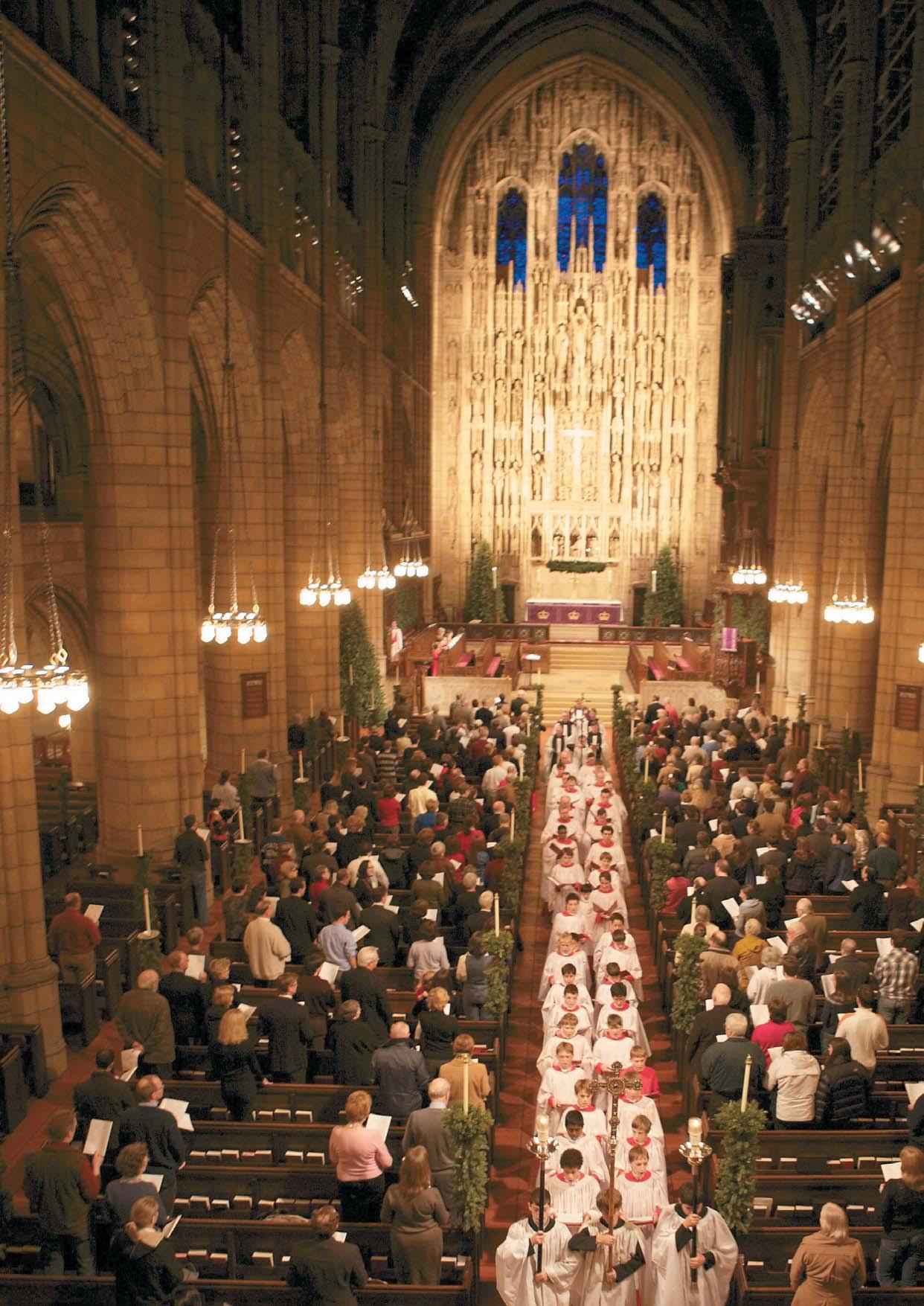
this vibrant city, one finds a haven of quiet contemplation. Close to the south end of Central Park the first thing that one notices on entering St Thomas Church, Fifth Avenue is how dark and brooding it is. Designed by the distinguished architectural firm of Cram, Goodhue and Ferguson and completed in 1913, St Thomas Church is built in the French High Gothic style, with stone ornamentation of the later Flamboyant period in the windows, small arches of the triforium, and stonework surrounding the statuary in the reredos. The flat wall behind the altar is reminiscent of some English cathedrals, and the magnificent reredos, the tallest in the world. Except for its length, St Thomas is of cathedral proportions, with the nave vault rising 95 feet above the floor.
My first visit last October before running the New York marathon was for Evensong sung by the Gentlemen of the Choir –beautifully sung in an oasis of calm and serenity. I was struck, however, by the stained glass on the triforium as it could hardly be seen and reminded me of a child’s kaleidoscope where a finger has been put over one end of it so the light cannot get through. The church has begun a huge, multi-year project to restore its 33 magnificent stained glass windows. Over the course of the next four years, each window in turn will be removed and taken to one of four chosen stained glass artisan studios for complete restoration. No daylight punctuates the church except from the doors at the west end. I was, however, here to interview John Scott.
John has been in New York for the past six years, having left St Paul’s Cathedral, so I started by asking him about the differences he found early on in the job. I certainly found some things very different here from what I had been used to at St Paul’s. The Gentlemen of the Choir were not as fluent sight-readers as their English counterparts, largely due to the fact that they had not been ‘through the mill’ as choristers. It did demonstrate to me just how special the English cathedral model is and how
the training received over four or five years as a cathedral or collegiate chorister equips children to be such fine readers as adults.
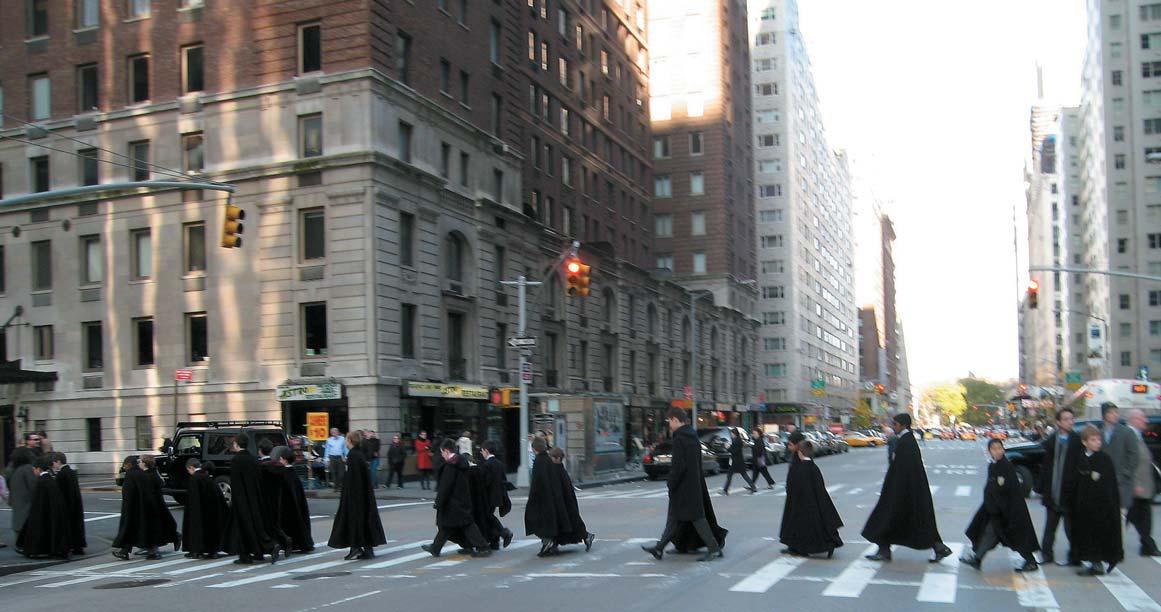

So what I inherited here was a team of mostly very fine voices but as choral singers, they were not quite as quick at reading. Fortunately, the rehearsal provision was generous –an hour before each service with the full choir (as opposed to just 25 minutes at St Paul’s) but they certainly improved during my first year. They had to, really, as I introduced something like 150 new pieces in that first year which presented them all with quite a challenge! I’m glad to say that the whole choir responded magnificently, and nothing was changed or cancelled. I also inherited a 9am full choir rehearsal in church every Saturday morning which I scrapped after two weeks as I felt I needed more time rehearsing just the boys only and working on developing the sound and securing the notes. The men were delighted not to have to come in on a Saturday morning, and we agreed that we would have a 75-minute rehearsal just for the men on a Thursday evening after Evensong, in its place. This also helped in creating a more cohesive and blended sound and building up a ‘house style’. Over the five years I’ve been here, this has certainly paid dividends.”
We have moved to his tiny office on ground level and the hustle and bustle and noise of the outside world permeates through. In fact it is like being in some American drama. On the walls are certificates and lots of music and CDs are spread throughout the study.
“My predecessor here, Gerre Hancock, did a wonderful job over 33 years, building up the choir’s repertoire and reputation. When I arrived, I felt I wanted to introduce more early and contemporary music, though there were very few obvious gaps in the repertoire. I’m very fond of the early English composers,
such as Tallis, Sheppard and Tye, so we’ve added a number of works by them. There was already quite a lot of Byrd in the library, and Gerre had even done a very fine recording of the Great Service back in the 1980s.”
With so many contemporary composers around is this a field, I ponder, that may have been neglected?
Emphatically ‘no’. We do more contemporary music now and have commissioned some composers to write works for us, such as a highly original Bright Mass with Canons by New York composer Nico Muhly, a protégé of John Adams, who also recently wrote the music for the film The Reader. We recorded Nico’s Mass on our last CD, called American Voices, along with works by Bernstein, Copland, Barber, Rorem and Hancock. Bryan Kelly has also written a Magnificat and Nunc Dimittis for us, and we gave the US premiere of Sir John Tavener’s Mass in 2008.”
What about the big oratorio works?
“We have a concert series which is supported by our Friends of Music (Patrons). We perform five or six concerts each season, presenting sacred choral repertoire which we can’t always perform liturgically. There are the annual two Messiah performances in December which completely pack the church, and Britten’s Ceremony of Carols is another feature of the Christmas season. Last season we performed the St Matthew Passion in which our own period-instrument orchestra, Concert Royal, combined with The English Concert, who were over here on tour. That was a particular highlight of my time here. In recent years, though, we’ve sung some of the cornerstones of the oratorio repertoire such as Haydn’s Creation and the NelsonMass , the Mozart Requiem and Coronation Mass as well as some rather less
well-known works. Last year, we gave the US premiere of Missa Hyemalis by Franz Xavier Richter, a contemporary of Mozart. This season we have the Monteverdi Vespers to look forward to in March, plus an all-Britten concert in May.”
In the UK the thorny issue of chorister and lay clerk recruitment never goes away, so what’s it like in New York? John Scott is proud of what he has at St Thomas.
“The boys here come from a wide geographical network though the majority are from the tri-state areas of New York, New Jersey and Connecticut. Curiously, given its population, we only have three boys currently who live in Manhattan. Some are from further afield –a few from Massachusetts, a couple from North Carolina, one from Minnesota and one from Florida. We recruit widely but it’s always a challenge, as it is everywhere these days. Each year I write to a network of churches and choir directors who have been kind enough to send us boys in the past, in the hope that they will encourage parents with musical children to send them along to audition and look at the school. The alumni (old chorister network) is also another source of recruitment, of course, and we have one boy at the moment whose father was a chorister here. We also go on tour each year, by courtesy of our concert agent, Karen McFarlane and in March we’ll be heading out to give four concerts in Texas and Tennessee. We always hope that there may be parents with young children who are attracted to what they see and hear.
These tours have always involved the full choir of men and boys, though last fall, we began a new strategy of taking just the boys out to sing. We gave three concerts of treble-only repertoire, sacred and secular and sang in schools and joined with other children’s choirs in New Haven (Connecticut) and Massachusetts. This was quite successful as a recruitment tactic, and we shall certainly repeat the format this year.” As a result, the choir is up to full strength with 38 boys in school and John says he is indeed fortunate to have such good material.
All choristers in the choir attend St Thomas Choir School, the only church-affiliated residential choir school in the United States, and one of only a handful of such schools remaining in the world. The prospectus says that St Thomas

Choir School ‘offers extensive musical training and a rich curriculum for boys in grades three through eight, with class sizes averaging just eight students’. The Choir School was close to my hotel and near Carnegie Hall and Central Park in a block purpose-built in 1988. The school was founded by T. Tertius Noble in 1919. He had been Organist of York Minster and only accepted the job in New York on the condition that the Church founded the school ‘after the ancient English cathedral model’. The St Thomas authorities agreed. “As the only church with a residential choir school here in North America I find it strangely moving to be part of this little pocket of Anglican excellence in the midst of the crazy, exhilarating city that is New York! The school has survived because the Church is very proud of its choral tradition. Over the years, parishioners have been extraordinarily generous in supporting the school through private donations. When I first went to St Paul’s, the choir school there was just for the choristers only, but that all changed in the 1980s owing to financial pressures. The Dean and Chapter felt that they had no choice but to open up the school to fee-paying day boys, who were not choristers. Of course, when this happened, the ethos of the school changed overnight, and something was definitely lost, even though the financial future of the school was secured and there may have been many educational and social benefits to having a larger school and ‘classroom dynamic’. Most significantly, though, the relationship between the school and cathedral changed overnight, and it was never the same again. I’m happy to turn to a school such as we have here at St Thomas, where all the boys in school are choristers, with a clear understanding of their role in leading the worship in church. It’s a wonderful establishment, and the Headmaster, Fr Charles Wallace and his teaching staff are all incredibly dedicated and supportive of the boys and their work in the choir. Most significantly, this is a church with a choir school, not a school with a choir.
As for lay clerks, the Gentlemen of the Choir, they are all professional singers, though New York does not perhaps offer the same opportunities for singers that might exist in London, for instance. There are fewer, smaller, mixed vocal ensembles
or specialist groups. One or two of the men have day jobs and some augment the chorus of the Metropolitan Opera, from time to time. Others have solo careers, although John points out that, unlike the UK, there is not enough solo concert work in NYC for singers.”
When vacancies arise he doesn’t need to advertise –although there is no equivalent of The Church Times but he has a deputy list, although not an extensive one. There are good fees for rehearsals and services and though he would not divulge how much the salary was, he maintains that fees are comparable to London rates, if not slightly better.
‘There are fewer choral services here; we don’t sing every day. At St Paul’s there were nine choral services a week; here there are five. At St Paul’s it was relentless: the high profile made it an exacting job, with the downside being there was just so much music to prepare. The day-to-day stuff was often not rehearsed as thoroughly as one would like, simply owing to pressure of time with the sheer volume of repertoire needed for that number of services each week. At St Thomas, the ratio of rehearsal time to performance is more generous, with the result that one can work in more detail. The schedule is more manageable, with the boys rehearsing before school from 8-9.15 every day except on Mondays. At St Paul’s we had a morning rehearsal and also a boys’ voices Evensong on a Monday, so everyone was tired after the rigorous round of Sunday services. There was simply not enough recovery time for the boys, I felt.”
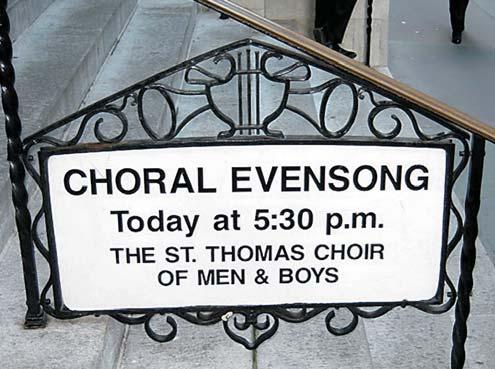
Of course, I point out that St Paul’s was unique. “Yes, St Paul’s is the nation’s cathedral and so services of national importance take place, full of pomp and ceremony, whether


of a royal nature or to do with the City of London or other institutions. There were many extra events during the course of each year and it was wonderful. There is much less of that here, for sure, so the rhythm of day-to-day liturgy is less interrupted here.”
He explains that there was never such a thing as a routine week at St Paul’s. “In my last few years in London, I’m sure the diary became busier each year, and I began to feel the frustration of yet another Evensong being cancelled owing to a special service, or sung by just the men if the boys had sung earlier in the day. Here at St Thomas, I rather like the fact that there are few variations to our liturgical routine, except in the run-up to Christmas and Easter.” John Scott appreciates this and feels that everything is more manageable, giving him the opportunity for being more creative, adventurous and imaginative with the choir’s liturgical repertoire and Church’s concert series.
I ask him does he then miss the UK?
“There are aspects of St Paul’s that I miss, certainly –the building itself, the organ, and of course the acoustic. I feel very privileged to have been part of it. It was a wonderful place to be, overwhelming in so many ways, but like all cathedrals these days, there’s the constant pressure to find new ways of reinventing themselves and to minister to a more secular age. At times, the politics of the institution were very challenging.”
Would he then go back?
“I don’t think so. I have no reason to want to go back to cathedral life in the UK, I’m very happy doing what I do here. It’s very fulfilling.”
I can’t help wondering why did he come out to Manhattan.
“Why did I come here? Well, when I was appointed to St Paul’s in 1990 to succeed FCM Chairman Christopher Dearnley, the then Dean, Eric Evans, a wise and counselled man, called me to his office and said ‘I want you to do the job’. I was only 33 at the time and I had some feeling of apprehension – was I too young and would I be up to the job? I was also worried that I might still be in post there when I was 65 which would not be right for the cathedral, the choir or me.
I aired these concerns to Dean Evans, whose reply was ‘John, this is not a job for life’. It was prudent advice.”
John continues, “I totally agreed and I told the Dean that I would give him 15 years, to which he responded, ‘That seems absolutely right’. But how come he went to New York? “Ah! The link with Gerre Hancock comes in here. He ran an annual Choirmasters’ Conference at St Thomas which was always led by an external guest director, often from the UK. It all began in 1973 with Francis Jackson and the greats like George Guest and Barry Rose who each came out eight times to direct the course. In 1998 I was invited to lead the Conference and I accepted because I had been to St Thomas once before and l remember that I enjoyed the atmosphere of the church and the liturgy. Anyway, to cut a long story short, I directed the course, despite the inevitable difficulties of working with someone else’s choir. There was a really positive atmosphere and I came away with an equally positive feeling. I was asked back again in 2003 and I found the experience even more enjoyable.
“Then Gerre announced his retirement at the end of 2003 and I was already beginning to think that the 15 years that I’d allotted myself as Organist and Director of Music at St Paul’s were almost up, and what would I do next? I really thought, well, it’s now or never, so I decided to apply. I’d always thought that New York is an incredible city, full of energy and buzz, and with a similar cultural richness to London, so I threw my hat into the ring. I was interviewed twice: the second time when I was with the St Paul’s Cathedral Choir when we were on tour in October 2003, giving a concert at St Thomas. I remember feeling very torn on the day of the interview.”
So I ask if it was like going into the unknown.
“I did not know what to expect and I was fearful of not living up to expectations. Yes, there was some apprehension on my part, but I’ve never regretted the move. It was the right time for me to do something else, and everyone here was so very welcoming and friendly.”
What of the future? Dean Evans had said there was a finite time to stay at St Paul’s, so what of St Thomas?
“I have not given myself a set time to be here; my contract does
not specify a retirement age. Will I stay here or go back to the UK when I eventually retire? Who knows? I return three or four times a year to the UK, and it’s nice to catch up with friends and family, of course. I am able to do more recital work in the summer months than previously, as we break up in the second week of June and I’m basically free until early September, which gives me the opportunity to travel and play recitals. I was on the jury of the St Albans Festival last year and I gave five recitals in Germany and four in Australia, so it has worked out well. I love living in New York – my apartment is at the Choir School with a nice view towards Central Park from one of my outside terraces. I don’t have a car, and have not driven since I left the UK, but, who in their right mind would drive in New York? Although New York is certainly iconic America, it is perhaps not like living in the rest of the States. It’s far more cosmopolitan.
I miss the BBC radio and television as well as English beer. The Anglican choral tradition in the US is still quite strong and there are many parish churches running fine music programmes. John tells me that there are several good parish church choirs singing cathedral-type repertoire in Connecticut, Massachusetts, Pennsylvania and Virginia.
Many churches in Manhattan have adult, mixed, professional choirs which are very fine – places such as Trinity, Wall Street, or St Ignatius Loyola. Like St Thomas, they are fortunate to have a financial endowment set up in the 19th/20th centuries which have been well looked after.
At St Thomas, the Church is run by the Rector who is equivalent to a Dean but there is no recourse to a chapter of canons.”
So how is the Church managed?
“The stewardship is devolved around the Vestry which consists of the Rector and clergy, and an elected body of lay people from the parish who bring commitment, experience and financial expertise from their professional backgrounds. So we have people on the Vestry like Jon Meacham, who recently won a Pulitzer Prize for his book about the wartime cooperation between FDR and Churchill; he is the Managing Editor of Newsweek magazine. Others work for great corporate institutions, such as Morgan Stanley, etc. The Vestry meets once a month and is a high-powered group of people. The meetings are dispatched with great efficiency and care. Our Music Committee meets three times a year and is essentially a support group for the matters of collective concern such as fundraising and advertising. So I can use them as a soundingboard for any concerns I may have about policy such as ticket prices for the concert series and the day-to-day running of the music department as well as future plans.”
Because St Thomas is in the heart of Manhattan, I ask where do the congregation come from?
“The congregation is mostly New York City-based but there are plenty of visitors, too, so Sunday congregations can be up to 400-500 in the summer months but there is a strong core of regulars week-in, week-out. It is a parish situation, so one gets to see the same people each week.”
Like anywhere, John still has the same administrative roles and budgets to contend with and he is as busy as he ever was. He does all the conducting and his two excellent assistants do the playing, except for the Tippett St John’s Magnificat and Nunc Dimittis which he plays for old times sake and he also
plays the voluntary after the Sunday morning Eucharist.
John also likes to give himself annual projects, so he has just played the complete works of Messiaen and in 2010 will turn his attention to the six symphonies of Vierne. In 2007 he played the complete organ works of Buxtehude on the Gallery Organ, which was built in 1996, inspired by the North European 18th-century style of organ building. He is working up to another complete Bach series.
One project that he will be fundraising for is the AeolianSkinner front organ in the Chancel, which needs to be replaced. Hopefully it will be completed for the church’s centenary in 2013. The present building, replaced the 19thcentury church which burnt down. “We have a very exciting

scheme from Dobson Organs – one of the best US builders at the present time. Everyone thinks we are well off over here but the streets are not paved with gold. Our investment was badly hit, as was everyone, by last year’s crash and I’ve had to oversee a 20% cut in the music budget.”
He does make recordings with the choir each year and I am aware that not many of them arrive over here.
“We have worked with US companies for our recordings, but the returns are low, so we’ve experimented with making CDs on our own in-house label, in the hope that the sales will eventually pay for the projects. I’m aware though that our distribution is currently limited to sales through the church website and shop. We’re looking into how this can be turned into something more global. Perhaps he should investigate iTunes. ” Quite rightly, he wants to hold on to his own product for marketing. He wants to get the choir better known worldwide and is proud that the choir has broadcast for BBC Choral Evensong
“There is still a lot to do to raise the choir’s profile and improve recruitment. This can also be helped by an occasional overseas tour. We came to the UK in 2007 and had a wonderful time. I am delighted that in 2012 we have been invited by George Christoph Biller, the 36th Cantor of St. Thomas Church in Leipzig and the 16th Cantor succeeding Johann Sebastian Bach, to take part in the celebrations for the 900th anniversary of the Choir School over there.”
One final point and an innovation, is that all the choral services at St Thomas Church can be heard via a webcast, by visiting the church website at www.saintthomaschurch.org
St Thomas is currently the only choral foundation which broadcasts all its choral services live, on-line.


As I get up to leave, I head out into a city that immediately takes you along with its frenetic pace; one becomes conscious that this church is dwarfed by surrounding skyscrapers but still manages to make its presence felt.

Age 38
Education details
Organ Scholar: Liverpool Cathedral. Foundation Scholar: The Royal College of Music.
Organ Scholar: The Temple Church.
Career details to date
Assistant Organist and Director of the Girls’ Choir, Southwark Cathedral. Instrumental Tutor at the City of London School.

What do you enjoy most about working in a cathedral like Southwark?
I was given the responsibility when I arrived at Southwark of establishing and directing the newly formed Girls’ Choir from scratch, which was a challenge. Although now, ten years on, it’s part of the cathedral’s life and weekly routine, the ongoing recruitment, development and administration without the aid of a choir school, is an enjoyable and still challenging work in progress.
What or who made you take up the organ?
I expressed an immediate interest in the instrument as a small boy when I joined my parish church choir in Kirkby, Liverpool. My choirmaster was Robert McKay who was an amazing man who taught me much and I owe him a lot. He and my parents bought me many recordings: Stephen Cleobury at Westminster Abbey; Noel Rawsthorne at Liverpool Cathedral and
Nicholas Kynaston at the Royal Albert Hall. My father once met Nicholas Kynaston after one of his recitals and said to him “He drove us mad playing your record!”
What was it like studying organ at Liverpool Cathedral and who was your tutor?
At the time, it somehow seemed ordinary. However, and with hindsight, I now realise it was quite extraordinary. My first teacher at Liverpool was the Sub-Organist, Ian Wells. He taught me on the Lady Chapel organ. Although I already knew my way around a keyboard, Ian took me back to basics. I remember being very impressed by his attention to detail, and I learnt a lot from him. After that, I moved on to the Cathedral’s Grand Organ with Ian Tracey, who, of course, needs no introduction. His flair and experience, combined with the really good grounding provided by Ian Wells, prepared me for the move to London.
You moved south to take up a scholarship at the Royal College of Music and the Temple Church studying with Dr John Birch. Can you briefly tell us about that?
I can’t imagine a better experience at that time than being taken under the wing of Dr John Birch. Not only did I study the organ with him at the RCM, being at Temple for four years gave me the opportunity to play at many important services, rehearse the choristers week by week and conduct the full choir, not to mention the wonderful four-manual Harrison organ to practise on whenever I wanted! He also afforded me many opportunities to deputise for him as organist with orchestras such as the Royal Philharmonic, and also perform at the Grand Organ at the Royal Albert Hall. To say it was quite an experience is an understatement!
Which organists do you admire the most?
All of them – especially the one I happen to be listening to at the time.
What was the last recording you were working on?
It was Benjamin Britten’s cantata St Nicolas, with the BBC Concert Orchestra and the BBC Singers and choristers of St Paul’s Cathedral, conducted by Paul Brough. It was recorded ‘live’ –video and audio and on Radio 3 –in the chapel of Lancing College, for whom Britten wrote the work.
What is your favourite organ to play?
Southwark Cathedral’s Lewis. It’s versatility never ceases to amaze me, although I wish the instrument could be heard better at the console.
Which is your favourite building?
York Minster.
What is your favourite anthem?
Among others, For Lo, I Raise Up by Stanford.
What are your favourite set of canticles?
That’s Stanford, too. The setting in C.
What is your favourite psalm and accompanying chants?
Psalm 78. All that stuff about lice, frogs, caterpillars, and grasshoppers! Any chant is fine, I’m not fussy – provided it doesn’t have too many sharps or flats, because I tend to get those wrong. Only joking!
What is your favourite organ piece?
It’s impossible to say. There are favourites that I play and favourites that I listen to. They’re not necessarily the same pieces and they change from time to time.
Who is your favourite composer?
I like the choral works of Herbert Howells. Among more modern composers, I like Judith Bingham.
Any forthcoming appearances of note?
There’s a forthcoming concert with the BBC Singers and Onyx Brass, conducted by Nicholas Cleobury. We’ll be performing new works commissioned from contemporary composers by the John Armitage Memorial Trust.
Have you played for an event or recital that stands out as a great moment?
I was recently involved in a live Broadcast on 3 performance which included the Grand Messe Solenelle by French Organist Thierry Escaich, and a new work by the English composer Gabriel Jackson. Both are for two organs and choir, with the other organist being Iain Farrington. David Hill conducted the BBC Singers with both composers in the audience.
How do you cope with nerves?
I discovered that I only get nervous when I’m under-prepared. Proper preparation is therefore the answer.
What are your hobbies?
I’m quite interested in wine collecting – although the bottles don’t seem to ‘collect’ for long!
Do you play any other instruments?
I used to play the trumpet.
What are your favourite radio and television programmes?
I listen to the news whenever possible and catch Choral Evensong from time to time. I do like to watch wildlife documentaries.
What newspapers and magazines do you read?
Whatever I find on a train seat. I don’t read anything regularly.
What makes you laugh?
Lots of things. You need a sense of humour in this job. I confess to liking short, quick gags.
If you could have dinner with two people, one from the 21st century and the other from the past, who would you include?
Alan Bennett and Benjamin Britten.
As an FCM Council member what do you think should be the role of the FCM in the 21st century?
I totally agree with a statement in a previous FCM Magazine by Alan Thurlow. He said –and I’m paraphrasing –that the FCM should be ‘its friends’, regardless of however or whatever cathedral music turns out to be. But I’d add that FCM shouldn’t preach only to the converted. It should, and does, reach further afield, spreading the message through technology such as the Internet, social networking websites, and e-mail.
Former Beverley Minster Organist Alan Spedding spent a day in Durham with Mark Venning, who has recently retired after thirty-seven years with the organ builders Harrison and Harrison, a firm connected with many of our great cathedral organs. The firm is also a corporate member of the FCM.
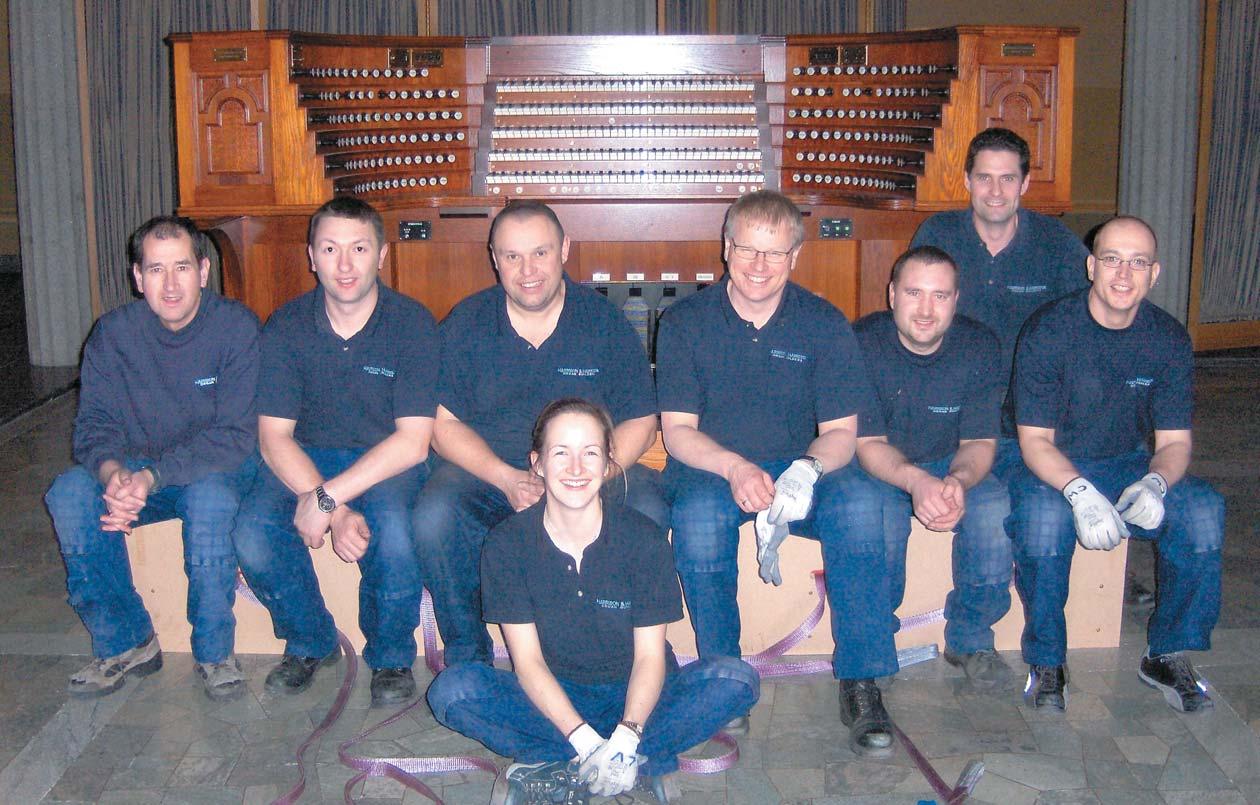
Thus it was that, one chilly morning in January, I arrived at Durham station with its spectacular view across the city, the magnificent cathedral dominating the skyline. After greeting me warmly, Mark drove us straight to H & H’s works in the former mining village of Meadowfield, whose parish church houses an unaltered Harrison organ of 1882. The firm has occupied its new building since 1996 and clearly a great deal of thought went into designing the layout. The central area provides an airy, lofty space suitable for assembling a large organ. Care has been taken to allow as much natural light as possible into the works, providing a comfortable atmosphere. The various workshops are arranged around a central atrium. The office staff are included as part of the team and their premises on the first floor look down into the workshop. The firm is able to make all the component parts of an organ from the raw materials, wood, leather and metal, and follow the process through to the final erection, voicing and finishing all in one building.
The workshop hummed with purposeful activity. It is always a pleasure to converse with dedicated craftsmen and the team members I met clearly love their work. The relationship between staff and management is based on mutual respect. One of the main projects in hand is the new organ for St Edmundsbury Cathedral –the old organ was being taken down on that very day. On the computer in the drawing office I was shown the designs for the new cases based on sketches by Stephen Dykes Bower which will complete the major reordering of the cathedral.
After a fascinating tour, we returned to Durham via the former workshop near the city centre, now converted to dwellings and offices and appropriately named ‘Harrison House’. The original first-floor crane has been retained as an external feature. It is a sobering thought that many of the world’s most important instruments have been lowered from that first-floor workshop in sections onto the pavement below. Thomas Harrison founded the firm in 1861 in Rochdale,
moving it to Durham City in 1872 and it came to the forefront of English organ building in the early twentieth century with the building of the organs in Durham (1905), Ely (1908) and Wells (1910) Cathedrals –all controversial in their day.

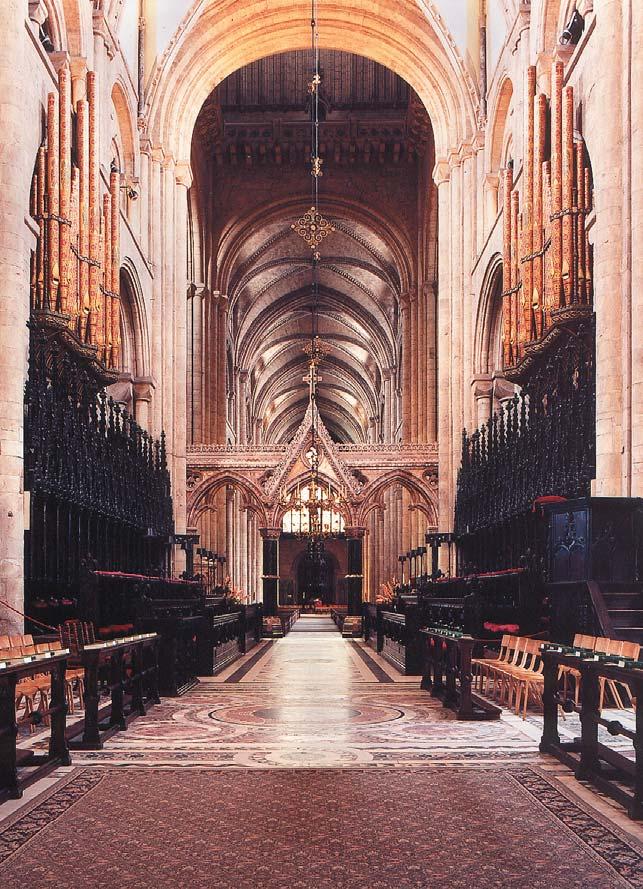
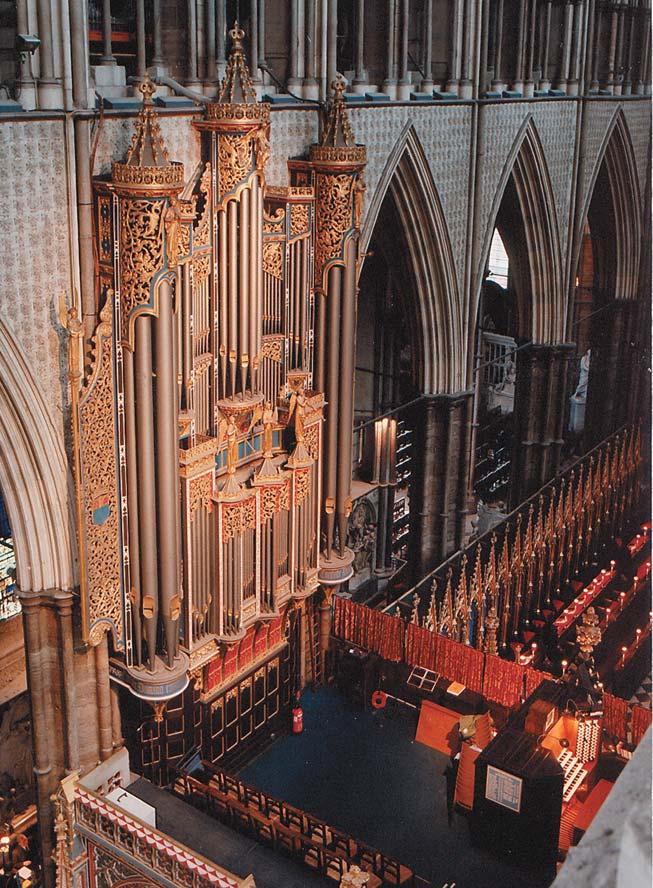
Katherine Venning, herself now retired as H & H’s Administrator, gave us an excellent lunch accompanied by lively conversation in the dining room of their delightful house in the shadow of Durham Cathedral. After lunch Mark and I talked about his career until Widget, the family dog, demanded a walk along the river bank below the house.
Mark Venning’s interest in the organ was aroused as a child in Wiltshire, where the village church had a fine 1854 Walker. While at Winchester College, he and a fellow pupil built an organ in the school workshop, about which he is very modest but which must have given him an insight into the technical aspects of the organ. He was fortunate in having organ lessons from Hans Klotz of Cologne who gave him a disciplined grounding, insisting on meticulous fingering, which has stood him in good stead. After Christ Church, Oxford, where he read
Greats, and had lessons with John Webster, among others, he furthered his musical studies at the Royal College of Music. He then took up a teaching post at Felsted School in Essex.

While at Felsted he spotted an advertisement in The Times for an assistant to the Managing Director of H & H who would succeed to the post on the latter’s retirement. He was interviewed by Cuthbert Harrison who offered him the job, which he turned down at first. After a short period in another school post, however, the call of Durham proved irresistible: he re-applied and was appointed to H & H where he took up his duties on 1 April, 1972.
Having married Katherine the previous February, he now needed somewhere to live. After being vetted carefully, the Vennings moved into the spare wing of the vast Deanery in the College (Close) at Durham Cathedral. The elderly clergy were welcoming and the College had a Barchester-like atmosphere –fortunately without a Mr Slope. After the birth of their first child they took up residence in their present house.
Sensibly, Mark Venning would not name a favourite H & H
organ, saying that the favourite would always have to be the one being worked on at the moment. Durham Cathedral is obviously the firm’s flagship instrument, however, and it complements the great building both in its daily liturgical use and as a recital instrument. He has a special affection for the organ in Westminster Abbey where he feels that the 1987 restoration helped to unite the overall structure. (I remember London organists in my youth complaining about the brittle qualities of the 1937 Harrison, compared with the mellow sound of the old Hill which it replaced. In those days any stop above a 4’ was regarded with suspicion by the old guard!)

We touched on the significance of earlier Harrison organs, agreeing on the seminal importance of the Royal Festival Hall organ. The revolutionary instrument caused great controversy, especially among London organists of the day but I recall the opening celebrations with great pleasure, especially the demonstration given by Ralph Downes and Felix Aprahamian which finished with the two of them reaching for stops across one another at the end of the Merkel duet. The RFH opened up the organ world to all sorts of influences and attracted some of the world’s finest players. The 5.55pm Wednesday recitals were a great draw. There are great hopes that the restoration of the organ will be completed before many years have passed.
Mark Venning looks to the future of organ building with optimism. Organ playing at the highest level has never been better. Indeed his professional life has given him the special pleasure of working with many great musicians. High standards in organ building are as important as ever, he says, since there is a continuing demand for instruments of quality and integrity. He speaks with authority about the differences both of style and
of opportunity between continental and British organ builders. (He has served as President of the International Society of Organ Builders and Katherine Venning is a past President of the Institute of British Organ Builders.) In Germany or Holland many organ builders have been dependent on the state for financing organ contracts; no such system exists in the UK, making our organ builders more resilient. H & H has enjoyed a considerable number of contracts abroad, and Mark notes that the English organ tradition is increasingly valued beyond our own shores. The firm has never been hostile to foreign imports, welcoming the healthy competition and diversity which they bring to the British organ scene. It is heartening that there are still flourishing churches which require good organs to serve the liturgy: under imaginative leadership the provision of an organ can be an inspiring project which unites the whole congregation in a common cause. The aim should be not merely to build an organ, but to provide a work of art which will last for generations.
As to his own future, Mark Venning is moving house but is not severing connections with H & H, retaining his position as Chairman of the company. After taking a deep breath, he looks forward to having more time to practise Bach Trio Sonatas in particular on his delightful (H & H!) house organ. He will also be able to indulge various hobbies shared with his wife, including theatre, opera and long walks, and they will both continue to take part in the national and international organ scene.
Mark Venning retires with an enviable record of outstanding service to the cause of the organ and its music and with the goodwill of all for a long and fruitful retirement.


Salisbury Cathedral’s team of Conservators found more than they expected when, as part of their on going schedule of work, they removed the Henry Hyde Monument from the cathedral’s South Aisle wall in order to repair and clean it. Hidden behind the monument they found the remains of some beautifully written English text, most probably dating from the 16th century.
Conservator Tom Beattie said: “Our first job of the new year was to remove, repair, clean and then re-fix the Henry Hyde Monument, which consists of forty-four pieces of marble alabaster and Chilmark stone. It was only when the inscription table at the centre of the monument was removed that we made the amazing discovery of some beautifully written English text. It has been painted on a lime wash base layer rather than on the stone itself. We are used to uncovering information about the fabric of the building as we go about our daily work as conservators but this has to be one of the best finds. The wonder is that it is there –the notion that this monument was simply placed on top of this exquisite script some 350 years ago –and we are all left wondering what the writing was for and says.”
Tim Tatton Brown, the Cathedral’s Archaeologist, said “Sir Henry Hyde had been quietly buried in the cathedral in 1650 after his execution by Parliament for supporting King Charles I. This monument was erected soon after 1660 and refers to him as finishing life ‘kissing the axe… to suffer the envied martyrdom of Charles I’. There are several lines of a large textual inscription. Unfortunately it has subsequently been

whitewashed over making it difficult to read but the good gothic lettering is clearly visible. It needs a specialist to confirm what it is but I surmise that this is 16th century writing and my guess is that it is a biblical text, put there in the Elizabethan period when the nave was fitted out with high pews for people to sit in to listen to the ‘new’ sermons preached there. Inscriptions of the Bible, the Word of God, would have been written on the inside walls of the building following the Reformation, having been translated into English in Cranmer’s Bible. It is wonderful to think this writing has been found and seen now for the first time in over 350 years –although it is just possible this writing was first uncovered during Gilbert Scott’s restoration of the nave in the 1870s.”
Singer and broadcaster Aled Jones is among those to receive honorary awards from the Royal School of Church Music (RSCM). The awards have been made annually for more than 60 years for outstanding contributions to church music. They range from the conferral of Fellowships (FRSCM) and Associateships (ARSCM) to Honorary Memberships (HonRSCM) and Certificates of Special Service. The 2010 awards will be presented at a special RSCM service in Durham Cathedral on 15 May 2010. Among the other recipients this year are senior cathedral musicians, a leading musicologist and a former bishop, as well as RSCM volunteers in the UK, America and New Zealand. Commenting on the awards, Lindsay Gray, the Director of the RSCM says, “It is always a pleasure to recognise and reward those from churches large and small; these represent a much larger constituency of church musicians, whose commitment and dedication leads them to go the extra mile.”

FELLOWSHIP (FRSCM)
For achievements of international significance, or exceptional work for the RSCM
Professor Jeremy Dibble, Durham University, leading music scholar. Philip Duffy, former Master of the Music, Liverpool Metropolitan Cathedral.
Trevor Ford ARSCM, former Vice-Chairman of RSCM Council.
Paul Hale, Organist & Rector Chori, Southwell Minster, Chairman RSCM Southwell and Notts Area Committee.
Richard Lloyd, composer and former Durham Cathedral organist.
For achievements of national significance, or important work for the RSCM
The Rt Revd Edward Darling, retired Church of Ireland Bishop, hymnody expert.
Peter Dyke, Assistant Organist, Hereford Cathedral.
Robert Prizeman, Founder and Director of Libera, Music Adviser BBC TV’s Songs of Praise.
Jeremy Suter, Organist and Master of the Choristers, Carlisle Cathedral.
For exceptional or very significant work for church music or RSCM, at national or international level but not primarily musical or liturgical Aled Jones, singer and broadcaster, presenter of Good Morning Sunday (BBC Radio 2), Songs of Praise (BBC TV), The Choir (BBC Radio 3).

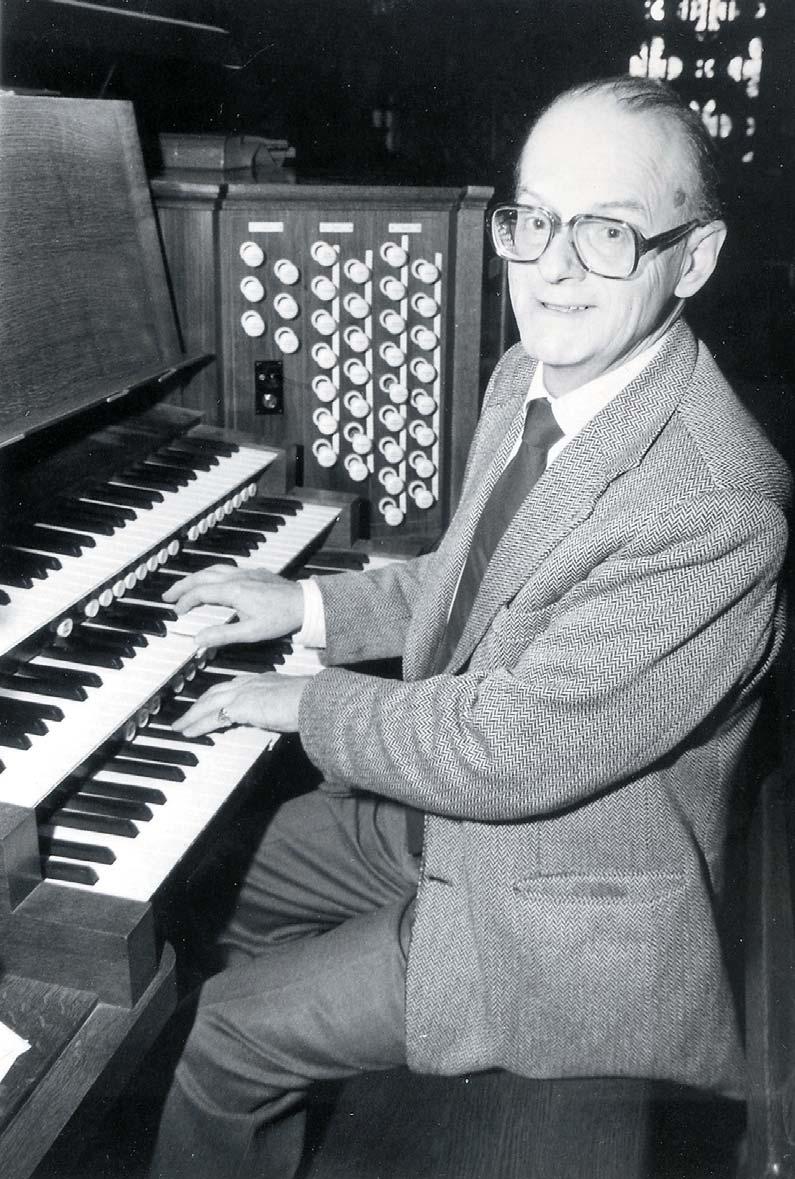
Allan Wicks, some time Organist & Master of the Choristers at Canterbury Cathedral, died on 4th February 2010 at the age of 86.
EDWARD ALLAN WICKS was born in Yorkshire in 1923 and educated at St John’s School, Leatherhead and Christ Church, Oxford, where he was organ scholar. His studies at Oxford were interrupted by the war when he served in Burma. After completing his degree in Oxford he returned to Yorkshire as Assistant Organist of York Minster (194754); from there he moved to Manchester Cathedral as Organist & Master of the Choristers (1954-61). In 1961 he was appointed Organist & Master of the Choristers at Canterbury Cathedral, a post he held with distinction until his retirement in 1988. He was appointed as Lambeth Doctor of Music and was awarded the CBE on his retirement.
An inspirational and spontaneous musician, Allan’s music making was always of the highest order, whether he was playing the organ or directing his choir. Under Allan’s direction, the Canterbury Cathedral Choir, when at its best, was a sumptuous musical machine, psalm singing (aided by Allan’s love of the English language) being a
particular speciality; his organ playing was always electrifying, not least because of his innovative repertoire –Allan was an indefatigable exponent of contemporary music, commissioning and premiering more music than many organists have in their entire contemporary repertoire. In this area Allan’s friendship with the composer Alan Ridout was particularly fruitful, a whole string of works appearing for the Canterbury choir and for Allan as organist. Less well known now is that Allan was one of the first musicians in the UK to promote the music of Olivier Messiaen, giving an early broadcast of L’Ascension and recording La Nativité du Seigneur from St Paul’s Cathedral in 1965. He was the first player to perform Ligeti’s Volumina at the Royal Festival Hall –Xavier Darasse’s earlier attempt being aborted when, famously, it fused the organ with the opening cluster. Allan persuaded Ralph Downes to enter the organ towards the end of the piece so that he could hold down the pallets and prevent the electric action automatically closing them when the blower was switched off; thus the tone was able to fade and the pitch sink, according to the composer’s wishes. Another memorable performance in the Royal Festival Hall was of Reger’s mighty Prelude & Fugue on BACH, a performance so exciting that when, at the false ending a couple of bars before its close, Allan, with one sweeping movement of his left hand, in a split second added reeds on both sides of the console, there was a collective gasp from the audience, which, unable to believe its luck, roared its approval at this charismatic performer. Many musicians, both professional and amateur owe Allan a great debt: organists, singers, conductors and composers all over the world (he directed several choral courses in the USA) will be grateful for their contact with this remarkable man.
When I arrived in Canterbury as a thirteen-year-old boy, Allan’s music making was a revelation. Never before had I heard singing of such commitment as I heard from the Cathedral Choir; vibrato in a boy’s voice was a new experience, as was Allan’s colourful use of language and metaphor when rehearsing his choir – always metaphor chosen to fire the imagination of his young choristers. His organ playing was also a new experience; he had a knack of turning the organ into a percussion instrument, which gave an arresting quality to his playing; another facet of his playing which lives in the memory is his use of colour –
his playing of J S Bach’s Sei Gegrüsset Variations was the most compelling I have ever heard, not only for its imaginative, almost Stravinsky like use of colour, but also for the sense of inevitability which carried the listener forward.
Allan had a love/hate relationship with the Willis at Canterbury. Sadly, it was not a reliable instrument, and this gave rise to unprintable threats as to which parts of Henry Willis IV’s anatomy Allan would have on toast for breakfast if he didn’t put it right; also, being in the triforium on the south side of the quire, the organ bore the full force of the sun, so was rarely in tune. Another threat was to climb the stairs to the organ chamber and remove the tierce rank from the Willis Mixtures. The instrument did, however, have some quite ravishing stops. Having grown up in the Hill tradition at Lichfield, some sounds were quite new to me, and they were sounds in which it seemed Allan revelled: the Swell Oboe, for instance, blended with the Diapason and a 4’ stop was one such sound, used, I remember, to great effect in a performance of Brahms’s German Requiem which Allan accompanied on the organ with enormous skill and musicianship, and with a stream of comments such as “Tommy Beecham had the right idea about this movement” and after the penultimate movement “Get on with it, go on, what is he waiting for? go straight on”; the Willis Corno di Bassetto, particularly in the tenor register (especially when accompanying psalms) was another favourite, as was the Tierce on the Choir manual – the only Tierce rank at Lichfield had been in the bottom octave of a Swell Mixture so this was another new sound. I can still hear Allan using some sort of Cornet in various Bach chorale preludes and cantata movements – his repertoire was always adventurous – and the sound has fascinated me ever since.
But most of all what struck me was the sheer drama of his playing; this wasn’t just somebody playing the organ; it was a personality proclaiming “listen to me!” On one occasion when playing Messiaen’s Transports de Joie he played the opening dissonant manual figure and shouted “That to the Chapter”, then he thundered the next phrase on the full Pedal and (it must have been a frustrating day) shouted “and that to the men in the Choir”, followed by the thrilling F sharp major chord, at which he shouted triumphantly “Wicks!”
Perhaps the single episode which best sums up his sense of fun –there was an impish streak to his nature –was when
he played at the Royal Albert Hall in 1966 in a now legendary evening called Organ in Sanity & Madness, an extravaganza in aid of the Royal College of Organists centenary appeal. Allan appeared with the percussionist James Blades, both sporting dressing gowns. Having taken their bows both divested to reveal boxing shorts; they then settled down to a musical boxing match especially composed for percussion and the Albert Hall organ by Alan Ridout. This was typical of Wicks’s lack of inhibition.
Allan had a particular gift when dealing with school children and adolescents; he treated them as real people and took a genuine interest in their lives. For young people away from home at boarding school his friendship and concern for their welfare were particularly valuable. As a music teacher he was interested in their all-round education. Many amusing stories are too indelicate to record here, but the writer remembers two revealing episodes: the first was when he arrived at Canterbury Cathedral as a shy teenager for his first organ lesson. While walking into the cathedral Allan opened the door and stood aside letting his young pupil go through first. In 1966 it would have been more usual for a thirteen-year-old boy to open the door for his teacher. When, later in life, I remarked on this, Allan replied that he was resident at the cathedral and I was the visitor so of course he should open the door for me. The other episode was a couple of years later; I had been learning the Choral III of César Franck and Allan gave me an hour for the lesson rather than the usual 30 minutes. At the end of the lesson Allan came running down the loft stairs after me and asked “Didn’t you enjoy your extra long lesson?” “O yes”, I replied. “You didn’t thank me for it,” he admonished.
Allan will be much missed by all who knew him. He was possessed of a magnetic personality which caused friends to seek him out like bees round a honey pot. He was unfailingly generous with help, advice, and musical opportunities for composers and performers alike. Many will have fond memories of the generous and convivial hospitality offered by Allan and Elizabeth at their homes in St Stephen’s and at Lower Hardres during their time at Canterbury. He leaves a widow, Elizabeth and two daughters, Lalu and Joanna.
A Memorial Service will be held on 21 May 2010 at Canterbury Cathedral
Eight headmasters, five deans, four bishops, three precentors, three organists/Directors of Music… and a Diapason Chorus in the Minstrels’ Gallery!
It wasn’t the latter that attracted Paul Morgan to Exeter Cathedral as Assistant Organist forty one years ago, since that was only added to the organ a few years ago; nor was it the prospect of working with so many Headmasters, Deans, Bishops, Precentors and Organists, since that clearly couldn’t have been known at the time; nor was it a carefully thought-out plan to enjoy, for ever, the delights of that magnificent cathedral and the balmy South West. It was, in fact, all quite serendipity.

“It just happened. I never had to apply for a job!’ said Paul, who retires at the end of this coming summer term after a lifetime of dedicated service in the place he describes as “a beautiful cathedral with a stunning vista of a fine organ in one of the oldest organ cases (1665) and a lively and caring cathedral community.”
Although born in Northamptonshire, Paul soon moved to Essex and from 1956 attended the Royal Liberty Grammar School, Romford. The same year he had gained a Junior Exhibition to study on Saturday mornings at the Royal College of Music. There he learnt organ, piano and clarinet, together with harmony and composition, and in 1963 he was awarded the Angela Bull Memorial Prize for best performer of the year (in succession to the celebrated pianist John Lill, who had won it the year before).
Meanwhile, he was gaining experience in organ playing at All Saints’ Church, Ardleigh Green where there was an enthusiastic boys’ and men’s choir and his school-friend’s father, Harry Green, was organist and choirmaster. Paul was effectively the playing organist, with Harry assuming the role
of choirmaster. And, as if this wasn’t enough, his aunt was organist at a Baptist Church in Bletchley where, as he put it, “I was allowed to practise to my heart’s content”.
On leaving school, he won an Open Scholarship to the Royal College of Music, where he studied for two years before moving to Oxford as Organ Scholar at Christ Church, where he read Music. In those days the Organ Scholar played the voluntaries before and after Choral Evensong and only accompanied the choir on those (rare) Sundays when the Eucharist was not sung to an unaccompanied Latin setting. “It was a wonderful experience of which I’ve so many happy memories, not least of hearing the Vaughan Williams Mass in G minor for the first time, which is now one of my real favourites”, said Paul, “I learned so much simply by watching the organist (Sydney Watson), listening to and learning the music and discussing it all with him.” That’s why Paul’s advice to any would-be organist is “whatever else you do, make sure you observe a really good organist and choir-trainer; that’s how you learn most”.
And then came the first serendipity event. One afternoon after an Evensong, towards the end of Paul’s third year at Oxford, Sydney Watson asked him: “What are you going to do next year?” and then told him that he’d just received, that very morning, a letter from the Headmaster of Beachborough Preparatory School saying that they needed someone to teach at the School. So off he went to meet the Headmaster and was instantly offered the job (no formal application required!).
Then, at Easter the following year, Paul went back to Christ Church to see Sydney Watson again and, as they sat talking in his study, the telephone rang; it was Lionel Dakers, the Organist at Exeter Cathedral, to say that his Assistant Organist, Christopher Gower, had just been appointed as Organist at Portsmouth Cathedral and so he was now looking for his successor. Did he know anyone suitable? Again, no application forms were needed; just a cocktail party with the two Archdeacons, an invitation from Lionel to play the organ (“I expect you’d like to play it wouldn’t you?”) and a meeting with the Dean and Chapter at which, after being asked whether he’d done any choir training, the Dean simply asked Paul “Will you come?”
And that was that –1969, the start of his becoming an adopted Exonian, at a starting salary of £500 per annum (which seemed marvellous at the time). The post also involved teaching music at the Cathedral School and giving piano lessons to twelve choristers, one of whom was Andrew Nethsingha, now Director of Music at St John’s College, Cambridge. “I began by teaching him where middle C was –always useful for a college or cathedral organist!” As the school expanded, it was not long before he was appointed its first Director of Music at what Paul says was “another wonderful salary of £250”.
Meanwhile, the University of Exeter had established a Music Department to which Arthur Hutchings had been appointed as Professor and Head and in which Christopher Gower was a part-time lecturer. The prospect of Paul taking on that position was raised and so, in due course, he came to be interviewed by Professor Hutchings. The day before that meeting, Christopher had invited Paul to join him in the organ loft for Choral Evensong, and after the voluntary he handed him an envelope saying, “Here’s a letter from the University Secretary, Roderick Ross, which he’s asked me to give you.” The letter simply read ‘I am pleased to offer you the post of part-time (temporary) Lecturer in Music with effect from 1 September 1969’. So, serendipity struck again and Paul was formally appointed, before even being interviewed! (Ah,
those were the days!) Roderick became quite a friend and after he died (aged 94) Paul played at his funeral service in the University Chapel in January this year.
Paul’s university appointment coincided with the start of Music being offered as a Single Honours Degree, and with the appointment of the first choral scholars at the cathedral. Within a year, his hours were doubled (to 0.6FTE) and he began teaching Harmony and Counterpoint – albeit still on a ‘temporary’ contract that was renewed for the next 29 years! In his thirtieth year, his post was made permanent, and it wasn’t long before he became leader of a new MA course in Cathedral Music. Sadly, the music department (and with it the innovatory MA) was closed down in 2007 as a result of pernicious university funding cuts.
So there have been three different aspects to Paul’s musical life – the cathedral, the cathedral school and the university –a not untypical mix of roles for the ‘number two’ in many a cathedral. But, of course, the cathedral role is paramount, and as Paul’s experience shows, it is one that is ever-changing.
When he was first appointed, the situation at Exeter was very different from what it is today. The Organist (now the Director of Music) conducted the choir relatively rarely and mainly only at weekends; the organist was expected to play the organ, at least on weekdays, including for Sung Eucharists on weekday Saints Days (almost invariably to Nicholson Missa Choristorarum) and some voluntaries on Sunday –a far cry from today! One of the lay clerks was appointed to lead the choir with the Head Chorister following his lead. So, during the week, the role of the Assistant was to play for the Thursday Choral Evensong, having taken the choir practices that day (the Organist’s day off), and then at the weekends he would play for the Saturday morning choir rehearsal and Choral Evensong and on Sunday for Choral Matins and Choral Evensong. The Sunday Sung Eucharist was, in those days, a relatively low-key service at which the Organist played.
However, as well as the cathedral choir, Exeter had a longestablished Voluntary Choir (founded in 1881) for which the Assistant Organist was responsible. Its main purpose was to sing for a second Sunday Evening Service at 6.30pm that, according to popular belief, had been started for those who could not get to Matins or Evensong because they were ‘in service’. Over the years it had grown and grown and, certainly by the 1960s it attracted a sizeable congregation, often of young people, especially students at St Luke’s College or the ‘new’ University.
When Paul arrived in 1969 the VC (as it is affectionately known) was a choir of boys and men, but recruiting boys was increasingly difficult and so in 1971 the decision was taken to open it up to ladies. That latter decision was of huge significance, not just for the VC, but for its choirmaster because one of the ladies who joined was Heather, a student reading English at the University – and that was that! They fell in love, got engaged, and have been happily married ever since (even though Heather was for three years one of his bosses having been appointed one of Exeter’s first lay chapter canons in 2002!).
The VC still sings for the Evening Service, now at 5pm, which continues the tradition of having the psalms and canticles to chants together with hymns and an anthem. In addition, as it has done throughout much of its 130-year history, it sings for some of the Sunday services during the cathedral choir vacations, and sings occasional services for parish churches throughout the Diocese. Paul says that amongst the many happy memories he has of his time in
Exeter, which include playing for the Royal Maundy Service in 1983, two of the most cherished are of the VC; one in 1981 when Francis Jackson (now one of our FCM Vice-Presidents) composed the anthem Sing praise to God to commemorate the choir’s centenary and the other, in 2003, when he conducted the Festival Service in Exeter Cathedral for the national Association of Cathedral Voluntary Choirs.



However, the congregation at ‘Second Evensong’ has been declining in recent years, and so its future is currently under review as the cathedral Chapter considers how it wishes to respond to emerging opportunities for outreach. Meanwhile, past and present members of the VC are fulsome in their praise both for their choirmaster and for the opportunity to be part of the cathedral’s music-making. As Graham Dunlop (a senior member of the choir) puts it, “I have always been a great admirer of Paul’s skill and musicianship. It has been a wonderful experience to have the privilege and opportunity to sing in this beautiful cathedral with such an accomplished




and kind musician – always polite and generous in his thanks, even if at times we didn’t deserve it!” Whatever the outcome of the review, there are many who hope that the VC will have an abiding role to play. Inevitably, Paul is saddened that his ‘retirement’ coincides with this potential change “‘It does somewhat take the gloss off it’, he said”.
But he looks back with great affection over his serendipity career in which he has seen and been part of many other changes, both liturgical and organisational. After 30 years in post as assistant organist, Paul was installed as Organist in 1999, which recognised one of the major such changes. For many years, and in contrast to the early years at Exeter, it has been the practice for the choir to be conducted at every service, first by Lucian Nethsingha who succeeded Lionel Dakers as Organist and Master of the Choristers in 1973 and latterly by Andrew Millington, whose title is Director of Music. For about 30 of the last 40 years Paul has played for most midweek Evensongs and Sung Eucharists and for the three
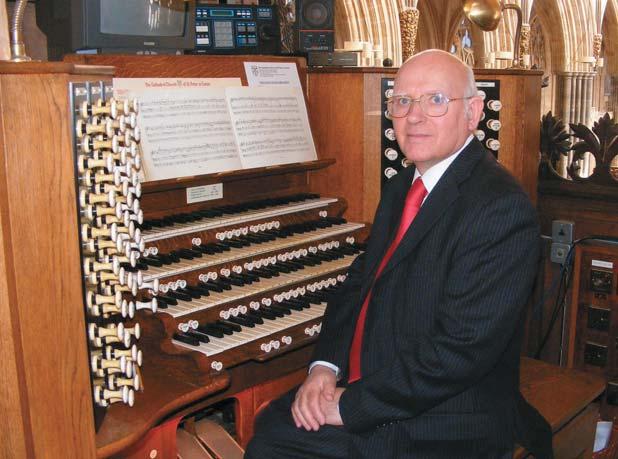
services on Sunday sung by the Cathedral Choir, in addition to concerts, broadcasts and other special occasions. Appropriately his expertise has been used by the diocese in his role as Diocesan Organ Adviser since 1990.
There is now a girls’ choir which he says has made it possible for there to be a more realistic load on the boy choristers; the range of music is far greater than when he started (“we used to do a lot of the Victorian and Edwardian composers, but we now include more recent and contemporary music, some of which won’t stand the test of time,” he says, “but of the more modern composers I do like the music of Matthias, Leighton and Tavener, and of course the Howells canticles are just inspirational”); the Sunday Sung Eucharist is now the biggest regular service in terms of its congregation (“and, I just love the VW in G minor of course, also the Byrd and Viennese Masses, especially the Mozart Coronation Mass”, he says).
The organ had a major overhaul in 2001 during which a 32ft reed and that Diapason Chorus were added. “It’s been a real delight to be able to play more voluntaries and make more recordings than ever before,” says Paul, “my real favourites being those of Bach or the French School (the Final from the First Symphony of Vierne being a particular delight to play).” He has been much in demand as a recitalist, and he has made several recordings, the latest of which (his ‘retirement’ CD) is appropriately entitled, simply, Celebration and includes works by his other favourites such as Bach, Buxtehude, Franck, Widor, Stanford, Whitlock, Howells and Leighton.
All-in-all, he remains positive about the state of cathedral music, not just at Exeter, but throughout the UK generally, even though he is concerned about a number of recent trends that look quite threatening. “Music-making in parishes is in
Salisbury Cathedral Choir offers a wonderful opportunity in a spectacular setting
Be a chorister for a day
Saturday 13 November
Open day for prospective choristers in School Years 2,3 and 4 and their parents

Voice Trial Workshop Saturday 4 December
Voice Trials
School Years 3 & 4
Saturday 22 January 2011 (boys)
Saturday 5 February 2011 (girls)
Informal Pre-auditions any time by arrangement
All children are educated at Salisbury Cathedral School Scholarships and Bursaries available
For an informal discussion with the Director of Music please contact: Department of Liturgy & Music 01722 555125
litmus@salcath.co.uk www.salisburycathedral.org.uk
serious decline,” he says, “and that’s affecting our ability to recruit good choristers; it’s also getting more difficult to fill the back row because lay clerks have greater work commitments and relatively poor remuneration, and without a university music department choral scholars are scarce. And yet, although it’s not easy, we do seem to be able to raise funds for our Music Foundation Appeal.” Long may that continue!
And finally… has he any regrets, any frustrations? Would he still go into a cathedral music career if he had his time over again? “No regrets, I’d do it all again, and the only frustrations are having had few free weekends in which to enjoy my hobbies and having had to endure too many long sermons.”
In retirement, however, he may not be able to avoid the latter since, in recognition of his long and outstanding service, the Chapter has made him Organist Emeritus and the Bishop has appointed him as a lay canon of the Cathedral. What better tribute and celebration could there possibly be in honour of this special Exonian son of Northamptonshire?
Solo Organ Recordings
1968 Organ Music from Christ Church, Oxford (EP – Abbey Records)
1975 Exeter Cathedral Organ (LP – Exon Audio)
1983 Exeter Cathedral Organ (LP – Abbey Records)
1983 Organ Music of S S Wesley (CD – Priory Records)
1992 Organ Imperial, Exeter Cathedral Organ (CD – Priory Records)
2010 Celebration, Exeter Cathedral Organ (CD – Priory Records)
Accompanying Exeter Cathedral Choir
1971 Music from Exeter Cathedral (LP – Exon Audio)
1974 Exeter Cathedral Choir in 1974 (LP – Exon Audio)
1983 Christmas Eve at Exeter Cathedral (LP – Abbey Records)
1984 Music for Passiontide and Easter (LP – Abbey Records)
1985 Evensong at Exeter Cathedral (CD – Priory Records)
1987 Choral Music from Exeter Cathedral (CD – Priory Records)
1989 I was glad –A selection of favourite church music (CD – Abbey Records)
2002 Dancing Day (CD – Herald)
2004 Music for the Eucharist (CD – Herald)
2008 Evensong for St Peter’s Day (CD – Herald)
2009 Ascribe unto the Lord (CD – Herald) – see review on page 57
It’s an unlikely name to English ears, being a dialect word, usually translated ‘rough and ready’, or sometimes, ‘simple’. But as a warm and welcoming dispenser of good beer and other delights, it does the choir well. In some ways it seems more like a slightly select club, with several deep chairs and sofas to sink into, newspapers and an exceedingly pleasant staff. Not only are
they cheerful and friendly, but the boss will even get in a special-request whisky! As you’d expect, the range of whiskies is already larger than you’d generally expect South of the Border. The food at lunchtime is simple, Scots and nourishing, and includes cullen skink, haggis stovies, fish curry and lamb stew… all served in pint mugs, with oatcakes. In the evenings, good food is
served in the restaurant below the bar area, but a great range of cashews, wasabi peas and pistachios, etc, is on sale at £2.00 a half pint. Situated in William Street, a cobbled Victorian street about a quarter of a mile from the cathedral, it is marvellously convenient and in frequent use.

In 2011, a brand new composition prize will celebrate the 400th anniversary of one of the world’s most influential books, and bring together some of the UK’s most influential composers, educational institutions and performers. The Kings James Bible, known as the Authorised Version, was published in 1611. Now its 400th anniversary is being marked with a series of events and initiatives arranged by The 2011 Trust. Among those is the King James Bible Composition Awards, a competition for young composers.

The competition has two categories. In both categories, young composers are invited to submit new works for church performance, selecting and setting texts from the King James Bible (AV). The competition will be open to all composers aged 30 and under on the closing date, 31 January 2011.
CATEGORY A [in partnership with the Royal School of Church Music] will be for an anthem or song for up to four vocal parts and keyboard, suitable for use in worship and should be composed with nonprofessional, less experienced, performers in mind. The final Adjudicator will be Bob Chilcott.
This replaces the RSCM’s annual Harold Smart Composition Competition for one year only.
CATEGORY B [in partnership with the Royal College of Music] will be for an anthem for an experienced choir (such as a cathedral, wellresourced church or professional group) in up to eight parts, unaccompanied or with organ, suitable for use in worship. The final Adjudicator will be James MacMillan.
Up to four shortlisted entries in each category will be performed by the RCM Chamber Choir at a Prize giving Concert and Reception in the Temple Church, London on 17 May 2011, when the two winning entries will be announced.
The winner in each category will receive prize money of £2,000. The winning work in category B will also be performed at a service at Westminster Abbey in November 2011 which forms the climax of The 2011 Trust’s series of celebratory events, running throughout the year.
Full details of the competition can be found at www.2011trust.org –There will be a registration fee of £20 per entrance and entries will be
accepted, online, via the 2011 Trust website from 1 June 2010. Running alongside the composition, the RCM will hold a series of masterclasses for composers in Autumn 2010, exploring writing for voices, and contemporary music in worship today. These will be open to the public.
For more information contact Caroline Watts, Administrator, The 2011 Trust, caroline.watts@2011trust.org
–telephone 020 7223 7931
The Boyan Ensemble is a choir of 25 voices which has visited the UK every year since 1992. Their programmes consist of two parts –the first half is devoted to a cappella sacred music which, whilst it panders to the stereotype of the Eastern Orthodox tradition, is passionate, deeply-felt and thrilling; the second half is a complete contrast –a wide range of folksongs accompanied by a lira, or hurdy-gurdy, and Bandura.
This is a choir which should not be missed. To hear them is an experience, and they will be at a church near you in the autumn. For details, dates and the chance to listen to audio clips, go to their website www.vocalclassics.co.uk/boyan
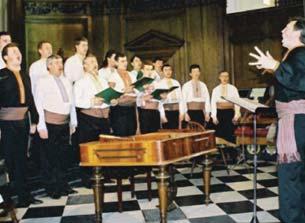
2010
Every July for the past fifty years the choirs of Winchester, Salisbury and Chichester Cathedrals have joined together in a festival of music hosted in turn by each of the three cathedral communities. The Southern Cathedrals Festival was founded in 1960 by the three cathedral organists, John Birch, Alwyn Surplice and Christopher Dearnley. The Festival’s combination of concerts, recitals and liturgy continues to draw a wide audience. This year the Festival is to be held in Chichester under the direction of Chichester Cathedral’s Organist and Master of the Choristers, Sarah Baldock.
The services, which lie at the heart of the Festival, will include a recreation of the 1960 Combined Evensong, which will be recorded for broadcast on Radio 3. Each cathedral choir will also sing a service alone, and Palestrina’s Missa Papae Marcelli is the setting for the Festival Eucharist.
The concert programme includes music by two composers born two hundred years ago, Robert Schumann and Samuel Sebastian Wesley. The Girls’ Choirs of Winchester and Salisbury and the lay clerks and lay vicars of the three cathedrals join pianist David Owen Norris in a concert entitled Schumann’s Musical World, and the boy choristers and lay vicars celebrate Wesley’s bicentenary in an afternoon concert. Thomas Trotter will give the Celebrity Organ Recital.
The Festival has commissioned a new English translation by Amanda Holden of Schumann’s Dichterliebe, which will be premiered in Pallant House Gallery by Mark Wilde (tenor) and David Owen Norris (piano). For younger audience members, some volunteer boys from local schools will participate in a workshop led by renowned choral director Jonathan Willcocks to prepare and perform songs from Benjamin Britten’s Friday Afternoons, working alongside cathedral choristers.
To round off the 50th anniversary festival, Bernstein’s Chichester Psalms form the centrepiece of the Saturday night concert, returning to their spiritual home, and sung by the cathedral choirs for which they were written.
Southern Cathedrals Festival Box Office: 01243 813595
www.chichestertickets.co.uk
Jonathan Bielby reflects on his 40 years as Cathedral Organist

One day in 1970 I was having lunch in the canteen of the Royal Manchester College of Music when Keith Rhodes, Organist of Bradford Cathedral, suggested that I apply for the vacancy at Wakefield Cathedral. “Where is Wakefield?” said I. Having discovered where it was. I applied and was duly appointed after two years I was ready to put the choir forward to sing BBC Choral Evensong. We were billed in Radio Times as Wakefield, Yorkshire. Later we were put down as Wakefield, West Yorkshire. Now, 33 BBC Choral Evensongs later, I like to think that everyone has heard of Wakefield for the county is never mentioned!
Back to the beginning. I was incredibly lucky to be born in Oxford. I attended Magdalen College School, and had organ, harmony and counterpoint lessons at Magdalen College with Bernard Rose. Bernard allowed me to practise on the chapel’s fine three-manual Harrison once a week. It was an incredible experience, playing in that wonderful acoustic, especially in the winter when the chapel was pitch black. I was on cloud eleven afterwards as I bought fish and chips in St Clements for 1/3d and cycled home up the hill to Headington. When I was appointed School Organist at MCS, a blond tousle-haired boy of eleven joined the school and immediately started advising me how I could play better. His name was Simon Lindley. Sir William Harris examined me for Grade 6 Piano and Sir Thomas Armstrong presented me with the School Organist prize.
St John’s College, Cambridge, beckoned, a four-manual on which I could flex my muscles and make incredibly loud noises on the Trompeta Real! Michael Tippett had just written his epoch-making St John’s Service and George Guest appointed me Organ Scholar and in the same breath hissed, “learn the Tippett”! Those were heady days: David Willcocks and Andrew Davis were at Kings, John Rutter, David Atherton, Mark Elder and John Eliot Gardiner were contemporaries. We punted, made LPs, went to the occasional lecture, drank. After three years Christopher Dearnley offered me the assistantship at Salisbury, but I had accepted George Guest’s offer of a fourth year at St John’s. This was before the system of overlapping organ scholars. When George was away I remember having to take the choir through a Howells service unaided from the organ loft. When he was on sabbatical for my last ‘long vac.’ term, I was fortunate to have my successor, Stephen Cleobury, to play the organ.
What do you do after working with a world-class choir for four years? I spent a term filling in at Berkhamsted School, exactly midway between Oxford and Cambridge, where a sixth former called Neil Collier turned pages for me at the organ. I then joined Derrick Cantrell at Manchester Cathedral. Happy days! I taught at Chethams Hospital School where the pupils included Peter Donahoe and Roger Wright, now Controller of Radio 3 and the Proms. Roger sang the lead in our production of Britten’s The Golden Vanity, its premiere in the north of England. I was in charge of the Voluntary Choir at the Cathedral and another blond-haired boy with a cherubic face, called David Hill, was my Head Chorister. In a performance of Faure’s Requiem I got David to sing Pie Jesu from the organ screen. The performance was not quite as good as it should have been. When asked the reason, David complained that he had stubbed his toe on the organ loft stairs!

Oxford and Cambridge, Lancashire and… what should my next move be? Yes, it had to be Yorkshire. When I was at Cambridge I always declared that nothing would make me work in the north! But Bielby is a Yorkshire name (there is a village of Bielby in the old East Riding) and my father was brought up

in Redcar. My mother when she was in her teens attended Leeds Girls High School and my uncle was headmaster of Huddersfield New College. Historically the organists of Wakefield Cathedral have tended to have long tenures. I am only the fourth holder of the post since the diocese was formed in 1888! My predecessor, Dr Percy Saunders, had died in office on Whit Sunday 1970. When I arrived on 1 September the Head Chorister was a certain John Scott, who rapidly became Organ Scholar and Assistant Organist.
Wakefield Cathedral in 1970 was a black grimy building with huge lorries changing gear as they climbed past the building. The cathedral now is white and clean sitting in the middle of the pedestrianised cathedral precinct. Originally the proud parish church, it is now the cathedral in the marketplace. This provides us with huge opportunities, but also a number of noise problems. Sometimes I have had to slip a pound to the bagpipe-player busking outside during a Saturday morning organ recital to persuade him to take a break! The whining dog belonging to the hot chestnut seller has often featured on BBC Choral Evensong!
For the 120th anniversary of the diocese I organised a concert featuring the music and musicians of York Minster, Ripon Cathedral and Wakefield Cathedral. Wakefield was formerly in the diocese of York and then of Ripon, until the industrial revolution dictated the creation of a new diocese whose main centres are Halifax, Huddersfield, Dewsbury, Wakefield, Pontefract and Barnsley. The diocese of Wakefield borders eight other dioceses – in clockwise order, Sheffield, Derby, Chester, Manchester. Blackburn, Bradford, Ripon and York. Half the diocese is nearer to neighbouring cathedrals
than to its own cathedral. This means that when the telephone rings we have to say “This is Wakefield Cathedral” not “This is the Cathedral”.
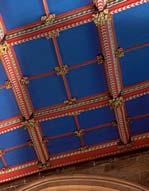
It is hard running cathedral music in a place like Wakefield. It is not a huge city like Leeds or Manchester where large firms can be persuaded to fund their cathedrals. Nor is it on the tourist trail like York or Durham with a local gentrified following. We have no university to provide choral scholars. Our organ scholar comes from Huddersfield University, but it is impossible to get from Huddersfield to Wakefield early enough on a Sunday morning by public transport! However, we do have excellent schools in Wakefield, with two of which –Queen Elizabeth Grammar School and Wakefield Girls’ High School –we operate a fee remission scheme. The schools are considerably bigger organisations than the Cathedral, which means that if a boy is picked to play for the school, he misses a practice or service at the Cathedral.
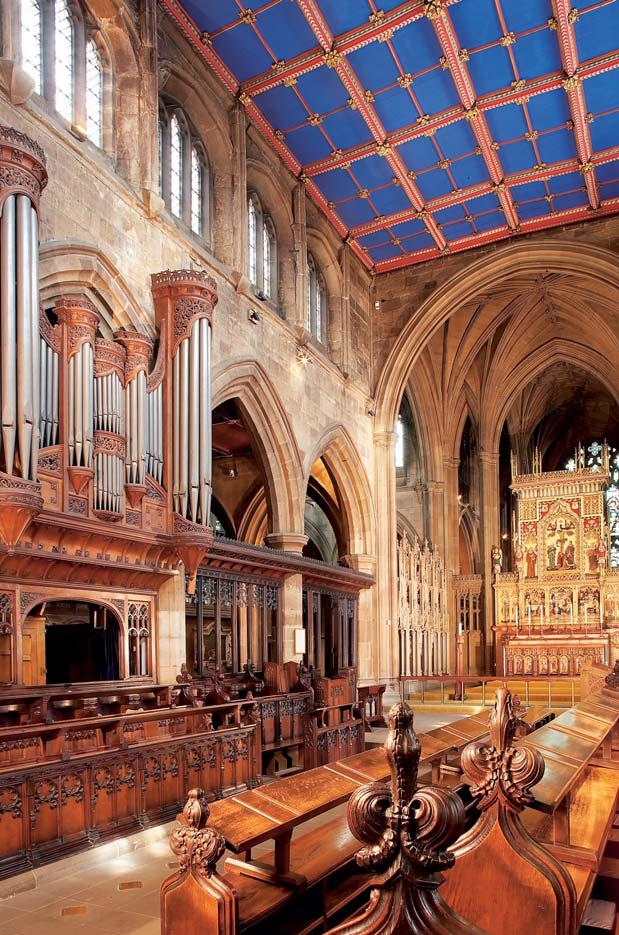
Because of where we are, I have had to be more enterprising and imaginative in our outreach. Early on I formed the Cathedral Concert Society. “You’ll be wasting your time, lad. Nobody will come.” We were the first cathedral to broadcast Choral Evensong to the modern words of the ASB. For my last live broadcast we sang Andrew Carter’s wonderful Wakefield Service set to this modern translation. On the other hand, I would not give up the Cranmer psalms for anything. For midweek full Evensongs we sing the complete psalms appointed in the BCP for the evening and in alternate years the morning psalms. It worries me that the amount of psalmody in many cathedrals is being reduced. We all look forward to singing the 15th Evening! When the cathedral organ was being rebuilt we sang the psalms for nine months unaccompanied. I suggested that 73 verses of Psalm 78 would be a bit much without the organ but I was voted down by the lay clerks! Illustrated above is one of my chants which experiments by reversing the usual 3 + 4 bar format.
The last forty years in the world of cathedral music has been an incredibly exciting time as more and more initiatives and innovations have become commonplace. The standards of the older, well-established cathedrals have been challenged by the newer parish church cathedrals. Directors of Music in English cathedrals are now all paid full-time (except at Wakefield). In 1970 the BCP reigned supreme, then the ASB came and went, and now we have Common Worship. The best of our new hymns are rejuvenating cathedral worship. Recording has progressed from vinyl, to cassette, to CD. Choir tours criss-cross the world. Girls have become an integral part of cathedral music-making.

In addition to my work at the Cathedral I have needed other employment to supplement my income.
From 1974-88 I was the first person to hold the post of Kirklees Borough Organist with a remit to play in churches in the area as well as in Huddersfield Town Hall. I invited top flight recitalists to play on the famous Willis organ and advised on the rebuild there. On my suggestion the bar in the Town Hall was renamed the Father Willis Bar! My three LPs of Romantic Music of Yesteryear from Huddersfield epitomise how rapid have been the changes in recording techniques. The first was non-digital, the second was digital but each take had to be recorded complete, the third was digital and editing was now possible. A compilation was then issued on CD. It was fun

working with Neil Collier again; his Priory Records company is now Britain’s premier church music label.




From 1979-2004 I was a full-time Lecturer in Academic Studies at Leeds College of Music. I found it stimulating to be out in the secular world, working with jazz and instrumental colleagues of great eminence. Having to explain things to the students made me understand harmony and composition in a totally new way. Moreover, if a student did not turn up for a lesson I could spend the time writing my own compositions for choir or organ!
In 1995 I produced three volumes of pieces I had written for the Cathedral Choir entitled 25 Years at Wakefield. Each piece was prefaced by a line drawing of some aspect of the Cathedral and some reminiscences putting the piece in context. Over the years I have enjoyed the challenge of composing pieces to commemorate important occasions for the Cathedral or for my friends. Let the roaring organs, for example, was written for the rededication of the rebuilt cathedral organ in 1985. The work was done by the Huddersfield organ builders, Philip and David Wood, who

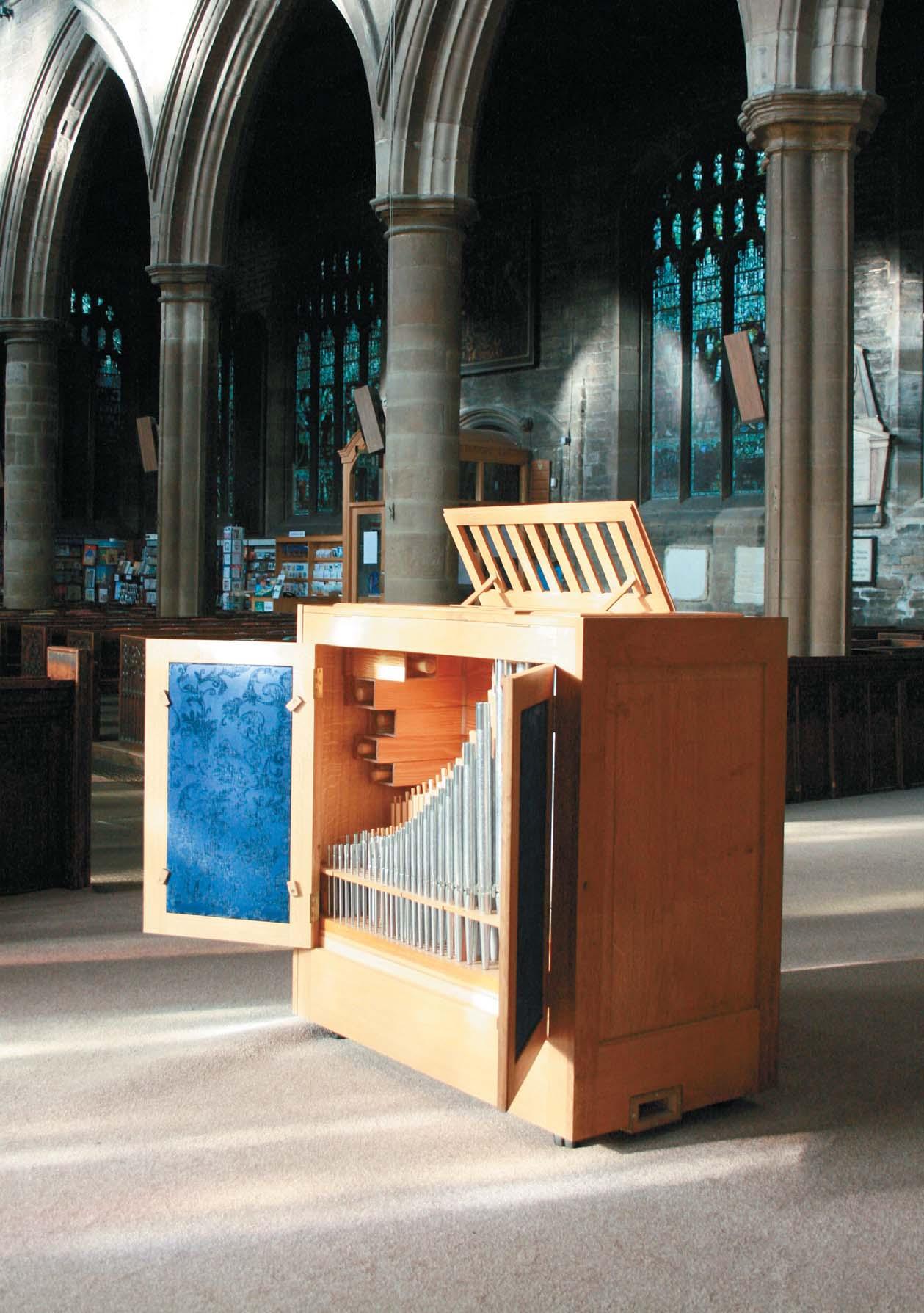
are immortalised in the fugal section that al the Woods may answere and their eccho ring! The story appeared in The Yorkshire Post under the headline ‘Polished Wood work’! A CD of my choral music, interspersed with commissions by Kenneth Leighton, Andrew Carter, Philip Moore and Sean Farrell has just come out. Entitled 40 Years at Wakefield, it is available on the Herald label.
I have also enjoyed composing organ pieces which I can play in my recitals. Carillon de Wakefield, for instance, is a tribute to the distinguished composer, Kenneth Leighton, who started his musical career as a chorister at Wakefield Cathedral. The piece is based on the Hour Chime at Wakefield which was composed by Sir Walter Alcock of Salisbury Cathedral. Its title is in homage to Vierne’s Carillon de Westminster, based on the chimes of Big Ben. A CD, The Organ Works of Jonathan Bielby, is also available from Herald.
This Precious Earth is my biggest work, a 40-minute cantata for chorus, children’s choir, soprano and baritone soloists, speaker, orchestra with a vast array of percussion, and didgeridoo. Commissioned by the Yorkshire Philharmonic Choir, which I conducted from 1973-86, it raises important questions about what we are doing to our planet.
During my 40 years as Cathedral Organist and Director of
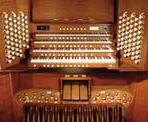
Music I have been privileged to work with five bishops, five provosts/deans, eight precentors, seven assistant organists, 220 boy choristers and 80 girl choristers. Wakefield was one of the first dioceses to establish a Bishop’s Chorister Award (1973), and a Diocesan Organ Tuition Scheme (1975) which has made a significant contribution to providing competent organists in parish churches. It is now ecumenical and has become a model for other areas and nationally. In 1992 Wakefield was only the second cathedral to introduce girl choristers (the first in the Northern Province). Wakefield founded the Yorkshire Cathedrals Girls’ Festival in 1988; the boys and men took a leading role in the West Riding Cathedrals Festival (until 1981) and the Yorkshire Three Choirs Festival (from 1982). In 1970 there were three choral services a week; there are now six.

As I look back at my time at Wakefield, I know that most of all I will miss working with the choristers and lay clerks, encouraging them to develop, taking enormous risks and having fun together, achieving extraordinary things. I will miss working with my assistant organists and organ scholars, who have been a constant source of stimulus. I will remember the Queen telling me that she liked one of my compositions sung at the Royal Maundy service. I will remember losing my copy of Leighton’s 2nd Piano Sonatina at the 650th Anniversary of Wakefield Chantry Chapel (the best preserved of the four English bridge chapels) and having to make it up! All this has, I hope, prevented me from getting stale over the years! Two of my heroes are George Guest and Stanley Vann. George clocked up an extraordinary 40 years at St John’s, Cambridge, Stanley had a legendary career at Peterborough; both kept amazing standards right to the end. Not bad examples to follow!
Why




Details from: Westminster Abbey Choir School
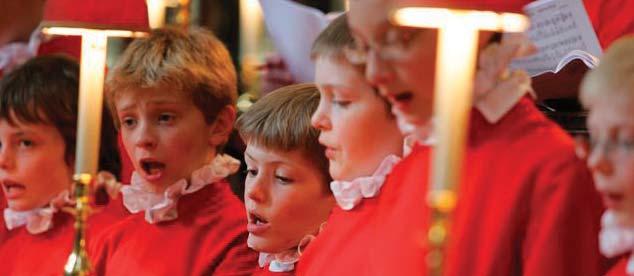



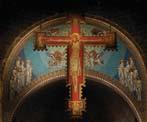
Dean’s Yard, London SW1P 3NY

Telephone: 020 7222 6151
Email: headmaster@westminster-abbey.org
www.westminster-abbey.org
Offering extraordinary home practice versatility and value, the Vivace 40 model is priced at £4,700 inc VAT.
With over 5000 instruments sold worldwide each year, we have a growing group of satisfied customers, and when you hear a Viscount, you’ll want to join them.
For more information on our regional distributor network where you can play an instrument, contact Viscount Organs on 01869 247333 or email sales@viscountorgans.net
Experience the superior sound of the Viscount Vivace series of Organs.
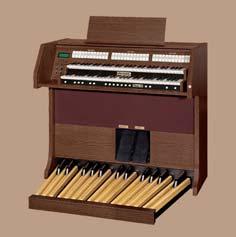


Before deciding on your next organ purchase, be sure to listen to the new Vivace series from Viscount. Our versatile Vivace 40 model features:
2 Manuals
30 Note Pedal Board
31 Stops
110 voice sample library

5 selectable organ styles
Console voicing controls
8 Memory Levels
Age 28

Education details
Verulam School, St Albans; University of Oxford (Magdalen College, 1999-2003) (Master of Arts; Master of Studies)
Career details to date
Organ Scholar, Magdalen College Oxford (1999-2002); Assistant Director of Music, St Michael’s Church, Cornhill (2002-5); Organ Scholar, St Paul’s Cathedral (2003-5); Assistant Organist, St Mary’s Cathedral, Edinburgh (2005-7); Organist and Master of the Music, St Mary’s Cathedral (2007-present).

What do you enjoy most about working in a cathedral like St Mary’s? Whatever the actual temperature, the atmosphere is warm and friendly. The congregation is so appreciative and supportive of the music.

What was it like studying organ at Magdalen College Oxford and who was your tutor?
I was immediately struck by the musical history of the place and the attention to detail in worship. The organ is not the most comfortable to play but it makes you practise! I learnt chiefly with David Goode and Kevin Bowyer, and then Thomas Trotter. And of course Bill Ives was a great inspiration.
What organ pieces have you been inspired to take up recently and why?
I’ve just started looking at the LeightonOrgan Concerto: it’s a fine piece and has been on my ‘to do’ list for a long time.
Have you been listening to recordings of it and, if so, is it just one interpretation or many and which players?
John Scott’s recording of the Leighton with Richard Hickox.
What was the last CD you bought?
Chopin Polonaises, Mazurkas & Nocturnes played by Janusz Olejniczak on Erard and Pleyel pianos.
The last recording you produced with the choir received rave reviews; what prompted you to record John Taverner’s music and how did you prepare?
First and foremost it is fantastic music which isn’t performed nearly enough, except by all-adult choirs. Second, I felt we had the right sound for the music. Finally, I’m a strong believer that setting choristers a challenge raises their standards. Taverner is certainly challenging, and I think we’ve grown further as a choir by recording some of his most difficult music.
Which is your favourite organ to play? Here at St Mary’s.
What is your favourite building?
The Houses of Parliament: I like the buzz of being around Westminster, where so many important decisions are being made and there is so much history.
What is your favourite anthem?
Harris Bring us O Lord and Bairstow Blessed City –but far too many to say I have a favourite.
What are your favourite set of canticles?
It changes frequently, but all the ‘seconds’ are consistently up there –Byrd Second, Gibbons Second, Leighton Second. Also Howells St Pauls
What is your favourite psalm and accompanying chants?
Psalm 69 with chant by T T Noble.
What is your favourite organ piece?
J S Bach’s Toccata and Fugue in F BWV 540.
Who is your favourite composer? Mahler.
Any forthcoming appearances of note?
I’m playing a couple of recitals in the US this summer and then it’s straight into the hectic Edinburgh Festival programme of recitals and concerts.
Have you played for an event or recital that stands out as a great moment?
During my time at Magdalen, Paul McCartney wrote an oratorio for the choir. Premiering that both in its organ arrangement form (with the choir out of sight and ear in the antechapel) and then playing the organ in the orchestral arrangement were both memorable occasions. It was almost
surreal speaking to Sir Paul in the organ loft!
Has any particular recording inspired you?
The King’s recordings of Howells and the Bernard Rose recordings from the 1960s.
How do you cope with nerves?
By keeping busy and focussing on what I can do to minimise last-minute panics.
What are your hobbies?
Cricket, tennis, walking, politics, history. I’m also getting more knowledgeable about whisky.
Do you play any other instruments?
Cello in the dim and distant past, and there was a three-week experiment with the Double Bass.
What was the last book you read?
Archangel by Robert Harris.
What are your favourite radio and television programmes?
Test Match Special beats everything else by a country mile (also cricket on Channel Four before Sky took it away from me). The Inbetweeners, Relocation, and Dad’s Army.
What Newspapers and magazines do you read?
The Guardian, The Scotsman.
If you could have dinner with two people, one from the 21st century and the other from the past, who would you include?
King Henry VIII and Queen Elizabeth II.
What do you think should be the role of the FCM in the 21st century?
To encourage and spread the word about what a unique listening and/or performing opportunity is on people’s doorsteps in cathedrals –a professional standard of musicmaking on a daily basis.
On the face of it Reginald Moore was a charismatic and larger-than-life figure possessing great charm and a huge talent. Standing at over 6ft 4ins he had the presence and sparkling wit to ‘make’ any gathering. However, there was also a shy side to him and he often felt himself to be awkward with people and situations with which he was unfamiliar. He lived music, every moment of his day and regularly embarrassed his daughter (the writer) by beating time to whatever was in his head whenever they went for a walk together.
He was born 100 years ago in Bramley, Leeds, on 19 May, 1910, the eve of the funeral of King Edward the Seventh. Both Reg’s father and grandfather had fine baritone voices and sang as soloists in oratorio in Yorkshire and so it was no surprise that he became a chorister at Leeds Parish Church at the age of seven. It was to be a long stint as his voice did not break until he was well over sixteen. By this time he was also an awardwinning pianist and was taking organ lessons with the legendary Sir Edward Bairstow at York Minster.
Reg won an organ scholarship to Peterhouse, Cambridge but in the days when scholarships bestowed honour rather than money; the finances required for such a venture were beyond his family and instead he started teaching the piano and organ, became organist of St Peter’s Church, Bramley, and continued his lessons with Sir Edward – taking the ARCO examination successfully at the age of 19 and following that with the fellowship a couple of years later.
Appointed In 1933 as assistant to Sir Walter Alcock, the organist of Salisbury Cathedral, the Yorkshire boy moved south to that most sheltered and peaceful of southern cathedral cities. He often talked of his home sickness in his early days – longing for the grit, lights, noise and energy of Leeds on a Saturday night as he wandered through the quiet streets of Salisbury. But it was here that his great love of choral
conducting developed and was nurtured, becoming the most important aspect of his musical life for the rest of his days. In his early years at Salisbury he met Sir Adrian Boult who took a great interest in him and was convinced that Reg would make an outstanding orchestral conductor. Generous in his support, his tuition, and in his introductions in London he failed to persuade Reg that this particular rostrum was for him. Reg returned to Bramley in 1939 to marry Gay in St Peter’s Church. Within six months war had been declared and early in 1941 he left Salisbury to serve in the Royal Air Force, where he was trained in radar and stationed, for a large part of the war, at Bolt Head in South Devon.
At the end of the war he returned briefly to Salisbury but was very shortly appointed Assistant Director of Music at Winchester College. Here with its unique choral tradition and with an abundance of very bright and able students to teach, he spent some of his happiest years. He revelled in the sophisticated badinage of the common room and in living in such a vibrant and busy community. Firm friends with the cathedral organist, he also performed regularly there as well. It was at this time that he took his BMus degree externally from Durham University.
In 1952 Reg was shortlisted for the organist post at both Canterbury and Exeter Cathedrals. The Exeter interview was
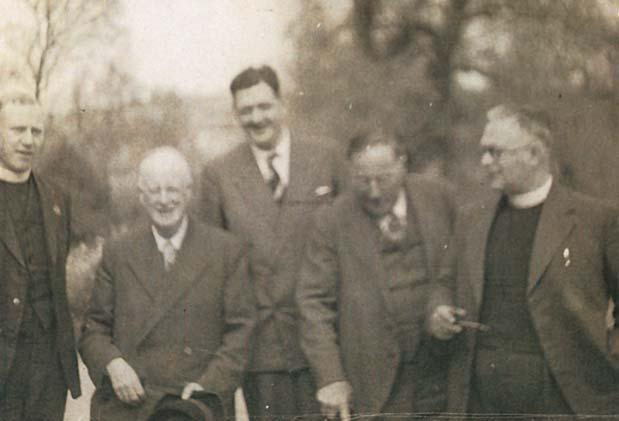
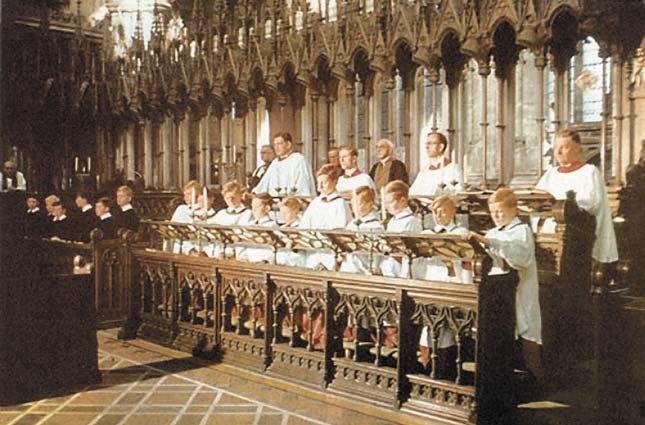
first and he was immediately offered the job – having secured the vote of the choristers at the rehearsal he took with them. Finally he had his own choir and he was determined that it should be second to none. He worked both himself and the choir tirelessly and within six months the Exeter Cathedral Choir was being talked about in many important musical circles. His belief that only the very best performance was acceptable to the Glory of God made him, sometimes, a hard taskmaster, although he continued to inspire great respect
and affection from the cathedral choristers. The next few years saw many accolades with broadcasts and outside performances ahead of their time –as indeed perhaps Reg was a man ahead of his time as far as Exeter, still emerging from a tough war, was concerned. For example, his espousal of the music of Herbert Howells caused visible discomfort to one member of the Chapter. Soon after his appointment to the Cathedral he had also been appointed Director of Music at the then University College of the South West (soon to become Exeter University), and, of course, he trained and conducted Exeter Choral Society and Orchestra. The workload was heavy –especially as for much of the time he had no assistant organist. Disagreements developed with the cathedral authorities, and these could not apparently be rectified and so, after four years of glorious music-making, during which time he had introduced and also commissioned uplifting music, Reg left the Cathedral to concentrate on his university work, now training and conducting the University Choral Society and Chapel Choir and to continue as a recitalist –giving frequent broadcast recitals on the organ, and guest conducting the BBC Chorus.
At a farewell reception at the Cathedral he said, “I am sentimental enough to believe that the music which we have made together in this wonderful Cathedral has been absorbed into these hallowed walls for all time”.
Reg died, of lung cancer, just after his 58th birthday in 1968 –and, sadly, did not live long enough to know his two wonderful grandsons but he would have been delighted that the younger became a chorister in the choir under one of his own Exeter choristers, Barry Ferguson, at Rochester Cathedral.
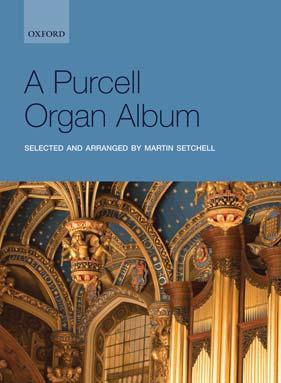
SELECTEDAND ARRANGED BY MARTIN SETCHELL
This is a marvellous set of pieces, all newly arranged for organ and perfectly accessible to intermediate players.
There are sprightly curtain tunes and hornpipes from the stage pieces, lovely reflective songs and airs, and a wide range of dances and chaconnes.
Includes new arrangements for organ of Trumpet Tunes and Airs and Dances from:
Abdelazar ● Amphitryon
Bonduca Aire ● Come ye Sons
of Art ● Dido and Aeneas
Dioclesian ● The Double Dealer ● The Fairy Queen
The Indian Queen ● King Arthur


SELECTEDAND ARRANGED BY MARTIN SETCHELL
£12.95

What makes music ‘music’ is the mathematical relationship between the pitch of different notes both in melody and harmony. The simplest possible relationship is the octave, where the ratio of the number of vibrations of a note (string, column of air, reed etc) of two notes one octave apart is two to one. Other simple ones are the fifth, where the ratio is 3/2 or 1.5, and the fourth where the ratio is 4/3 or 1.333. For some reason, we perceive these ratios as pleasing, at least in western music. This concept of ratios is known as ‘just’ intonation or temperament. On certain instruments, notably the valve-less bugle, the only notes that can be played are related to each other by these simple mathematical ratios.
However, there is a big problem with using ratios. On a piano keyboard, one can go round what is called the ‘circle of fifths’, whereby starting at one note, say the A above middle C which is usually tuned to vibrate at 440 vibrations per second (cycles per second or Hertz), one can play the fifth above the starting note, in this case E, and then the next fifth (B) and so on, eventually ending up (twelve fifths later) at another A. On a piano, this works just fine, but what happens when the ratio of 3/2 is used? The answer is that one never ends exactly back at an A. The table below shows this in action. To avoid running out of keys, we need to go down an octave every two fifths:
A440Hz
E660
B495
F#742.50
C#556.88
G#835.31
D#626.48
A#939.73
E# = F704.79
C1057.19
G792.89
D1189.34
A446 This should be 440, so 6 Hz out
Now 6Hz doesn’t sound a lot but it’s actually a quarter of a semitone at this pitch. Just about anyone, no matter how tonedeaf, can hear this amount of out-of-tune-ness. Pythagoras first
wrote about this problem, which is why this difference is termed the Pythagorean comma and he came up with a more complex set of ratios to try and solve it. Unfortunately, the values he used for thirds and sixths were so far out of tune that they were unusable, and consequently absent from early polyphonic music.
This problem is particularly noticeable in music where modulation to different keys is required, as a particular note in one key is not necessarily the same pitch in another. Taking A (440) as a reference point and using just temperament, the ratios and frequencies of an A major scale are thus:
NoteRatioRatio Frequency (as a decimal)
A1440
B9/81.125495
C#5/41.25550
D4/31.333586.7
E3/21.5660
F#5/31.667733.3
G#15/81.875825
A2880
Now say we wanted to be in C# minor, we can go up from the A by a major third (ratio 5/4):
C# = 440 * 5/4 = 550Hz
and then we can go to the leading note B which is a whole tone down from C#:
B = 550 * 8/9 = 515.625Hz
But B is also a whole tone up from A:
B = 440 * 9/8 = 495Hz
Thus the B in A major is not the same as the B in C# minor. One way of correcting this would be to have another B key on the keyboard at the higher pitch, and in fact examples of early instruments exist where the black notes on a keyboard are split for just this situation. Unfortunately it makes playing rather difficult.
It turns out to be impossible to tune the twelve-note chromatic scale so that all intervals are ‘perfect’, and many
different methods of tuning with their own various compromises have thus been used over the years.
The one that has won the day, at least as far as keyboard instruments are concerned from the 19th century onwards, is equal temperament. In this tuning method, all semitones are equal and defined to be 1.05946 (mathematically the 12th root of 2) times the frequency of the semitone below. This can’t be expressed as a simple fraction, although in early electronic instruments a set of integer dividers from a very high frequency gave a good approximation. For example, 125015Hz divided by 284 gives A at 440Hz, and divided by 451 gives the C# below. In equal temperament, all keys have exactly the same tuning, every semitone has the same error relative to its neighbour, and thus sound the same irrespective of the key.
Bach’s use of the term ‘well tempered’ was somewhat different in that the tuning errors were less evenly distributed giving distinct characters to different keys. Some musicians talk of these ‘key characters’, for example bright or tending to flatness, but they can only really apply to music where moderntuned instruments are not involved.
The table below shows the difference between equal and just temperaments. Errors in tuning are usually specified in cents which is one twelve-hundredth of an octave or a hundredth of a semitone.
A440Hz
C#440 * 5/4 = 550Hz
E440 * 3/2 = 660Hz
A440 * 2 = 880
All nice round numbers, which gives a pure sound, and there are no beat notes as all the (just) harmonics are in tune with each other. The same chord played on a piano will have these frequencies:
A440Hz
C#440 * 1.2599 = 554.4Hz Very sharp
E440 * 1.4983 = 659.3Hz Very slightly flat
A440 * 2 = 880
This will result in very characteristic beat notes between the harmonics of the strings which are not in tune with each other. The real difference between just and equal temperaments often leads choir directors, especially ones who have spent their formative years as piano or organ players, to try to make a choir sing major thirds and leading notes higher (brighter) to make the choir match the pitch characteristics of a (equal tempered) keyboard.
In summary, it’s not surprising that singers who rely on intervals and naturally sing ‘just’ intervals tend to go ‘out of tune’, especially in chromatic music as they have no solid
Note Equal RatioHzJust RatioDecimalHzError (cents)Compared with just equal is:
A1440114400
A#1.059546616/151.066746912flat
B1.12254949/81.12504954flat
C1.18925236/51.200052816flat
C#1.28995545/41.250055014sharp
D1.33485874/31.33335872sharp
D#1.41426627/51.400061617sharp
E1.49836593/21.50006602flat
F1.58746998/51.600070414flat
F#1.68187405/31.666773316sharp
G1.78187849/51.800079218flat
G#1.887683115/81.875082512sharp
A28802/128800
This shows that the same sequence of notes played on a piano and played on a bugle or sung by a singer will not necessarily be identical in pitch. The differences are small for major 2nds, 4ths and 5ths, but quite large for 3rds, 6ths and 7ths.
There’s one further complication with just temperament in that the semitone difference between a major and a minor third (C and C# in the above table) is 25/24 and the difference between semitones at either end of the scale (A and A# and G# and A) is 16/15 which is a huge variation. In cents this is 70 and 112 respectively making the two semitones 42 cents different which is nearly a quarter of a tone. Also there are other pretty good ratios such as 16/9 for a minor 7th which is only 4 cents away from equal, but is of a higher order than 9/5. This can give ‘just’ singers or bugle players more than one way of getting to the ‘same’ note.
Harmony is also based on natural values, so a chord of A major would be vibrating in the ratios 4 : 5 : 6 (ignoring the octave):
frame of reference. Instrumentalists on fretless stringed instruments at least have the open string as their reference, but they will be continually re-tuning as they play, to keep the intervals just and the harmonies natural. In an a cappella choir that does stay in tune, it may be due to presence of one or two singers with perfect pitch. It’s also possible that pitch memory is involved where some singers can keep their own local frame of reference going for long enough to keep the tuning intact.
It also begs the question, what is meant by perfect or absolute pitch when applied to a singer? A quick straw poll of three cathedral lay clerks who do have perfect pitch, gave the result that they have equal temperament pitch. This means they actually sing the same notes as played on a piano, which suggests that in perfect pitch the pitches are remembered.
Charles Beal is a lay clerk at Wakefield Cathedral.


Many remedies are suggested for a cappella choirs which lose pitch: for example bright vowels, smiley faces, good posture, controlled breathing. Whilst all of these supposed cures are laudable, and should surely be upheld as good singing practice, I do not believe that they tackle the root cause of why choirs go flat, and why tuning is always a problem in a cappella choral singing.
My experience is that the problem goes far deeper than posture or breathing. It is rather a fundamental and immanent aspect of the relationships between the notes of the scale. That this is a problem has been known since Pythagoras’s time, when he found that the circle of fifths did not get you back to where you started. This created such difficulties with tuning that thirds and sixths were regarded as dissonances in mediaeval times, and that it was many years before the seventh really found its place in the scale. The problem was also described like this: Tonus enim in duo aequa dividi non potest (‘A tone cannot be divided into two equal parts’).1
Since then, many attempts have been made to resolve the problem, and the solution favoured at present is equal temperament –which uses more modern technology to do precisely what was previously impossible: to render all semitones equal. To achieve this, equal temperament makes all the intervals on the keyboard slightly wrong (except for the octave), on the grounds that this slight out-of-tune-ness is a) barely noticeable and b) outweighed by the advantage of being able to play in lots of different keys and to use exciting harmonies.
However, the intervals on the keyboard and other fixed-note instruments are not the natural intervals. The harmonics clash. The fourths and fifths are slightly less than perfect, and as for the other intervals: the major third is too major, the minor third too minor, and the major seventh most unsuitable.
When a choir sings with instrumental accompaniment, the problem is mostly solved by the instrument leading the voices, which follow the prescribed intervals. But when the choir is singing a cappella (or, worse, is performing one of those pieces when the accompaniment pops up again at the end to check whether the choir is still in tune…) there is nothing to guide the voices any more.
It is perhaps possible to try and force the a cappella voices to stick to the notes dictated by the keyboard, but ultimately the choir will want to do what comes naturally, and that is not to sing in equal temperament. Instead, the singers listen to and are guided by one another. The voices will follow natural harmonics and natural intervals. This natural system of tuning is known as ‘just intonation’. In German, it is called reine or pure intonation.
Left to itself a major chord will be sung with the third slightly below that
on the keyboard; a minor one with the third slightly higher. Because the harmonics no longer clash, the choral sound is much more wholesome.
But the problems come when a note which fulfils a particular function in one chord fulfils a different function in relation to the next chord. In example 1, the third at the top of the first chord of a perfect cadence ‘Amen’ is also a leading note to the tonic in the next chord. And when we think melodically, rather than harmonically, we tend to sing a leading note slightly high: somehow, it makes the melody sound brighter. We expect the interval in the melody between the leading note and the tonic to be ‘narrow’. If, however, the F# in the example has been sung naturally as a just intonation third, singing a narrow interval to the G will produce a flat G.
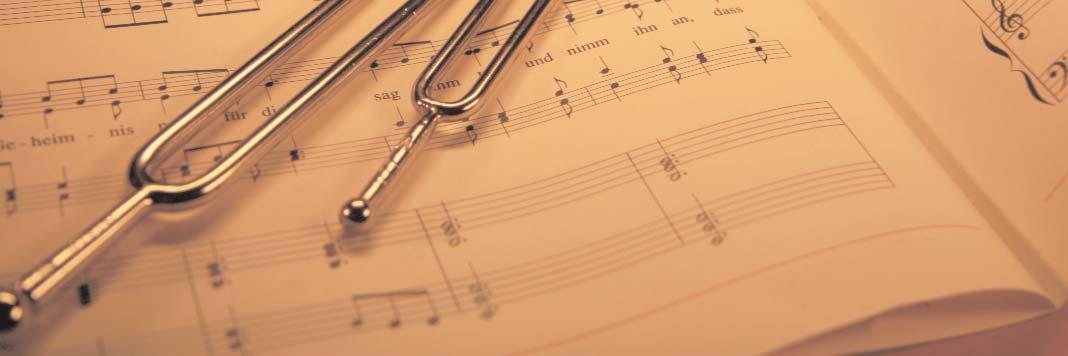

So the choir is left with several choices: to try to sing a cappella in equal temperament –pretty much an impossible task; to sing the third naturally and risk being flat on the tonic; to sing the third a bit higher, making it clash with the harmonics of the rest of the chord; or to make the interval from the (flat) leading note to the tonic a bit bigger.
I believe the latter solution is the best one for this simple problem. Both notes
then fit in with the underlying harmonies and the harmonics; it is quite simply the ‘natural’ way to sing. All the director needs to do is to draw awareness to the sopranos’ need to sing a ‘large’ semitone, and they will get to where they want to go.
Another example: the opening of Loosemore’s O Lord, increase our faith (example 2). When I was singing the tenor part of this piece in a choir recently, I observed how the sopranos were going flat in the first two bars when all four parts were singing. This was because they were naturally taking the G# as a third rather than a leading note, and failing to get back up to the A again. The director also noticed the problem, stopped the piece and had the sopranos sing the section on their own – and now they stayed in tune, since their intervals were melodic and not affected by the harmonies provided by the other voices. But when they sang the passage again with the other parts, the problem naturally returned. The solution: once they learn that the semitone back up has to be a ‘big’ semitone, the problem is resolved.
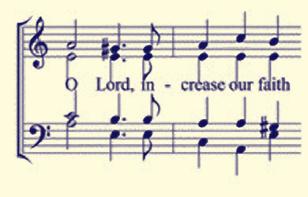


I have taken two examples of the tension when the same note functions as a third and a seventh; similar problems exist of course with other intervals, the sixth and the second.

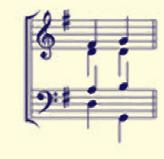
Obviously, these are simple examples, and things quickly become very complicated, since any note in one chord will have its particular function and a specific relationship to the next chord – all the more so in music which modulates all over the place or uses rich harmonies. So how can a choir cope with the complexities of these relationships and stay in tune?
I don’t believe it is possible for a
choir to work out or be taught every interval of a piece in this way; choir members are alert, intelligent and interested members of society, but cannot be expected to analyse all the harmonic relationships so that they can cope with the problem on their own. Nor is this necessary. What is rather necessary is that the director is aware of the pitfalls of just intonation. He or she can then advise the choir to make a certain interval larger or smaller as required –with a brief explanation of why this is the case. Sometimes it is sufficient to focus on one recurring interval. For example, when my choir performed Pearsall’s In dulci jubilo last Christmas, I made sure that the choir took the third of the melody slightly higher throughout, and we stayed perfectly in tune.
I myself have sung in many choirs since I was a small boy, but had never heard of just intonation until 35 years into my choral singing career (and 15 years after I started directing choirs).
The question I ask myself is: why is something so fundamental not generally known and taught? Ross Duffin begins his book How Equal Temperament Ruined Harmony (and Why You Should Care) with an anecdote about one of the world’s leading orchestral conductors who couldn’t get a chord progression played ‘in tune’ by his orchestra and, being ignorant of the effects of equal temperament, couldn’t understand why. I actually found the anecdote rather reassuring: whilst musicians are taught that equal temperament exists, and possibly also told that other temperaments used to be used, no one seems to teach the implications of such intervallic distortion for practical music-making. I was clearly in good company during my many years of ignorance.
And yet, like many singers with a good sense of pitch, I was actually acutely aware of just intonation the whole time. I intuitively knew when to sing a larger or smaller interval; it came
naturally to me and I didn’t even realise I was doing it. But I couldn’t teach it to others until I had some self-awareness and theoretical grounding.
I gained this theoretical underpinning by chance a few years ago when I stumbled on a book called Just Intonation in Choral Singing2. I simply devoured it and found that it expressed and explained everything I already knew but didn’t know how to say. Some of the maths was a bit complicated for me, but the upshot was that I now consciously understood why people sing intervals wrongly, and how this impacts on a choir’s tuning.
I am now able to teach my choir3 to sing the intervals which will keep it in tune. I am not saying we never go out of tune any more, and some tonally complex works (like Britten’s The Evening Primrose) still defeat me/us, but we can now sing entire a cappella concerts and remain bang on throughout. And if we do go out of tune, I can usually pinpoint an interval where a brief loss of concentration or a lack of awareness took us out.
The fundamental shift in perspective between other methods and this approach is that the focus is no longer on the note which is sung, but on the interval between the notes to be sung.
I believe that just intonation should form part of the standard knowledge of every choir director. If I can teach intervals to my mixed-ability choir, it must be possible to do it with any interested choral group. It would be wonderful if others do not have to live in ignorance as I did for many years, or have to chance on a scholarly German text before they find the way. There is a need for a simple manual on just intonation in a cappella singing aimed at choir directors.
Now I just need to work on the choir’s breathing, posture and vowels, and to keep them smiling!
Andrew Sims is the Director of the Embassy Singers in Berlin and a former Bradford Chorister.
Footnotes
1A. Ornitoparchus, De arte cantandi micrologus, Cologne, 1535, C2v.
2Before you get too excited, you should know that I found it in the Staatsbibliothek in Berlin, and that it is in German and is actually called Die reine Intonation im Chorgesang by Bettina Gratzki, Bonn, 1993, 300 pp.
3The Embassy Singers in Berlin, Germany: www.embassysingers.de
The 2009 season was a bumper year for sacred choral works, largely due to the four anniversary composers: Purcell, Handel, Haydn and Mendelssohn, I attended these concerts:
Prom 2 featured Haydn’s Handel-inspired oratorio The Creation, using Paul McCreesh’s new, more singable translation and enlarged forces from the Gabrieli Consort & Players, augmented by Chetham’s Chamber Choir. Haydn liked massed singers, so did the Proms audience.
Prom 6 offered an interesting comparison between two choral settings of the Seven Last Words from the Cross: Haydn’s, written just before the Creation and James MacMillan’s commissioned by BBC Television for Holy Week 1994. My counter-intuitive experience was that the modern work had warmth and passion whereas the baroque one seemed worthy but dull.
Prom 8 was a memorable occasion, celebrating the 800th anniversary of Cambridge University, with five complete college chapel choirs and singers from eleven others. Two hundred adult voices in the combined choirs gave Vaughan Williams Five Mystical Songs a powerful reading, stunning baritone Simon Keenlyside dominated all, with the BBC Symphony under Sir Andrew Davis, who later directed Caius, Clare and Trinity choirs in the Stanford canticles in A in the orchestral version: quite glorious. The combined choirs of King’s and John’s then breathed life into settings by Jonathan Harvey and Judith Weir. As the climax one felt a great choral ode would have been more fitting, exploiting the 32 choristers and two hundred other voices available, rather than Saint-Saëns’ Organ Symphony, which is often done and is not choral. In fact it was a great performance, involving the huge RAH organ played by Thomas Trotter but hardly a big solo opportunity for him. Surely he could have given us an improvisation on academic themes afterwards!
Prom 17 gave us four Bach motets, finely sung by excellent Monteverdi Choir under Sir John Eliot Gardiner.
Prom 24 featuredthe Berlioz Te Deum, with its dramatic dialogue between orchestra and organ (Simon Preston), done by the Bach Choir, plus Crouch End Chorus and choristers from St Paul’s and Trinity Boys, under Susanna Mälkki and the BBC Symphony Orchestra.
Prom 36 was an all-Handel concert by the Sixteen under Harry Christophers: we had the four Coronation Anthems, excerpts from Semele, an Organ Concerto (solo Alastair Ross) and a rarely heard early Salve regina, a glowing performance.
Prom 47 was Harry Bickets’ Proms debut, directing a memorable complete performance of Handel’s Samson, with the English Concert and seven star soloists, with Mark Padmore in the eponymous role.
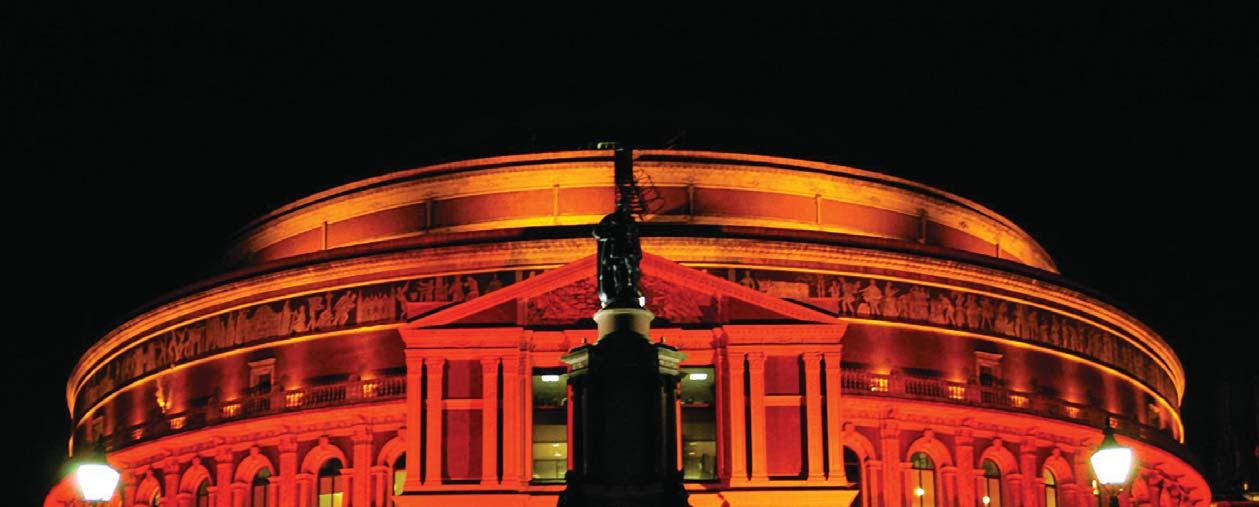
Prom 68 was the climax of the Handel year, a large scale rendering of Messiah, using a massed choir of young voices directed by Nicholas McGegan, a bright and inspired reading, with a wonderful quartet of soloists, plus the Northern Sinfonia.
Prom 71 was on the 75th birthday of Sir Peter Maxwell Davies, with two works Westerlings and Solstice of Light. The latter is a 50mins cantata celebrating the whole history of the Orkneys, where ‘Max’ now lives. It is scored for tenor soloist, choir and organ, with five interspersed solo organ episodes, superbly executed by David Goode. The tenor, Ed Lyon, sang his difficult part with admirable assurance.
July 16 Prom 1 at RAH Mahler’s ‘Symphony of a Thousand’ opens the 116th season, with massed choirs: Crouch End Festival Chorus, Sydney Philharmonia Choirs, choristers from Westminster Abbey, St Paul’s and Westminster Cathedrals over 400 singers altogether, plus the BBC Symphony Chorus and Orchestra under Jií Blohlávek.
Aug 17 Arvo Pärt’s St John Passion: BBC Singers, with instrumental and organ accompaniment under David Hill. Brindley Sherratt is Jesus and Andrew Kennedy is Pilate.
Aug 28 Beethoven Symphony No.9 in D minor (Choral): the annual performance, this year entrusted to a visiting orchestra from Minnesota but the choir is the BBC Symphony Chorus, the conductor, Osmo Vänskä.
Sept 10 The penultimate night offers a wonderful work: the Monteverdi Vespers of 1610 sung, of course, by the Monteverdi Choir, English Baroque Soloists and His Majesty’s Sagbutts and Cornetts, directed by Sir John Eliot Gardiner.
There are two solo organ recitals this year:
Sun Aug 1 Wayne Marshall plays four works by Wagner, transcribed by Edwin Lemare;
Sat Aug 14 David Briggs plays five works by Bach, including the celebrated Virgil Fox arrangement of Come Sweet Death (which Fox spun out to last 17 mins) and his own arrangement of the Suite No.3 in D. Both not to be missed!
There is one late-night organ solo:
Aug 4 Daniel Hyde plays the Canonic Variations on Vom Himmel Hoch BWV 769, preceding Stravinsky’s arrangement of the same work for choir and orchestra, to be done by the BBC Singers and London Sinfonietta under David Atherton, a seductive package.
John Burgess, Badminton, Gloucester
Sir: We all appreciate the need for choir rehearsal and many rehearse in the Quire prior to Evensong. But some continue almost up to the start time of the service. With apologies to the ones I am about to mention, who are probably not alone in this practice, I have had recent experiences at Lichfield, Tewkesbury and Wells where rehearsals have not ended until three-minutes before the service starts.
With worshippers milling around chatting at the Quire gates, I feel it is very bad form when entry is barred until so close to the start. At best, there tends to be a rather undignified scramble for the ‘prime’ seats and once seated, one has no time to gather one’s thoughts in preparation for the service.
Examples of good practice are Westminster Abbey and King’s College Cambridge, where rehearsals finish and entry is allowed 15 minutes prior to service start. Gloucester also has an excellent arrangement, where worshippers are allowed to quietly
All general points and comments welcomed. Please send letters by 6 August 2010 to: The Editor, 21 Belle Vue Terrace, RIPON, North Yorkshire HG4 2QS ajpalmer@lineone.net Letters may be shortened for publication.
gather in the Quire whilst rehearsal is in progress –and in any case, it is rare for Gloucester not to finish 15 minutes before a service.
Through the pages of CATHEDRAL MUSIC, I wonder if I can make a plea for all rehearsals in Quires to finish a minimum of 15 minutes prior to service? This would allow all of us to quietly take our seats, enjoy a peaceful period for reflection, and prevent any unfortunate impression that Evensong is a choral performance rather than Divine Office.
Dr Katherine Hill, Sheffield
Sir: I would like to say how much I enjoyed reading the last edition of CATHEDRAL MUSIC (2/09): the reviews of the choral CDs, the interviews and your interesting editorial on the success of the Chorister Outreach Programme with primary schoolchildren. I think the Government, et alia, should be congratulated on such an innovative idea! Here at Sheffield Cathedral it has been a huge success story. Each term
four schools are visited by some of the choristers, and an experienced music teacher. They are led by Neil Taylor, our Master of Music. After learning and practising the songs in the schools, the end-of-term concert is ‘put on’ at the Cathedral, which is always well attended by parents and families, especially at Christmas time. It is always an inspiration to hear the children sing with such enthusiasm and enjoyment Many of the children and parents have never been in the Cathedral before so it is an exciting experience for them. I am sure some of the children do not sleep the night before because of the excitement! A ‘young voices’ choir has now developed as a result of the project, which practises regularly and sings at the concerts. As this is a church programme, I am always pleased when one song is of a religious nature which tells the children something of the love of the Lord Jesus Christ, our Saviour, for them.
I might add that I met one teacher after a concert who said that some of her pupils read better as a result of the singing. I hope and trust that the ‘Chorister Outreach Programme’ long continues.
August 22nd - 29th 2010
The 55th Festival of Church Music within the Liturgy at the Priory Church of St Mary

Edington (near Westbury in Wiltshire)

Information from John d’Arcy, The Old Vicarage, Edington, Westbury Wiltshire BA13 4QF
Tel: 01380 830512
www.edingtonfestival.org

Andrew Lucas
ISBN 978-0-9502514-5-5 Price £6.95
Published by
The Fraternity of The Friends of St Albans Abbey
Andrew Lucas gives a thorough account of the musicians and organists of St Albans from 1300 to the present day. Drawing on earlier sources cited in the preface, the book is arranged in nine chapters dealing with such topics as early organs, the Hill organ (1861), the Willis rebuild (1929), the ground-breaking work of Harrison & Harrison in 1962 and 2007-9 and with musical personalities connected with the Abbey and (from 1871) the Cathedral. In addition to detailed stop lists there are many excellent illustrations and photographs (including one of the Hill organ case in 1905, looking like a row of giant pencils in the manner of Hill’s 1885 arrangement at Beverley Minster). There is much fascinating detail in this well-produced, well-organised and informative account. An excellent read and well worth the money.
 Alan Spedding
Alan Spedding
Enid Bird
£7 orders from Enid Bird at 16 Miller Avenue, Sandal, Wakefield WF2 7DJ
Enid Bird has updated her delightful book on cathedral music in Wales. Although the entry for St Davids Cathedral only goes as far as 1991, it is nicely presented and contains quite a lot of useful information on the organs of the various Welsh cathedrals and fascinating insights into many of the organists. I had forgotten that Bryan Hesford was organist at Brecon before David Gedge. How many of us have music in our libraries arranged by Bryan and published by Cramer? Enid Bird’s first book on the lives of 20th Century English Cathedral Organists is still as useful as it was when published in 1990, and it would be good to see this book updated too. In the meantime, if you have the book on English organists then the edition on Welsh organists will be a worthy companion.
 Patrick Mayhew
Patrick Mayhew

Trevor Beeson
ISBN 978-0-334-04193-1 £19.99 246 pages
SCM Press
In his foreword to this enjoyable and useful book, Beeson wonders whether it should have preceded its forerunners on bishops, deans and canons. Doesn’t he realise that the best people always come last? This is an interesting survey predominantly of the Anglican scene, from about 1840 to the present. It’s a pity he doesn’t cast his eye very much over what went before, but it’s a well-researched tour d’horizon. If you dip in here and
there, as I did initially, you will find most of the people you expected to see and the competent index helps you to follow up trains of thought stimulated by what you read. It is all the better, I think, for not being scholarly as such, but it is, on the whole careful and reliable, more benign and less tendentious than some of his earlier writings. Beeson draws on his own career and the Acknowledgements section is an enviable catalogue of eminent church musicians he has known and worked with. Funding and the need to maintain (or in many places) raise standards are two important issues for us now (Beeson even offers some mildewed hosannas for the FCM) but as important is the need to recognise the value of music to individual worshippers. It can raise us to heaven; in too many places it drives us to distraction.
Trevor Beeson has done us a service in researching (with his able assistant Fiona Mather –whom he acknowledges in the ‘credits’) and preparing what is a useful and readable book. There are helpful and well-informed suggestions for further reading.
Richard OsmondRequiem; Adam lay Ybounden; Advent calendar; A spotless rose; Jesus Christ the apple tree; In the bleak midwinter; Lie still and slumber; Good Christian men, rejoice; If ye love me; Loving Shepherd of thy sheep; Do not stand at my grave and weep; O master let me walk with thee; Christ’s journey; This joyful Eastertide. The Choir of Christ’s College, Cambridge.
Directors: Sir Philip Ledger & David Rowland. Organ: Roxy Summerfield.
REGENT REGCD305 TT 70:22



Sir Philip has enjoyed a distinguished career as a leading church musician and academic. As conductor, pianist and harpsichordist he has performed all over the world and many former students recall his inspirational choral training with pleasure.
This CD presents a retrospective view of his choral music written between 1992 and 2008. The influence of Benjamin Britten, with whom he worked closely while he was Artistic Director of the Aldeburgh Festival, is apparent in the form of Ledger’s most extensive work, the eponymous Requiem, a thanksgiving for life. Like Britten, he intersperses texts from the Latin Missa pro Defunctis with poems. Here the similarity ends, however, because, whereas Britten was concerned with the horrors of war, Ledger celebrates life. He chooses the mystic poems of Thomas Traherne and, in the Latin sections, concentrates on the more consolatory passages, avoiding completely the terrors of the Dies Irae. Many of the shorter items on the CD are settings of familiar texts set previously by other composers, Adam lay ybounden, A spotless rose, In the bleak mid-winter, for example, inviting comparisons. To redress the balance there are sensitive settings of the poetry of Rowan Williams (Advent Calendar), Timothy Dudley-Smith (Hush you, my baby) and Washington Gladden (O Master, let me walk with Thee) which demonstrate Ledger’s direct and approachable musical expression.
 Alan Spedding
Alan Spedding

Taverner Dum transisset Sabbatum (two settings); Leroy Kyrie; Missa Corona spinea; O splendor glorie. The choir of St Mary’s Cathedral, Edinburgh.
Director: Duncan Ferguson.
DELPHIAN DCD34023 TT58:10
This disc is the third in a series issued by Delphian and follows recordings of music by Weelkes from Tewkesbury and Wise from Gonville & Caius College, Cambridge. Duncan Ferguson’s informative sleeve notes tell us that John Taverner was at work during the first part of the sixteenth century and held posts at Tattershall, Oxford and Boston. The choir of St Mary’s Cathedral, Edinburgh is slightly scaled down from its usual size to just ten trebles together with four altos, four tenors, three baritones and three basses, which is reckoned to be closer to the size of ensemble that would originally have performed this music.
This disc impresses in a number of ways. Firstly, the music itself is relentlessly interesting with constantly evolving textures and some wonderfully involved counterpoint. The second aspect is the quality of the recording. The engineers are to be congratulated on managing to strike a perfect balance between clarity and atmosphere. Throughout the disc the individual parts can be heard clearly, together with St Mary’s generous acoustic. The icing on the cake, though, is the choir’s performance itself. The choir sings with total commitment and produces music of the highest quality. Any serious collector of recordings of cathedral music should not be without this disc. Highly recommended.
Tim RogersonParry I was glad; Moore Through the day; All wisdom cometh from the Lord; Bairstow Blessed City; Let all mortal flesh; Gibbon O Lord in thy wrath; Howells A hymn for St Cecilia; Philips Ecce vicit Leo; Macmillan Factus est repente; Stanford Justorum animae; Bruckner Christus factus est; Ireland Greater love; Wood Hail, gladdening light; Poulenc Timor et tremor; Rutter The Lord bless you and keep you; Dyson Magnificat in D. Guildford Cathedral Choir.
Director/Organ: Katherine Dienes-Williams & David Davies. Organ Scholar: Alex Berry.
HERALD HAVPCD 352 TT 64:26
This is a substantial programme, splendidly sung by Guildford Cathedral Choir, directed by either Katherine Dienes-Williams (boys and men or boys, girls and men) or the now departed David Davies (girls and men). There is a nice mix of a cappella and accompanied numbers; the Bairstow, Stanford and Ireland sounding powerful and vibrant, the Howells grabbing the emotions especially. Seldom have I heard this cathedral organ sound more impressive, just listen to the Tubas at the start of the Parry track. Whether there is sound enhancement matters not, the choir is in magnificent voice and the recorded perspective the best ever, even compared with the pre-acoustic plaster sound of the Guild Records era. The top line is always strong and clear where needed and girl v. boy spotters can test their voice recognition powers, because the two groups happen to alternate in a random way, then are combined for the first and last works. The key is in the booklet. A couple of organ solos would have been welcome, taking advantage of the organ being so strikingly well-tuned and in such superb voice.
Roger Tucker
20 favourite chants. Cantus Gregoriani.
Director: Philip Arkwright.
PRIORY PRCD 1027 TT 67:28
A generous acoustic provides the all-male and Liverpool-based vocal ensemble Cantus Gregoriani with a warm glow and helps smooth out occasional vocal tightness. This recording was in fact made in the Lady Chapel of Liverpool's Anglican Cathedral, although the venue is not given. To hear plainsong performed beautifully is a wonderful and possibly rare privilege and here there is much to
recommend the singing – but beautiful it is not. With such a fine acoustic it would have been helpful to hear more time between the phrases of the plainsong chants as well as shading off more at the ends of phrases. Diction, tuning and ensemble are all mostly good, but overall the performance lacks the spiritual dimension that would have originally initiated these ancient chants.
David TrusloveLarge-scale anthems from the Victorian era.
SS Wesley Ascribe unto the Lord; To my request and earnest cry; Goss The wilderness; Ouseley It came even to pass; Walmisley If the Lord himself; Stainer I saw the Lord.
Boys and Girls of Exeter Cathedral Choir.
Directors: Andrew Millington and Stephen Tanner.
Organ: Paul Morgan.
HERALD HAVPCD 347 TT 67:24





The subtitle of this CD is Large-scale anthems from the Victorian Era. Of the five composers featured in this recording, S.S.Wesley commands the top spot and the inclusion of two of his anthems reminds us of his important contribution to church music, in this year which marks the bi-centenary of his birth. The current Exeter Cathedral Choir is much different from what Wesley would have known during his time in the city both numerically and in terms of quality. We have all grown so used to hearing Wesley’s Ascribe unto the Lord that we run the risk of not appreciating what a wonderfully uplifting and superb composition it is, but the 20 boys and 12 gentlemen on this recording demonstrate it magnificently. The other Wesley work, To my request and earnest cry, was said not to have been performed in full in his lifetime and here we have it sung with intensity and sensitivity. The lengthy bass solo in this work with its busy organ accompaniment is particularly attractive. Goss is represented by his version of The Wilderness sung by the 20 girls and men and contains some wonderful harmonies in the full choir sections; a pity it is not performed more often. It came even to pass by Gore-Ouseley, founder of St Michael’s College, Tenbury, has a strident hymn-like opening and continues to a triumphant conclusion. Walmisley’s contribution comes across as a typical Victorian anthem and its busy concluding ‘Hallelujah’ echoes the choral style of Mendelssohn. The final work, Stainer’s I saw the Lord, is a fine work of colourful contrasts and reminds us that there was much more to this composer than we ever hear. The Cathedral choir is in fine fettle and Paul Morgan’s organ accompaniment, in this the year of his retirement after 41 years at Exeter, confidently supportive. The accompanying booklet lacks text for the anthems which spoils what is otherwise an excellent production by Herald.

 Trevor Godfrey
Trevor Godfrey

Polyphony. Britten Sinfonia.
Director: Stephen Layton.
Soprano: Julia Doyle.
Countertenor: Iestyn Davies.
Tenor: Allan Clayton.
Bass: Andrew Foster-Williams.
HYPERION CDA67800 2 CDS TT 134:01
Arguments for and against historical authenticity in performance have raged across the musical scene for decades and definitive versions of Handel’s music have been presented to the musical public. The trouble with Messiah, Handel’s most-loved work, is that he himself performed it differently according to circumstances each time he directed it. Stephen Layton’s interpretation is based on previous experience of performing the work in a variety of ways – with small choirs, large choirs, in a foreign language, at a variety of pitches and in a number of different temperaments. His aim is always to get as close to the message Handel wanted to convey and in this performance he succeeds triumphantly. Messiah was the work most close to Handel’s heart and he himself was not content merely to entertain his audiences – he wanted, as he said, ‘to make them better’. Layton’s straightforward approach takes a balanced view of insights provided by musicologists, as any Handel conductor is bound to do, but also allows the music to speak directly. Tempi are sensibly maintained, varied ornamentation is tasteful and the Britten Sinfonia’s orchestral
accompaniment is well integrated, allowing the dramatic narrative to evolve naturally. Like any conductor, Layton knows that performing Messiah ‘is a spiritual journey every time’. He is served well by his own choir, Polyphony, and is able to achieve enviable clarity and a range of dynamics especially in the well-paced dramatic complexes. There are some lighter moments in the interpretation – the choir sounds rather pleased to be running amok in All we like sheep, for example, until brought down to earth at the solemn end of the chorus. The soloists are excellent, from the radiant soprano of Julia Doyle, through the beautifully modulated countertenor of Iestyn Davies and the warmth and intelligence of Allan Clayton, tenor, to the magnificent yet agile bass of Andrew Foster-Williams. A fine performance which reaches to the heart of the music. Highly recommended.
Alan SpeddingOculus non vidit; Ave Maria III; Miserere mei; Hail, Queen of Heaven; Duo Seraphim; Felix namque es; Stetit Angelus; Gloria Patri; Missa de Spiritu Sancto; Hodie Christus natus est; Ubi caritas; Ave Maria I.
The Choir of Royal Holloway.
Director: Rupert Gough.
Organ: Alexander Norman.
HYPERION CDA67799 TT 67:03
This is music born of adverse conditions. Rihards Dubra (b.1964) was brought up as a Roman Catholic under the Soviet regime in Latvia. As with many such suppressed nations, the Latvians developed a strong choral tradition to which Dubra was inspired to contribute an increasing number of compositions to Latin texts, developing a style fusing minimalism with neo-Romanticism informed by plainchant, mediaeval and Renaissance influences. His Mass setting, accompanied by the organ (needing an extra hand at times!), although commissioned by the (secular) Lithuanian Academy of Music would be at home as part of the liturgy. Hodie Christus natus est is a delightfully simple setting of the Christmas text. Equally direct is Felix namque es. The most striking setting of the Revelation text Stetit Angelus displays control of expressive choral effects and subtle word painting. Rupert Gough draws some ravishing performances from his excellent Royal Holloway Choir, singing in the warm acoustic of St Alban’s, Holborn. Once again we are in debt to Hyperion for introducing this distinctive music to the public. Highly commended.
Alan SpeddingMason A prayer of St David; Walker I will lift up mine eyes; Bullock Give us the wings; Brahms How lovely are thy dwellings; Harris Behold the tabernacle; Bairstow Blessed City; Tallis O nata lux; Stanford Evening Canticles in C; Blatchly For the fallen; Jenkins Agnus Dei; O Living Bread; L’Estrange On Eagles’ Wings; Briggs The St Davids Service. The Choir of St Davids Cathedral.
Director: Alexander Mason.
Organ: Simon Pearce.
REGENT REGCD318 TT 68:31
It is a never-ending source of wonder that St Davids Cathedral, in Britain’s smallest city, can sustain a choir capable of maintaining such high standards as produced in this CD. ‘Blessed City’ it can justifiably be called. The accompanying leaflet reminds us that the present choir is unique in the UK in that its top line consists of girls aged 8-18. The CD’s fifteen tracks range over a wide range of music from composers such as Tallis to Karl Jenkins in well and lesser-known choral settings. Only one foreign composer, namely Brahms, is included. The CD opens with a lively ‘wake-up’ call, A Prayer of St David, by Alexander Mason, Organist and Master of the Choristers at St Davids. The CD proceeds in a calmer and more reassuring vein with seven tracks of more traditional choral masterpieces and ends with works by four contemporary composers plus the delightful anthem O Living Bread! Who once did die by Percy Whitlock, a composer who wrote all too little during his short and rather sad life. Altogether a most enjoyable production.
 Trevor Godfrey
Trevor Godfrey

Fayrfax Missa Albanus; Aeternae laudis lilium; Taverner Missa Corona spinea; Missa O Michael; Missa Gloria tibi Trinitas; The Western Wynde Mass; Missa Mater Christi sanctissima; Missa Sancti Wilhelmi devotio; Gaude plurimum; Sheppard Missa Cantate; The Western Wynde Mass; Libera nos, salva nos; Gaude, gaude, gaude Maria; miraculum; Vox Patris caelestis; Adolescentulus sum ego.O Lord the maker of all things; Magnificat & Nunc Dimittis ‘in medio choris; The Secret sins; Beatus et sanctus. The Sixteen.
Director: Harry Christophers.
HYPERION CDS44401/10
10 CDs TT 11 hours 25 mins.
What a good deal these 10 CDs are. The music spans the Golden Age of English Polyphony and was recorded between September 1982 and December 1992. What we have, and the little space afforded me here cannot do justice to this collection, is exquisite music where the choir feels every note and takes us to that ethereal plane with excellent singing which the Hyperion sound engineers over the years have captured perfectly. And to boot Stephen Rice’s notes are good too.
We begin with Robert Fayrfax and the Missa Albanus is splendid and then we move on to the superb recordings contained within five of the 10 CDs of the music of John Taverner with six Masses as well as shorter pieces before moving on to John Sheppard, followed closely by William Mundy of O Lord the maker of all things fame. These discs are fantastic value and with The Sixteen on top form you can’t afford to be without this collection of reissues. Highly recommended.
Patrick Mayhew

Franco Salve regina; de Padilia Deus in auditorium; Mirabilia testimonia;Lamentation for Maundy Thursday; Salve regina; Capillas Alleluia.Dic nobis, Maria; Magnificat quarti toni; de Salazar O sacrum convivium.
Westminster Cathedral Choir Director: James O’Donnell. Organ: Iain Simcock.
HYPERION CDH55317 TT 65:12
Recorded over twenty years ago by Hyperion and now newly released on the Helios label, this valuable disc loses none of its impact and is still, remarkably, one of only a handful of discs featuring the music of Juan Padilla. While one cannot fail to be impressed by the full bodied and enthusiastic boys’ tone, who take both treble and alto parts, some restraint and a more relaxed sound sometimes would not go amiss. The rich sonorities of Padilla’s six-part Lamentation for Maundy Thursday is magnificently sung but occasionally there is an over exuberance of treble sound. An extended setting of Salve regina by Hernando Franco and Antonio Salazar’s O Sacrum Convivium make rewarding listening, as do two works by Francisco Capillas. This disc has done much to improve our awareness of Hispanic choral music and uncovered a few treasures on the way.
 David Truslove
David Truslove
Léonin Alleluya Non vos relinquam orphanos; Alleluya Dulce lignum, dulces clavos; Alleluya Spiritus Sanctus procedens; Alleluya Paraclitus Spiritus Sanctus; Priusquam te formarem; Alleluya Inter natos mulierum; Viderunt omnes fines terre; Alleluya Dies sanctificatus illuxit nobis; Alleluya Pascha nostrum immolates est.
Red Byrd.
John Potter.
Richard Wistreich. Cappella Amsterdam.
HYPERION CDH55328 TT 71:10




In a reissued CD devoted to Magister Leoninus the combined forces of Red Byrd and Cappella Amsterdam make a very persuasive case for the late 12thcentury Parisian composer. This all-male ensemble, whose names (apart from

John Potter and Richard Wistreich) are regrettably withheld, beguile us with their fine singing and allow us to enter a world where just two interweaving vocal lines can be utterly mesmerising. In Alleluya, Dulce lignum, dulces clavos (amongst other motets) a wonderfully tranquil plainchant, is combined with the florid two-part writing of compelling beauty. The music’s rhythmic complexity and the single-voice verse sections are dealt with superbly. Paraclitus Spiritus Sanctus –a motet for Pentecost –is especially rewarding. If your understanding of medieval organum is slight or your knowledge of texts from the first part of the liturgical year has yet to be developed, you will still be able to appreciate the superb musicianship at work here.
David Truslove
Arr Mooney The Bells of the Angelus; Lord of all hopefulness; Fáilte Romhat, a Ri na nAingeal; Queen of the May; Deuss Meusl Ag Críóst an Siol; Is Maith an Bhen Murie Mhór; A osa Glan Mo Chroise; an tAiséiri; Dóchas Linn Naomh Pádraig; Fauré Pie Jesu; Franck Panis Angelicus; Mendelssohn Oh, for the Wings of a Dove; Maher Soul of my Saviour; Handel I know that my Redeemer Liveth; Haydn Missa Brevis in F; Gregorian chant Tantum Ergo; Salve Regina. Trad Haiul Queen of Heaven; Bi ’osa im’ Chroise.
The Palestrina Choir of St Mary’s Pro-Cathedral, Dublin. Orchestra of St Cecilia.

Organ: David Connolly and Gerald Gillen. Harp: Denise Kelly.

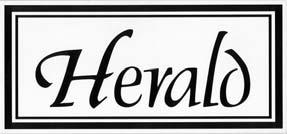
Director: Blánaid Murphy.
PALESTRINA CHOIR LABEL 689076384155 TT 76:10
Whereas in the last edition I reviewed hymns sung by the Choir of Ripon Cathedral presenting a programme in the Anglican tradition, the Palestrina Choir of Dublin sings a variety of music mostly of the Roman Catholic Church. There are eleven arrangements of hymns by David Mooney (many sung in Irish) and several treble solos (Fauré’s Pie Jesu and Mendelssohn’s Oh, for the wings among them) are contributed by the excellent Head Chorister, Diarmuid Sugrue (one of four brothers singing in the Choir). Apart from the hymns, Haydn’s early Missa Brevis in F (Hob XXII) is performed and the whole programme is topped and tailed by the plainsong chants Salve Regina and Tantumergo sung by the trebles. The choir of twentythree boy choristers and sixteen gentlemen is ably directed by Blánaid Murphy in the generous acoustic of St Mary’s where she has been Choir Director since 2002. The mother church of the Dublin Archdiocese is fortunate in having a choir of such quality to enhance its services.
Alan Spedding


Suite de Lorca; Canción de nuestro tiempo; Canticum Mariae virginis; Magnificat; Our joyful’st feast; Halavan himmeän alla; Die erste Elegie. Schola Cantorum of Oxford.
Director: James Burton.
HYPERION CDA67787 TT 72:19
Einojuhani Rautavaara has put Finnish choral music on the map internationally and this CD testifies to the richness of his invention, which has led him to compose, like Rutter, in response to choir commissions. His increasingly accessible style has achieved growing popularity, and not just in Finland: the four movement Suite de Lorca is a case in point. With its four intense, short movements (each under two minutes) it makes an ideal opener for this sequence of a cappella works. The second work here was commissioned in 1993 by the Tokyo Philharmonic Chorus to have contemporary relevance; so ever-topical ‘20s and ‘30s poems by Lorca were chosen as texts. Our joyful’st feast was written for the 2008 EBU Christmas radio hook-up and is a setting of English Renaissance verse, which Rautavaara aptly described as having ‘a robust joyfulness’. The diverse programme is superbly sung in Spanish, Latin, English and Finnish by the Oxford Schola Cantorum (1960), a mainly student choir of about 35 singers, under its director, James Burton. There are some impressive soloists and plenty of choral tricks, glissandi, etc. This is the choir that in 2006 sponsored the controversial jazz Evensong and in 2007 a jazz Matins, two oxymoronic concepts, on which there is no space to comment here!
Roger Tucker
Richard Dowling; tenor
Joanna Smith; piano
Vaughan Williams, Quilter Songs

Piano Music
Andrew Wright
The Bliss of Solitude
Performed by the composer on the organs of Wakefield Cathedral. Works include: Carillon de Wakefield, Little Suite, Deo Gratias, Cornish holiday, Francis’ Fandango & Nine variations
Voces Urbanae
Director: Christopher Watson
Organ: Clive Driskill-Smith Works include: De Profundis (Commissoned for the Choir of Christ Church Cathedral, Oxford) , Magnificat, Ave Verum Corpus,
Directed by: Katherine Dienes-Williams and David Davies. Including Anthems by; Parry, Bairstow, Gibbons, Howells, Philips, Ireland, Wood, Rutter Dyson, Stanford, Bruckner

Lassus Missa Venatorum; Magnificat septimi toni; Tallis O sacrum convivium; Nunc dimittis à 5 ; Loquebantur variis linguis; Praetorius Magnificat quinti toni; Sheppard Reges Tharsis et insulae; Morales Magnificat primi toni; Philips Ecce vicit Leo. Cheltenham College Chamber Choir. Director: Alexander Ffinch.
HERALD HAVPCD 351 TT 57:48





This chamber choir needs no excuses about being amateur and schoolbased, it clearly can hold its own with professional groups for the crucial qualities of ensemble and intonation. In a testing programme of Renaissance polyphony like this one, there is no sagging or flagging from these young singers. The choir was founded by the College Organist, Alexander Ffinch, in 2007, as an a cappella group, with a leaning towards Renaissance polyphony, able to take a programme like this one in its stride. This, their first CD, was recorded in May 2009 in the large and splendid college chapel, with its fine stone vaulting creating the resonant acoustic needed for music of this period. The choir’s tone and diction is exemplary.
Roger TuckerDupré Ave Maris Stella I, II, III and IV; Eccard When to the Temple Mary went; Vierne Messe Solennelle; Byrd Senex Puerum; Rachmaninov Nunc dimittis; Radcliffe Preces & Responses; Harwood Magnificat in A flat; Stainer Phaos Hilaron; Maw Lead kindly light; Philips Maria; Wood Hail Gladdening Light; Britten A hymn to the Virgin; Victoria Ave Regina Coelorum.
The Choir of Oriel College, Oxford. Director: Andrew Furniss.

Organists: Alexander Morrison and David Maw.
OXRECS OXCD-102 TT 73:40
New from the choir of Oriel College Oxford (although recorded in 2007) is an interesting Candlemas compilation combining four settings of Ave Maris Stella for organ by Marcel Dupré with choral pieces that celebrate the Purification of the Virgin Mary –an essential component of Candlemas. In addition there is Vierne’s festive Messe Solennelle, given an enthusiastic if not completely convincing performance. The end of the Kyrie has an unfortunate early soprano entry that too eagerly anticipates what could have been a most thrilling climax. Better suited in many ways to these young voices is the delicate shades achieved in Byrd’s Senex Puerum and Philips’s Hodie Beata Virgo Maria where the singers are unaccompanied and not stretched beyond their means. Basil Harwood’s Magnificat also finds them on sure ground which includes too an attractive soprano solo passage. Perhaps the most uniformly successful performance on the disc is Britten’s A Hymn to the Virgin where ensemble, blend and tuning are well sustained –all the more pity the engineer couldn’t prolong the final chord for longer.
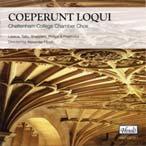 David Truslove
David Truslove

Chapel.
Andriessen Thema met Variaties; Rheinberger Sonata No 8; Peeters Toccata, Fugue et Hymne sur Ave Maris Stella; Mendelssohn Sonata No 6; Bach Passacaglia in C minor.
REGENT REGCD306 TT 65:52
The Klais organ in Haileybury Chapel was built in 1998 and is the fourth instrument to be installed in the chapel. It is not a large instrument, comprising 30 speaking stops, but has sufficient tonal resources to do justice to this ‘themed’ programme of works written over a period of more than 200 years. Each of the works is based on a theme, which recurs and includes
a set of variations, which gives the performer an opportunity to demonstrate the qualities of the instrument. Undoubtedly, the most successful work on the disc is the Bach Passacaglia and Fugue, where the ‘Germanic’ choruses sing to good effect. Derek Longman, who has been on the music staff at Haileybury for over 30 years, plays the programme competently with a rather refined elegance and in doing so provides a showcase for this interesting instrument.
Tim Rogerson
Willan Prelude and Fugue in C minor; Introduction, Passacaglia and Fugue in E flat minor; Darke Fantasy in E; Witlock Plymouth Suite; R V Williams Romanza (Symphony 5); Sanders Toccata; Callahan Aria.
OXRECS OXCD-104 TT 67:21
The organ of Chester Cathedral dates in the main from 1910, when pipework from a previous instrument was included, and also includes pipework from more recent work in 1969 and so is perfectly suited to this programme of 20th century British works. The programme is framed by two substantial works by Healey Willan, who emigrated to Canada in 1909. Whilst the Prelude and Fugue in C minor is rather academic, the Introduction, Passacaglia and Fugue is widely regarded as one of the finest Englishromantic works for the organ. Philip Rushforth uses the full variety of tonal resources of the Chester instrument to bring a large amount of colour to his performance, whilst maintaining a lively tempo. The Plymouth Suite was written soon after Percy Whitlock had returned from the 1937 conference of the Incorporated Association of Organists, which had been held in Plymouth. He dedicated each of the movements to an organist who had been present at the conference. Like all of Whitlock’s music, the Suite is full of memorable tunes and none more so than that of the fourth movement, Salix. Philip Rushforth more than manages to capture the mood of the opening Allegro Risoluto and presents a convincing performance of the wellknown Toccata. John Sander’s Toccata deserves to be better known and played more often, as it is both tuneful and relatively short. Charles Callahan studied composition with Flor Peters. His Aria is a beautiful miniature, which explores some of the softer stops of the organ. Another interesting disc from Philip Rushforth and OxRecs.
Tim Rogerson MAX REGER
MAX REGER
Marcus Becker Piano.
Prelude & Fugue in D; O mensch, bewwin’ dein’ Sünde Gross; Durch Adams Fall ist ganz verderbt; Herzlich tut mich verlangen; Wenn wir in höchsten Nöten sein; Ach wie nichtig ach wie flüchtig; Nun danket alle Gott; Valet will ich dir gebenl Es ist das Heil uns kimmen her; Liebster Jesu, wir sind hier; Von HImmel hoch, da komm ich her; Prelude & Fugue in E Flat ‘St Anne’; Prelude & Fugue in E minor ‘The Wedge’; Christ lag in Toesbanden; Ich rif’ zu dir, Herr Jesus Christ; An Wasserflüßliger Babylon; Komm, heiliger Geist; Schümcke dich, o liebe Seele; Das alte Jahr vergangen ist; Toccata & Fugue in D minor.
HYPERION CDA67683 CD1 TT 55:03 CD2 TT 55:16
The first composer to pay attention to Bach’s organ works as suitable material for piano transcription was the great pianist, Liszt. His approach to these works, unlike his ‘paraphrases’, shows his attempt to transfer Bach’s intentions as faithfully and as reverentially as possible to the piano. Since then Liszt’s pupil Carl Tausig, the Russian pianist Samuel Feinberg, Ferrucio Busoni, Ignaz Friedman and Max Reger have ventured into similar territory. Max Reger is, however, the only composer apart from Saint-Saëns whose skills as a pianist were matched by his gifts as an organist. In these transcriptions, therefore, we hear the virtues central to the piano and the organ: subtle use of pedalling, the contrasted sonorities of the registers of the keyboard, depth and weight of tone and delineation of individual voices in the former and the devotion to articulation in the latter. Markus Becker here performs a well-balanced selection of Reger’s chorale prelude transcriptions contrasting them on each disc with three of Bach’s great prelude and fugue pairings and concluding with the Toccata and Fugue in D minor. Purists will question the inclusion of the Prelude and Fugue in D major
and the Toccata and Fugue in D minor but Reger’s transcription of both is masterly despite the disputes concerning their authorship. These transcriptions belong firmly in the Romantic period where one expects a somewhat ‘tempo rubato’ approach and an emphasis on virtuosity. There are, however, instances in this recording, notably the chorale preludes, where Reger’s treatment of the original work is remarkably restrained and reverential. In contrast the technical demands of the Prelude and Fugue in E minor‘The Wedge’ and the Prelude and Fugue in E flat major‘St Anne’ are significant, requiring amongst others the challenge of accommodating the pedal part as left-hand octaves whilst at the same time playing the tenor part with the left hand in a manner not dissimilar to Liszt’s famous ‘threehanded technique’. Becker’s performance of these works is impeccable, balancing linear and polyphonic clarity with the expressive qualities of the piano and of virtuoso technique and respecting the historical context of both the original works and Reger’s transcriptions.
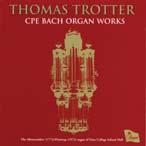 Ann Parsons
Ann Parsons
Andrew Canning plays the Ruffatti Organ of Uppsala Cathedral, Sweden.
Schmidt Prelude & Fugue in D ‘Halleluja’; Frescobaldi Begamasca; Sjögren Three Legends; Lindberg Introitus Solennis; Old Swedish folktune from dalecarlia; des danses; Albright Sweet Sixteenths – a concert rag for organ; Landmann Variations on a theme by Handel; Glass ‘Satyagraha’ Act III –Conclusion; Canning Scherzo
PRIORY PRCD 1010 TT 75:29
Uppsala Cathedral contains two organs (an eminently sensible arrangement, which I am certain would benefit many of Britain’s great cathedrals, if money were no object). The first is at the west end and dates from 1871. The second instrument is the one recorded on this disc and was built much more recently by Fratelli Ruffati of Padua in Italy in the north transept of the cathedral. The organ’s specification is fairly similar to a typical eclectic ‘English cathedral’ organ, comprising four manual departments, three of which are enclosed and a pedal division which includes two 32’ stops. Andrew Canning has been involved with the music at Uppsala Cathedral since 1996, having moved to Sweden in 1991 after studying at the Royal Academy of Music. His programme (like most of the works included within the Great European Organ Series) strays well into the unknown and so gives the listener the opportunity to hear some unfamiliar works. The organ itself is a tremendously exciting instrument with an enormous tonal spread, which is more than capable of doing justice to this fascinating programme, which is played thrillingly by Andrew Canning. A disc that is well worth buying!
Tim Rogerson
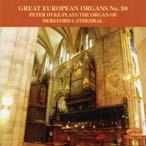
Dyson Variations on Old Psalm Tunes Book 1; Variations on Old Psalm Tunes Book 2; Darke Chorale Prelude on a theme by Tallis; Dyke A Wedding Prelude; Elgar arr Dyke Variations on an original theme (Enigma).
PRIORY PRCD 1029 TT 77:25
‘Darke, Dyke, Dyson, Elgar’ reads rather like a school register and there is much to be learnt from this disc of music played on Hereford’s famous Willis organ, the first since the completion of the most recent restoration work. Peter Dyke opens his programme with two of Dyson’s three sets of Variations on Old Psalm Tunes. These works were composed towards the end of Dyson’s life and allow the performer to demonstrate the varied colours of the Hereford instrument. Most of the tunes upon which the pieces are based will be familiar to readers of CATHEDRAL MUSIC. The Darke Chorale Prelude is more widely known and receives a thoughtful reading with a wellmanaged build-up to the central climax before dying away to an almost inaudible conclusion. Peter Dyke’s A Wedding Prelude was written to commemorate the 10th Wedding Anniversary of Chris and Meryl Lovatt in 2002 and was subsequently played at the wedding of Peter Philips and Autumn Kelly. Like all good chorale preludes the accompaniment provides
interest on its own account before the tune (in this case When I fall in love) appears as a cantus firmus in the tenor part. The time has passed (thankfully) when organ transcriptions were frowned upon and the last few years have seen a number of orchestral works being transcribed for organ. Peter Dyke’s work on Elgar’s masterpiece aims (in his own words) “…not so much to copy Elgar’s orchestral colours and effects but to use the particular qualities of the organ to view the music from a new and revealing angle”. He might have added that it also provides an opportunity to hear the magnificent variety of colours of a modern English cathedral organ. The only reservation that I have about this rendition is that the overall tempo is rather slow, which prevents the realisation of the full excitement of some of the variations. On the other hand this does allow rather more time for capturing some of the detail in Elgar’s music. One man’s milk…
Tim Rogerson
Hovland Toccata on Nun danket alle Gott; Swayne Riff-Raff ; Harris A Fancy ; Vierne Carillon de Westminster; Ducasse Pastorale; Purcell Dido’s Lament; Jackson Impromptu Ireland Elegy; Alcock Introduction and Passacaglia.
OXRECS OXCD-103 TT 66:58




There is neither an apparent link between the pieces included on this disc, nor any description in the programme notes nor an explanation of why four works were recorded at Southwell Minster in 1998 and the remainder were recorded in Chester Cathedral in 2007 at the same time as the other disc of works performed by Philip Rushforth in this edition. None of which detracts from the enjoyment of this CD. In both Cathedrals, the recording engineers have managed to capture some of the natural acoustic warmth of the buildings without compromising clarity. Philip Rushforth’s performance of these works is convincing suggesting that he is entirely ‘at home’ on both of these instruments, having been Organ Scholar at Chester between 1987 and 1991, Assistant Organist at Southwell Minster between 1994 and 2002 and then Assistant Director of Music at Chester until December 2007 when he was appointed Director of Music. His own transcription of Dido’s Lament is gloriously romantic allowing a full build-up of the Chester organ’s mighty tonal resources before ending almost inaudibly. The Alcock Introduction and Passacaglia, which concludes the disc, features a typically romantic passacaglia, which starts on the softest stops of the organ, with long note values and gets louder and louder with increasingly complicated rhythms. A fine recording of decent music well played.
Tim RogersonPrelude in D major; Sonata in D major; Fantasia and Fugue in C minor; Sonata in A minor; Fugue on BACH; Sonata in G minor; Adagio in D minor; Sonata in D major.
REGENT REGCD314 TT 66:48
Musical history has not awarded Emanuel Bach the recognition he deserves. He is quite difficult to place, flourishing in the period between the Baroque and the Classical. His progressive ideas and experimental approach paved the way for Haydn, Mozart and Beethoven, notably in his treatment of themes and structures in sonata form and in the intensity of emotional expression he achieved in fantasias and slow movements. Dr Charles Burney, after a visit to Emanuel in Hamburg, describes him extemporising on his favourite clavichord, ‘like one possessed’ till near eleven o’clock at night. In spite of having to earn a living as court harpsichordist to the despotic Frederick the Great in Potsdam and later as Cantor in Hamburg, he was at the forefront of musical thinking. His compositions run to nearly a thousand catalogue numbers and include symphonies, chamber music, sonatas and concertos, including a fascinating concerto for harpsichord and forte piano dating from the 1780s when the latter was beginning to oust the former as the keyboard instrument of general choice.
Thomas Trotter does justice to the great man in these intelligent performances of four of the organ sonatas written for the Princess Amalia who, like her brother, Frederick the Great, was a dedicated amateur musician. The sonatas are interspersed by lively readings of the Prelude in D and Fantasia and Fugue in C minor, together with the gentle trio Adagio in D minor and a delightful arrangement by Trotter himself of a little Fugue on BACH. The Eton organ proves an admirable vehicle for Thomas Trotter’s playing which, like that of CPE himself, is full of ‘delicacy, precision and spirit’. Highly recommended.
Alan Spedding
Mendelssohn Allegro in B flat; Andante alla Marcia; Fugue in B flat; Reger Fantasia on the Chorale ‘Wie schön leucht’ der Morgenstern; Brahms Fugue in A flat minor; Chorale prelude Herzlich tut mich verlangen; Liszt Fantasia and Fugue on ‘ Ad nos ad salutarem undam’.
BOREAS BMCD902 TT 64:34
Two large works feature on this disc from John Scott Whiteley, who as most readers will know has been at York Minster, most recently with the title of ‘organist’, for over 30 years. The Chorale Fantasia based on the Epiphany Chorale How brightly shines the morning star is a series of variations based on the words of the four verses of the hymn before a rousing fugue begins and brings the work to a triumphant conclusion. Reger wrote most of his large-scale works as a challenge to his contemporary Karl Straube, whose technique was highly regarded. Reports suggested that Reger never succeeded in defeating Straube and in this recording John Scott Whiteley dispatches this complicated music with apparent ease. The second large work on the disc is Liszt’s epic Fantasia on ‘Ad nos, ad salutarem undam’ . Despite the fact that this piece lasts over 30 minutes, the combination of a well-recorded performance by John Scott Whiteley playing the thrilling organ of York Minster manages to hold the listener’s attention. One of the most remarkable things about this recording is way that the engineers have managed to capture the detail of the recording, whilst still retaining enough of the Minster’s generous acoustic to give a sense of atmosphere to the performance. The remainder of the disc is taken up with three short works by Mendelssohn including the charmingly cheeky Allegro in B flat, and two of Brahms’s works for organ, which number fewer than twenty. Highly recommended.
Tim Rogerson
Manning Parade for Saint Peter ; Byrd Fancy ; Sweelinck Paduana Lachrimae collorirt ; Bach Fantasia & Fugue in G minor; Walond Voluntary in G; Mendelssohn Sonata in F minor; Bridge Adagio in E; Guilmant Caprice in B flat major; Vierne Carillon de Westminster.
The ‘Inspirations’ are the two Mander organs commissioned by St Peter’s Church in the early twenty-first century. Parade for Saint Peter was written for the dedication in 2001 of the 44-stop, three-manual and pedal mechanical action organ which it displays in fine style. The other organ, a four-stop chamber instrument, housed in a side chapel, is ideally suited to the Byrd and Sweelinck pieces. The rest of the programme consists of well-known repertoire played with flair by Scott Montgomery. The accompanying booklet gives an account of the difficulties experienced by Mander in installing the larger organ in the spaces available in a not very helpful acoustic. This CD demonstrates how well the problems were overcome.
Alan Spedding

Peeters Wachet auf!;O Gott Du Frommer Gott; Wie schön leuchtet der Morgenstern; Toccata Fugue et Hymne sur ‘Ave Maris Stella’; Largo; Final; Franck Prelude, Fugue & Variation; Pièce héroïque; Grande Pièce Symphonique.

LCS HI RES LVSCD001 TT 71:14




Professor Gerard Gillen’s influence on music in Ireland as an academic and as organist of Dublin’s Pro-Cathedral has extended over four decades and his distinguished career has taken him all over the world as an organist. As a former winner of the Prix d’Excellence at Antwerp’s Royal Conservatoire, his programme of music by two famous Belgians displays empathy and commitment. Peeter’s comparatively early Ave Maris Stella, arguably his finest work, is flanked by later groupings of chorale preludes and secular pieces. The three familiar Franck pieces are given similarly idiomatic performances and the Pro-Cathedral’s organ lives up to its reputation as one of Ireland’s finest Romantic instruments. The recitalist has lived with the instrument since 1976 and knows how to exploit it fully in colourful and characterful performances.
Alan Spedding
BWV 525-530
Christopher Wrench plays the Lund organ of the Garnisons

Kirke, Copenhagen
MELBA RECORDINGS MR 301125 TT 77:45
The contrapuntal mastery of these six sonatas is legendary, so it remains to find a fine Bach keyboard player, on a worthy instrument. In my view, this is what we have here and more. Christopher Wrench, of whom I have not
previously heard, is a superb Bach player. He preserves the unique freshness and inventiveness of these masterpieces, with well-judged tempi and totally secure rhythm and articulation, for me an effortless and joyous listening experience. It is great to have all six sonatas on one CD, played on a 3manual 45-stop Carsten Lund reconstruction of a 1724 organ by Schnitger pupil, Lambert Kastens. This is an ideal choice, with a delightfully wellbalanced specification; I noticed the very firm Pedal line, provided by an open 16’ Subbas and listen out for the sparkling 1½’ Sieflöit. The church acoustic is ideal and the recording superb; watch out for more albums from the Melba Foundation, this one was subsidized by the Australia Council.
Roger Tucker
Praeludium in G minor; Canzona in C; Choral Fantasia on Te Deum; Chorale Prelude: Mensch, willst du leben seliglich; Praeludium in A minor; Chorale Prelude: Komm, heiliger Geist, Herre Gott; Chorale Variations; Nimm von uns, Herr, du treuer Gott; Toccata in G; Ciaccona in E minor; Chorale Prelude; Wär Gott nicht mit uns diese Zeit; Chorale Prelude; Wir danken dir, Herr Jesu Christ; Toccata in D minor; Chorale variations; Nun lob, mein Seel, den Herren; Praeludium in C.

Perched on a gallery on the end wall of the cathedral’s narrow north transept, the Ahrend restored 1740 Wagenaar organ does not speak well into the main axial acoustic, but is well captured in this recording and is an ideal choice for baroque music. In this second album of the complete organ works, Christopher Herrick gives an idiomatic, classical reading of the praeludia, which would benefit from an even bigger acoustic. For the chorale
preludes I would have liked a more lingering approach, with more shaping to the top line. This series promises much and on this organ is very welcome.
Roger TuckerLeyding Preludium; Bach Partita ‘O Gott, du frommer Gott’ ; Gruijtters Ceciliana; Het Carillon Van Duijnkerke; Sonata; Marche; Tantum Ergo; Maria Schoon in Sexti toni; Allegro; La bergeri; Andante in G; Kuhnau Suonata prima; Bruhns Praeludium.
LCS HI RES LCSSACD003 TT 78:53


The magnificent organ case of St. Paul’s, Antwerp, houses an equally fine instrument. It claims to be ‘the only large organ dating back to the 17th century in all Belgium that has retained the original sound’. Johannes Geffert’s enterprising programme displays the organ’s versatility from the arresting Leyding Preludium to the equally exciting Bruhns Praeludium via the Bach Partita and some musical curiosities. Johan de Gruijtters was carilloneur of Antwerp Cathedral and his collection of arrangements and original compositions was published some years ago in a delightful facsimile edition complete with ink stains and the odd crossing-out. As well as being fun to play, the pieces make useful recital pieces and provide a fascinating glimpse of one aspect of musical life in 18th-century Antwerp. Kuhnau, J S Bach’s immediate predecessor in Leipzig, was the first to transfer the baroque ensemble sonata to the harpsichord. His six Musical Presentations of Sundry Biblical Stories (1700) are somewhat naïve character studies. Thus this first sonata unfolds the story of David and Goliath in dramatic style. Johannes Geffert gives stylish performances of some interesting repertoire.
Alan Spedding
by Dulwich College Chapel Choir. Directed by Richard Mayo, Director of Music at Dulwich College, and recorded in the fine church of St John’s, Upper Norwood, by Patrick Allen of Opera Omnia Productions, this new disc contains music by Jonathan Dove, Arvo Pärt, Carl Rütti, Stanford and Walford Davies. New recordings of four of the School Songs, two composed by E Rendall and two by HV Doulton, are also featured as well as remastered versions of School Songs originally recorded by College musicians in the 1930s and 1940s.
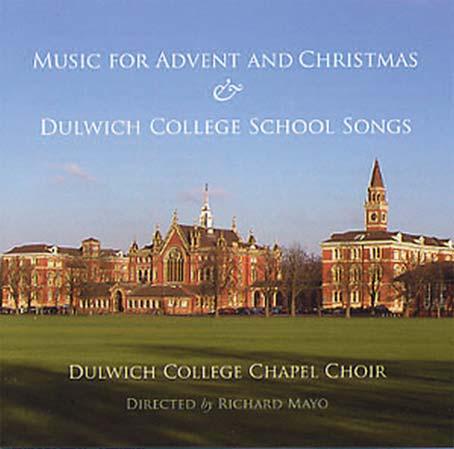
Plays Leyding, Bach, de Gruijtters, Kuhnau & Bruhns on the Great Organ in the SintPauluskerk, Antwerp.


A series of 15 programmes about Britain’s Religious Art and Architecture
Recorded in 16.9 widescreen PAL with Dolby
Digital 2.0 stereo sound

DOUBLE DISC DVD TT 366 mins
A WAGtv production
This is a really exciting package, full of superbly chosen shots, matched to a brilliantly delivered commentary by Cambridge art historian Paul Binski, who keeps up the momentum of his journey through more than 30 cathedrals, abbeys, churches, chapels, synagogues, temples and monastic ruins. His style is lively and challenging and he held my attention from the first minute of his more than 6 hours of vivid analysis.
The self-contained programmes are compiled, with their opening and closing credits left in place, so it is possible to view each one separately. Dr Binski’s story starts with the Norman invasion of England in 1066 and looks first at the Romanesque style as found at Winchester, although Durham, still with its original Norman vaulting would have been a better example. The second programme, ‘Glorious Gothic’ features Lincoln and Wells, then the third takes us to Canterbury and York and so on. Through Dr Binski’s eyes they all come alive in a new way and many fascinating works of art are also woven into the narrative. The camera-work is riveting, as visually persuasive as Binski is verbally.

One of the delights for many viewers of these architectural visits will be the specially recorded organ music, the source of which is not credited.
Priced at just a ‘tenner’ this is the best value in DVD packages anywhere. Snap it up while stocks last, you will want to play it over and over again. There is a website: www.wagtv.com with ordering details.
Roger TuckerColin Walsh
Recital programme with 15 tracks; performance notes; organ demonstration; Father Willis biography

Jackson Fanfare; Bach Prelude & Fugue in G BWV541 ; Saint-Saëns The Swan ; Langlais Incantation pour un jour saint; Howells Rhapsody No 1; Messiaen Apparition de l’église éternelle; Byrd Miserere; Bennett Elegiac
Prelude; Elgar Nimrod; Coates Dambusters March; Bach In Dulci Jubilo BWV608, Magnificat BWV733; Brahms Chorale Prelude No 11; Vierne Carillon de Longpont; Litaize Prélude et Danse Fuguée.
Recorded in 16:9 Widescreen PAL Colour 5.1 Surround Sound

DOUBLE DISC DVD & CD PRIORY PRDVD4
The most significant thing about this organ is that it is the last and some think the finest to be built by the great ‘Father’ Henry Willis. Completed in 1898 its centenary was celebrated with a major rebuild. We hear that it is now in magnificent voice at the hands of the Cathedral’s Organist Laureate, Colin Walsh, who plays a really attractive programme with his customary panache. You will enjoy one of his celebrated organ lollipops, his
arrangement of the Dambusters March, complete with cutaways of the Möhne Dam itself, along with nice shots of Lincoln. Notably relaxed, in a later section of the Bonus Tracks Mr Walsh explains the registration of selected pieces, then names the stops he is using, (we see cutaway shots in which we can read the actual stop names as he draws them) then we hear them played, enhanced by the wonderful acoustic. This is extremely well done, the sound quality is fabulous but some of the excerpts are too short, which is tantalizing!
The DVD is the ideal medium for demonstrating the art of organ registration; even if you were actually standing beside the player your attention might not be focussed so closely and you certainly could not repeat any part at will, which I did often, to reinforce the points. César Franck’s precisely specified registration makes a specially vivid example on this organ, it’s a shame none of his works is included in the main programme. The two sections which do not work as a piece to camera are the History of the Organ and the note about Father Willis, because there is virtually no cutaway material and the Organist looks uncomfortable at having to fix the camera with his eyes for so long. This is after all a video programme, there must be some documentary photographic material extant, which could add interest.
Roger TuckerAllegro Music ................................................................66
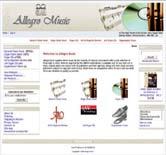


Cambridge Summer Music Festival ............................55
Campaign for the Traditional Cathedral Choir ........67
Canterbury Cathedral Voice Trials ..............................67
Canterbury Festival ......................................................47
Christ Church Cathedral School ................................62
City of London Festival ................................................19
Dulwich College ............................................................63
Edington Festival ..........................................................55
Festival of the Sons of the Clergy ..................................9
George Sixsmith Organs ..............................................65


Harrison & Harrison ....................................................30
Herald ............................................................................59
Hexham Abbey Festival ..................................................4
Incorporated Association of Organists ......................13


Makin Organs ................................................................2
Musica Deo Sacra ..........................................................9
Orgues Aubertin ..........................................................12
Oxford University Press ................................................49
Regent Records ............................................................67
Royal School of Church Music ......................................9
Salisbury Cathedral Voice Trials ..................................37
St Davids Cathedral Festival ........................................36
St John’s College, Cambridge ......................................36
St Paul’s Foundation ....................................................64
St Paul’s Cathedral Organ Recitals..............................19

Three Choirs Festival......................................................9
Viscount Classical Organs............................................45


Westminster Abbey Choir ............................................44
Westminster Abbey Summer Organ Festival ................4
Westminster Cathedral Grand Organ Festival ............44


A 40-page analysis of the cathedral music scene based on two separate, year-long monitoring projects. Its revelations are both surprising and sobering. A free copy of this paper is being offered by the Campaign to every enquirer, together with a year’s complimentary subscription to our bulletin and newsletter.
To take advantage of this offer, simply send in your request to:
David Watson
CTCC



26 Syke Green
Scarcroft
LEEDS LS14 3BS
Calne Philip Dukes Viola, David Bednall Organ Edward Whiting Director REGCD327
Volume 5 of Margaret Phillips’ on-going and critically-acclaimed cycle of the complete organ works of JS Bach, featuring the best of historic instruments. REGCD301


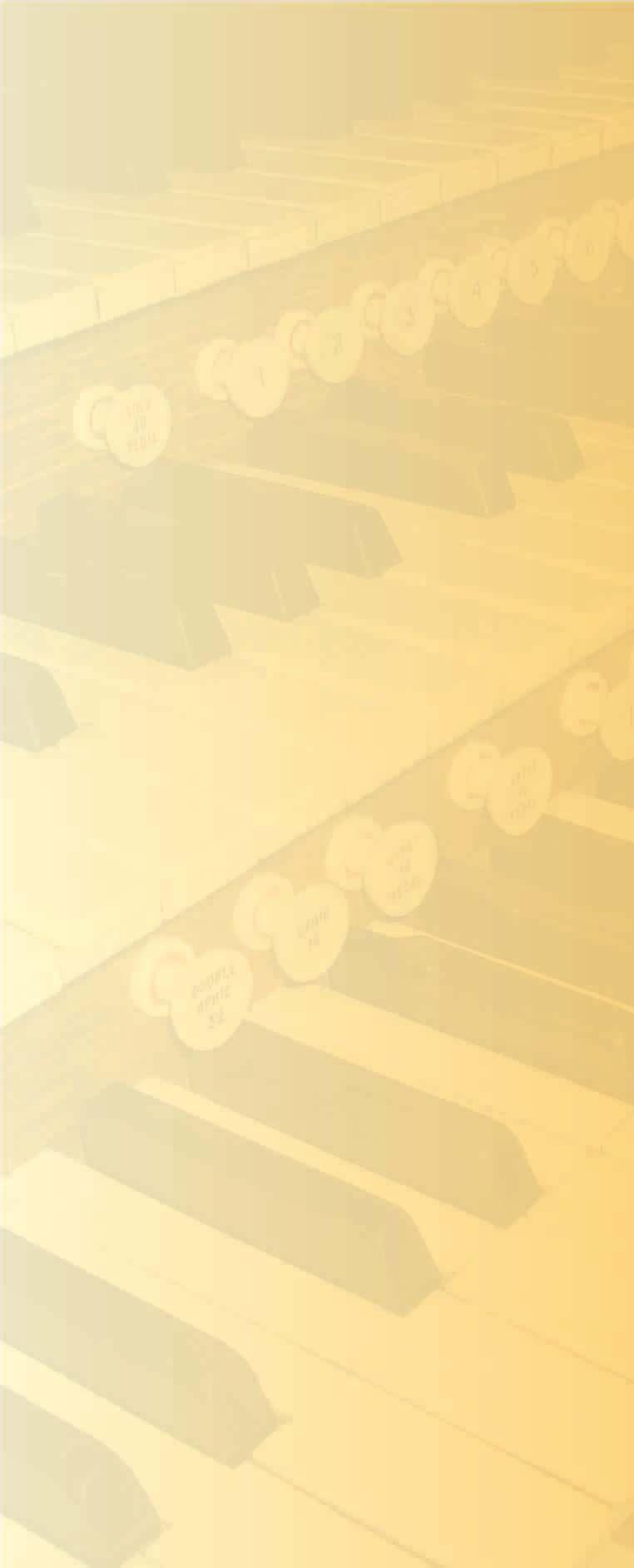
This volume includes the famous Toccata and Fugue in D minor BWV565, the ‘Dorian’ Toccata and Fugue BWV 538 and a varied selection of largeand small-scale works which form a satisfying self-contained recital of Bach’s organ music on each of the two CDs.
CD 1: 1742 Hinsz organ, Kampen, Netherlands
CD 2: 1696 Schnitger (1768 Hinsz, 1809 Freytag) organ, Noordbroek, Netherlands
Praise for Margaret Phillips’ Bach series on Regent:
‘…in terms of sheer listening pleasure, these are organ recordings par excellence…we are clearly here in the realms of a Bach series which stands proudly among the best.'International Record Review, September 2007
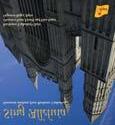
A major new recording from the Exon Singers in their first disc for Regent. Includes nine first recordings.



Some reviews of the Exon Singers’ previous recordings:
“…wonderfully full-bodied, youthful… exciting and beautiful” (Early Music America), “beautifully tailored singing” (Gramophone), “brilliant soprano sound” (The Daily Telegraph), “one is just swept along by the unabashed exuberance of the singing” (International Record Review).
“the Exons sing as to the manner born…… a real treasure” (International Record Review)

Favourite anthems from Rochester Cathedral Rochester Cathedral Choir Directors Scott Farrell and Dan Soper, Organist Roger SayerREGCD329
I was glad –Charles Hubert Parry, O God, thou art my God –Henry Purcell, It was in that train –Barry Ferguson, The Fair Chivalry –Robert Ashfield, How lovely are thy dwellings fair –Johannes Brahms, O Saviour of the world –John Goss, Zadok the priest –George Frideric Handel, Solus ad victimam –Kenneth Leighton, I give to you a new commandment –Peter Nardone, See, see, the word is incarnate –Orlando Gibbons, Sing joyfully –William Byrd, Be thou my vision –Bob Chilcott, God so loved the world –John Stainer, The Lord bless you and keep you –John Rutter, Gloria in excelsis –Charles Villiers Stanford


The 150th Anniversary of the Chapel of Exeter College, Oxford
The Chapel Choir of Exeter College, Oxford directed by Alistair Reid REGCD332

One thing have I desired – Herbert Howells, I know my soul hath power (from Songs of Farewell) – C. Hubert H. Parry, Never weather-beaten sail (from Songs of Farewell) – C. Hubert H. Parry, Behold, the tabernacle of God – William H. Harris, Magnificat for double choir, Op. 164 – Charles Villiers Stanford, Ecce beatam lucem –Jonathan Dove, The Three Kings – Jonathan Dove, Coventry Antiphon – Herbert Howells, Nunc dimittis – Gustav Holst, We have a strong city – John Gardner*

I will lift up mine eyes (new commission) – Jonathan Dove*,
In mystery veiled – Jackson Hill*, Bring us, O Lord God – William H. Harris
First recordings



